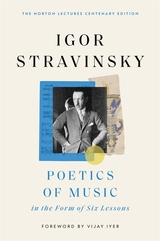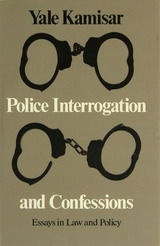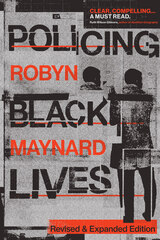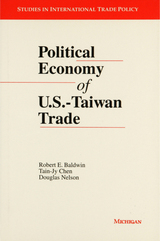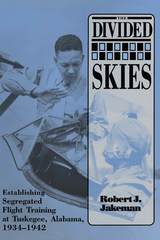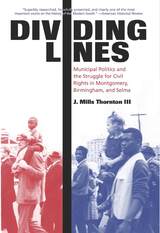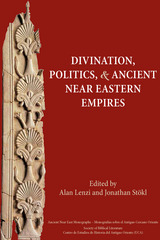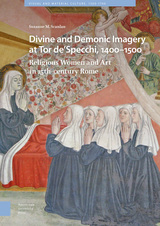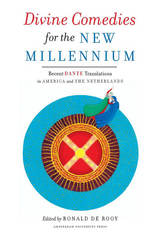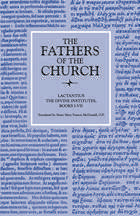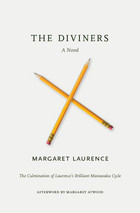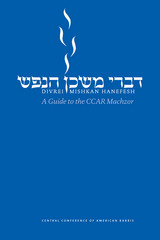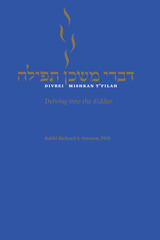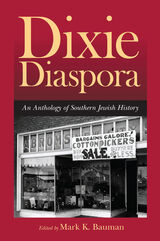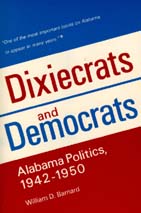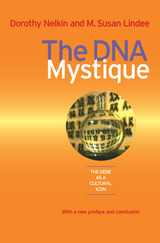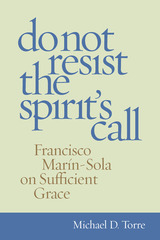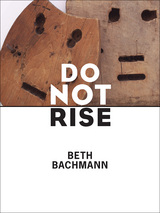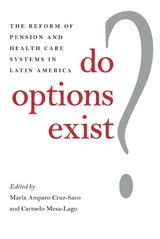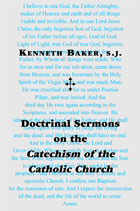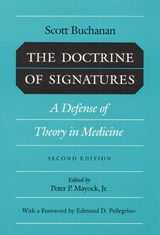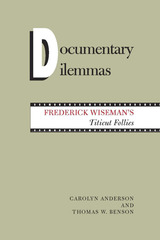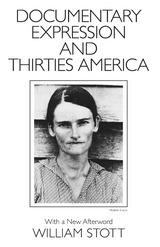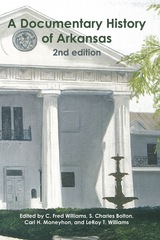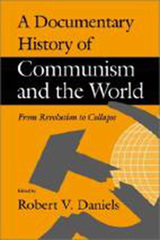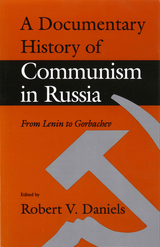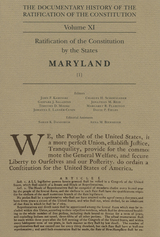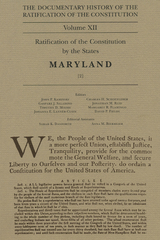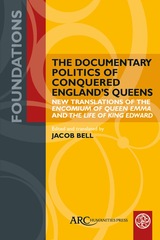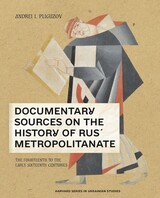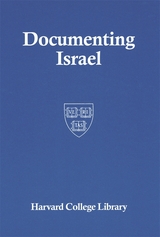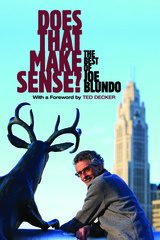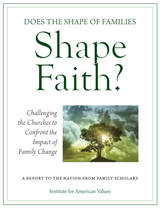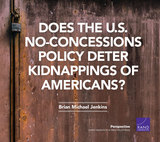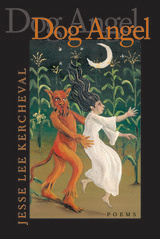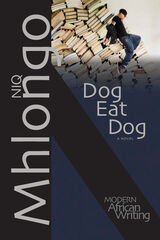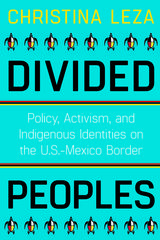 Divided Peoples: Policy, Activism, and Indigenous Identities on the U.S.-Mexico Border
Christina Leza
University of Arizona Press, 2019 The border region of the Sonoran Desert, which spans southern Arizona in the United States and northern Sonora, Mexico, has attracted national and international attention. But what is less discussed in national discourses is the impact of current border policies on the Native peoples of the region. There are twenty-six tribal nations recognized by the U.S. federal government in the southern border region and approximately eight groups of Indigenous peoples in the United States with historical ties to Mexico—the Yaqui, the O’odham, the Cocopah, the Kumeyaay, the Pai, the Apaches, the Tiwa (Tigua), and the Kickapoo.
Divided Peoples addresses the impact border policies have on traditional lands and the peoples who live there—whether environmental degradation, border patrol harassment, or the disruption of traditional ceremonies. Anthropologist Christina Leza shows how such policies affect the traditional cultural survival of Indigenous peoples along the border. The author examines local interpretations and uses of international rights tools by Native activists, counterdiscourse on the U.S.-Mexico border, and challenges faced by Indigenous border activists when communicating their issues to a broader public.
Through ethnographic research with grassroots Indigenous activists in the region, the author reveals several layers of division—the division of Indigenous peoples by the physical U.S.-Mexico border, the divisions that exist between Indigenous perspectives and mainstream U.S. perspectives regarding the border, and the traditionalist/nontraditionalist split among Indigenous nations within the United States. Divided Peoples asks us to consider the possibilities for challenging settler colonialism both in sociopolitical movements and in scholarship about Indigenous peoples and lands.
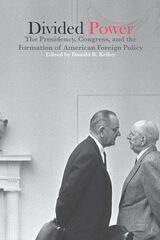 Divided Power: The Presidency, Congress, and the Formation of American Foreign Policy
Donald R. Kelley
University of Arkansas Press, 2005 Divided Power is a collection of eight original essays written for the Fulbright Institute of International Relations that focuses on timely yet unanswerable questions about the relationship between the executive and legislative branches in the formation of American foreign policy. In trying to answer questions about what the nation’s foreign policy is, and who has the upper hand in making it, these essays examine the struggle between the constant of the division of powers mandated by the Constitution (ambiguous though it may be) and the ever-changing political realities and conventional wisdoms of the day. Within that context, the authors also examine the society and culture in which those realities and wisdoms are nested. The goal of these essays is to offer a snapshot in time of the interaction of the executive and legislative branches in the shaping of our foreign policy, framed and informed by the intellectual and political realities that characterize the post–Cold War, post–September 11 world.
The Divided Skies: Establishing Segregated Flight Training at Tuskegee, Alabama, 1934-1942
Robert J. Jakeman
University of Alabama Press, 1996 In the Persian Gulf War, Americans of all races fought in integrated units under the leadership of the first African-American to serve as chairman of the Joint Chiefs of Staff. Indeed, the United States armed forces of the 1990s are arguably the most integrated institution in American society. But it was not always so.
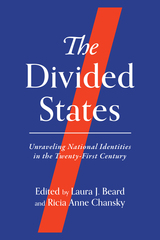 The Divided States: Unraveling National Identities in the Twenty-First Century
Edited by Laura J. Beard and Ricia Anne Chansky
University of Wisconsin Press, 2023 What is an “American” identity? The tension between populism and pluralism, between homogeneity and heterogeneity, has marked the United States since its inception. In The Divided States, leading scholars and critics argue that the US is, and has always been, a site where multiple national identities intersect in productive and challenging ways. Scrutinizing conflicting nationalisms and national identities, the authors ask, Whose stories get told and whose do not? Who or what promotes the idea of a unified national identity in the United States? How is the notion of a unified national identity disrupted? What myths and stories bind the US together? How representative are these stories? What are the counternarratives? And, if the idea of national homogeneity is a fallacy, what does tie us together as a nation?
Working across auto/biography studies, American studies, and human geography—all of which deal with the current interest in competing narratives, “alternative facts,” and accountability—the essays engage in and contribute to critical conversations in classrooms, scholarship, and the public sphere. The authors draw from a variety of fields, including anthropology; class analysis; critical race theory; diasporic, refugee, and immigration studies; disability studies; gender studies; graphic and comix studies; Indigenous studies; linguistics; literary studies; sociology; and visual culture. And the genres under scrutiny include diary, epistolary communication, digital narratives, graphic narratives, literary narratives, medical narratives, memoir, oral history, and testimony.
This fresh and theoretically engaged volume will be relevant to anyone interested in the multiplicity of voices that make up the US national narrative.
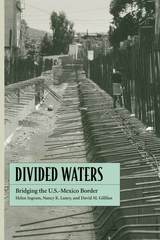 Divided Waters: Bridging the U.S.-Mexico Border
Helen Ingram, Nancy K. Laney, and David M. Gillilan
University of Arizona Press, 1995 Among all natural resource and environmental problems between the United States and Mexico, water has been the most troublesome, with ongoing historic contests over water supply becoming superseded by new controversies over water quality. Divided Waters analyzes the politics of water management along the U.S.-Mexico border, using the case of Nogales, Arizona and Nogales, Sonora as a window on the problems and possibilities involved. The authors explore the water problems that Ambos Nogales shares with larger border communities—surface and groundwater contamination, inadequate and insecure supplies, inequitable distribution of resources, flooding, and endangered riparian habitats—considering both the physical characteristics of the water supply and the coping mechanisms of the people who make use of it. They review the prevailing confusion of laws, administrative practices, and political incentives, then recommend the design elements they believe must be included before successful improvements can occur at both the institutional and the resource management levels.
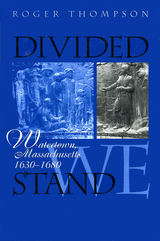 Divided We Stand: Watertown, Massachusetts, 1630-1680
Roger Thompson
University of Massachusetts Press, 2001 Established in 1630, Watertown was among the original six towns of Massachusetts. Its early history was marked by frequent disputes, a penchant for questioning authority, and an atmosphere of tension and discord. In recounting the story of Watertown's formative years, Roger Thompson examines how the community managed to avoid descending into anarchy. He also explores the ways in which English settlers preserved their habits of behavior in a new-world environment, even as they were obliged to innovate and embrace change.
Thompson describes Watertown's early government, its relations with Native Americans and neighboring communities, its religious and economic affairs, and the day-to-day experiences of its people. Conflict occurred over a wide variety of issues: land allocation, administrative accountability, religious orthodoxy and exclusivity, generational and gender differences, livestock and fencing, haves and have-nots.
Thompson brings these disputes to life through a series of vivid case studies drawn from the unpublished Middlesex County Court Records. Among others, we meet John Sawin, who despite his best efforts at subterfuge was convicted of stealing and selling a neighbor's horse; Susanna Woodward, whose pregnancy resulted in a fiercely contested paternity case; and Edward Sanders, whose punishment for child abuse was both a whipping and a ruling that when in public he must "wear a rope round his neck openly to be seen hanging down two feet."
Throughout the book, the same themes reappear: continuity and change, the persistent conflicts of the first two generations, and the countervailing forces of communal cohesion.
A Divided World: Apinaye Social Structure
Roberto Da Matta
Harvard University Press, 1982 The social structure of the Apinaye, a Central Brazilian Indian tribe, has puzzled anthropologists for forty years. Now, in this long awaited book, previously unavailable in English, Roberto Da Matta comprehensively describes Apinaye social life and the dualistic conceptual structure that underlies it. Special attention is given to the organization of daily and ceremonial life, the ideological aspects of kinship, the political system, and the confrontation between the Apinaye and the national Brazilian society.
Da Matta then enlarges his account of the Apinaye to suggest a general interpretation of Indian culture in Central Brazil. A Divided World is a major event in Brazilian ethnography and an important contribution to our general understanding of social structure.
A Divided World: Hollywood Cinema and Emigré Directors in the Era of Roosevelt and Hitler, 1933-1948
Nick Smedley
Intellect Books, 2011 The New Deal introduced sweeping social, political, and cultural change across the United States, which Hollywood embraced enthusiastically. Then, when the heady idealism of the 1930s was replaced by the paranoia of the postwar years, Hollywood became an easy target for the anticommunists. A Divided World examines some of the important programs of the New Deal and the subsequent response of the film community—especially in relation to social welfare, women’s rights, and international affairs. The book also provides an analysis of the major works of three European directors—Billy Wilder, Ernst Lubitsch, and Fritz Lang—compared and contrasted with the products of mainstream Hollywood. This is a new interpretation of an influential period in American film history and it is sure to generate further debate and scholarship.
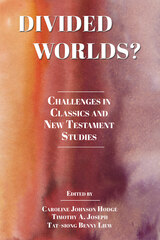 Divided Worlds? Challenges in Classics and New Testament Studies
Caroline Johnson Hodge
SBL Press, 2023 This volume brings together scholars from New Testament studies and classics, whose fields of study have much in common but are not often in in conversation. The contributors explore how the ancient works they study can be resources for thinking critically and creatively about issues that matter today. The essays address our obligation to take positive moral stands on divisive issues of both the past and the present, including empire, racial/ethnic and religious difference, economic inequality, gender and sexuality, slavery, and disability. Contributors include Douglas Boin, Denise Kimber Buell, Gay L. Byron, Allen Dwight Callahan, Joy Connolly, Jennifer A. Glancy, Shelley P. Haley, Caroline Johnson Hodge, Katherine Lu Hsu, Timothy Joseph, Tat-siong Benny Liew, Yii-Jan Lin, Dominic Machado, Joseph A. Marchal, Thomas R. Martin, Candida R. Moss, Laura Salah Nasrallah, Jorunn Økland, and Abraham Smith.
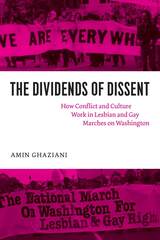 The Dividends of Dissent: How Conflict and Culture Work in Lesbian and Gay Marches on Washington
Amin Ghaziani
University of Chicago Press, 2008 Marching on Washington is a hallowed tradition of American political protest, and demonstrations led by the women’s rights, civil rights, and antiwar movements all endure in popular memory. Between 1979 and 2000 four major lesbian and gay demonstrations took place there, and while these marches were some of the largest of their time, they have been sorely overlooked—until now. Drawing on extensive archival research, historical data, original photographs, interviews with key activists, and more than a thousand news articles, The Dividends of Dissent offers a thorough analysis—descriptive, historical, and sociological—of these marches and their organization.
Amin Ghaziani ably puts these demonstrations into their cultural context, chronicling gay and lesbian life at the time and the political currents that prompted the protests. He then turns to each march in detail, focusing on the role that internal dissent played in its organization. Ultimately, Ghaziani concludes that infighting can contribute positively to the development of social movements, and that the debates over the marches helped define what it means to be gay in the United States.
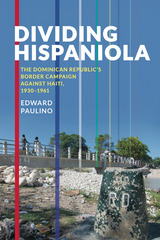 Dividing Hispaniola: The Dominican Republic's Border Campaign against Haiti, 1930-1961
Edward Paulino
University of Pittsburgh Press, 2015 The island of Hispaniola is split by a border that divides the Dominican Republic and Haiti. This border has been historically contested and largely porous. Dividing Hispaniola is a study of Dominican dictator Rafael Trujillo’s scheme, during the mid-twentieth century, to create and reinforce a buffer zone on this border through the establishment of state institutions and an ideological campaign against what was considered an encroaching black, inferior, and bellicose Haitian state. The success of this program relied on convincing Dominicans that regardless of their actual color, whiteness was synonymous with Dominican cultural identity.
Paulino examines the campaign against Haiti as the construct of a fractured urban intellectual minority, bolstered by international politics and U.S. imperialism. This minority included a diverse set of individuals and institutions that employed anti-Haitian rhetoric for their own benefit (i.e., sugar manufacturers and border officials.) Yet, in reality, these same actors had no interest in establishing an impermeable border.
Paulino further demonstrates that Dominican attitudes of admiration and solidarity toward Haitians as well as extensive intermixture around the border region were commonplace. In sum his study argues against the notion that anti-Haitianism was part of a persistent and innate Dominican ethos.
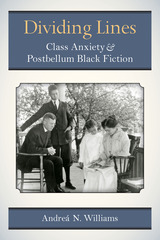 Dividing Lines: Class Anxiety and Postbellum Black Fiction
Andreá N. Williams
University of Michigan Press, 2013 One of the most extensive studies of class in nineteenth-century African American literature to date, Dividing Lines unveils how black fiction writers represented the uneasy relationship between class differences, racial solidarity, and the quest for civil rights in black communities. By portraying complex, highly stratified communities with a growing black middle class, these authors dispelled notions that black Americans were uniformly poor or uncivilized. The book argues that the signs of class anxiety are embedded in postbellum fiction: from the verbal stammer or prim speech of class-conscious characters to fissures in the fiction's form. Andreá N. Williams delves into the familiar and lesser-known works of Frances E. W. Harper, Pauline Hopkins, Charles W. Chesnutt, Sutton Griggs, and Paul Laurence Dunbar, showing how these texts mediate class through discussions of labor, moral respectability, ancestry, spatial boundaries, and skin complexion. Dividing Lines also draws on reader responses—from book reviews, editorials, and letters—to show how the class anxiety expressed in African American fiction directly sparked reader concerns over the status of black Americans in the U.S. social order. Weaving literary history with compelling textual analyses, this study yields new insights about the intersection of race and class in black novels and short stories from the 1880s to 1900s.
Dividing Lines: Municipal Politics and the Struggle for Civil Rights in Montgomery, Birmingham, and Selma
J. Mills Thornton
University of Alabama Press, 2006 Presents the story of the civil rights movement from the perspective of community-municipal history at the grassroots level
Thornton demonstrates that the movement had powerful local sources in its three birth cities—Montgomery, Birmingham, and Selma. There, the arcane mechanisms of state and city governance and the missteps of municipal politicians and civic leaders—independent of emerging national trends in racial mores—led to the great swell of energy for change that became the civil rights movement.
Dividing the Child: Social and Legal Dilemmas of Custody
Eleanor E. Maccoby and Robert H. Mnookin
Harvard University Press, 1992 Questions about how children fare in divided families have become as perplexing and urgent as they are common. In this landmark work on custody arrangements, the developmental psychologist Eleanor Maccoby and the legal scholar Robert Mnookin examine the social and legal realities of how divorcing parents make arrangements for their children.
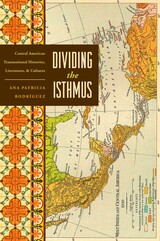 Dividing the Isthmus: Central American Transnational Histories, Literatures, and Cultures
By Ana Patricia Rodríguez
University of Texas Press, 2009 In 1899, the United Fruit Company (UFCO) was officially incorporated in Boston, Massachusetts, beginning an era of economic, diplomatic, and military interventions in Central America. This event marked the inception of the struggle for economic, political, and cultural autonomy in Central America as well as an era of homegrown inequities, injustices, and impunities to which Central Americans have responded in creative and critical ways. This juncture also set the conditions for the creation of the Transisthmus—a material, cultural, and symbolic site of vast intersections of people, products, and narratives. Taking 1899 as her point of departure, Ana Patricia Rodríguez offers a comprehensive, comparative, and meticulously researched book covering more than one hundred years, between 1899 and 2007, of modern cultural and literary production and modern empire-building in Central America. She examines the grand narratives of (anti)imperialism, revolution, subalternity, globalization, impunity, transnational migration, and diaspora, as well as other discursive, historical, and material configurations of the region beyond its geophysical and political confines. Focusing in particular on how the material productions and symbolic tropes of cacao, coffee, indigo, bananas, canals, waste, and transmigrant labor have shaped the transisthmian cultural and literary imaginaries, Rodríguez develops new methodological approaches for studying cultural production in Central America and its diasporas. Monumental in scope and relentlessly impassioned, this work offers new critical readings of Central American narratives and contributes to the growing field of Central American studies.
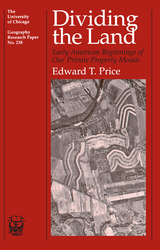 Dividing the Land: Early American Beginnings of Our Private Property Mosaic
Edward T. Price
University of Chicago Press, 1995 Many property lines drawn in early America still survive today and continue to shape the landscape and character of the United States. Surprisingly, though, no one until now has thoroughly examined the process by which land was divided into private property and distributed to settlers from the beginning of colonization to early nationhood.
In this unprecedented study, Edward T. Price covers most areas of the United States in which the initial division of land was controlled by colonial governments—the original thirteen colonies, and Maine, Vermont, Kentucky, West Virginia, Tennessee, Louisiana, and Texas. By examining different land policies and the irregular pattern of property that resulted from them, Price chronicles the many ways colonies managed land to promote settlement, develop agriculture, defend frontiers, and attract investment. His analysis reveals as much about land planning techiniques carried to America from Europe as innovations spurred by the unique circumstances of the new world.
Price’s analysis draws on his thorough survey of property records from the first land plans in Virginia in 1607 to empresario grants in Texas in the 1820s. This breadth of data allows him to identify regional differences in allocating land, assess the impact of land planning by historical figures like William Penn of Pennsylvania and Lord Baltimore of Maryland, and trace changes in patterns of land division and ownership through transfers of power among Britain, the Netherlands, France, Spain, Mexico, and the Republic of Texas.
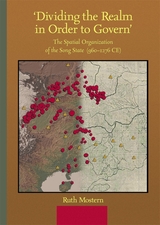 ‘Dividing the Realm in Order to Govern’: The Spatial Organization of the Song State (960–1276 CE)
Ruth Mostern
Harvard University Press, 2011 States are inherently and fundamentally geographical. Sovereignty is based on control of territory. This book uses Song China to explain how a pre-industrial regime organized itself spatially in order to exercise authority. On more than a thousand occasions, the Song court founded, abolished, promoted, demoted, and reordered jurisdictions in an attempt to maximize the effectiveness of limited resources in a climate of shifting priorities, to placate competing constituencies, and to address military and economic crises. Spatial transformations in the Song field administration changed the geography of commerce, taxation, revenue accumulation, warfare, foreign relations, and social organization, and even determined the terms of debates about imperial power.
The chronology of tenth-century imperial consolidation, eleventh-century political reform, and twelfth-century localism traced in this book is a familiar one. But by detailing the relationship between the court and local administration, this book complicates the received paradigm of Song centralization and decentralization. Song frontier policies formed a coherent imperial approach to administering peripheral regions with inaccessible resources and limited infrastructure. And the well-known events of the Song—wars and reforms—were often responses to long-term spatial and demographic change.
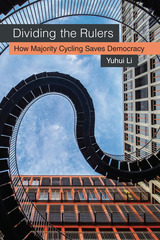 Dividing the Rulers: How Majority Cycling Saves Democracy
Yuhui Li
University of Michigan Press, 2019 The election of populist politicians in recent years seems to challenge the commitment to democracy, if not its ideal. This book argues that majority rule is not the problem; rather, the institutions that stabilize majorities are responsible for the suppression of minority interests. Despite the popular notion that social choice instability (or “cycling”) makes it impossible for majorities to make sound legislation, Yuhui Li argues that the best part of democracy is not the large number of people on the winning side; it is that the winners can be easily divided and realigned with the losers in the cycling process. He shows that minorities’ bargaining power depends on their ability to exploit division within the winning coalition and induce its members to defect, an institutionalized uncertainty that is missing in one-party authoritarian systems.
Dividing the Rulers theorizes why such division within the majority is important and what kind of institutional features can help a democratic system maintain such division, which is crucial in preventing the “tyranny of the majority.” These institutional solutions point to a direction of institutional reform that academics, politicians, and voters should collectively pursue.
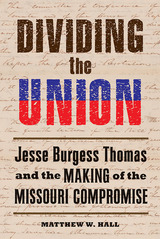 Dividing the Union: Jesse Burgess Thomas and the Making of the Missouri Compromise
Matthew W. Hall
Southern Illinois University Press, 2015 Winner, ISHS Superior Achievement Award for a Scholarly Publication, 2016
In 1820 the Missouri controversy erupted over the issue of slavery in the newly acquired lands of the Louisiana Purchase. It fell to Jesse Burgess Thomas (1777–1853), a junior U.S. senator from the new state of Illinois, to handle the delicate negotiations that led to the Missouri Compromise. Thomas’s maturity, good judgment, and restraint helped pull the country back from the brink of disunion and created a compromise that held for thirty-four years. In Dividing the Union, Matthew W. Hall examines the legal issues underlying the controversy and the legislative history of the Missouri Compromise while focusing on the aspects of Thomas’s life and character that gave him such influence. The first in-depth biography of Thomas, Hall’s work demonstrates how the legislative battle over the Compromise reflected the underlying nuances of the larger struggle over slavery.
The text of the Missouri Compromise originated from the Northwest Ordinance. Article VI of the Ordinance purported to prohibit slavery in the Northwest Territory, but paradoxically, a provision that assured property rights in another article was used to protect slavery. People in some parts of the Northwest sought to circumvent Article VI by formulating indenture laws and various state constitutional provisions addressing slavery. Pro- and antislavery activists eventually developed quite different interpretations of the relevant language in these documents, making negotiations over slavery in the new territory extremely complicated.
As Hall demonstrates, Thomas was perfectly situated geographically, politically, and ideologically to navigate the Missouri controversy. He was the first speaker of the Indiana Territorial General Assembly, one of the first territorial judges in the Illinois Territory, and the president of the Illinois State Constitutional Convention in 1818. Because the drive for statehood in Illinois was strong, the convention managed to skirt the divisive issue of slavery, due in large part to Thomas’s efforts. That he was never required to clearly articulate his own views on slavery allowed Thomas to maintain a degree of neutrality, and his varied political career gave him the experience necessary to craft a compromise.
Thomas’s final version of the Compromise included shrewdly worded ambiguities that supported opposing interests in the matter of slavery. These ambiguities secured the passage of the Compromise and its endurance until the Kansas-Nebraska Act of 1854. By weaving Thomas’s life story into the history of the Missouri Compromise, Hall offers new insight into both a pivotal piece of legislation and an important, previously overlooked figure in nineteenth-century American politics.
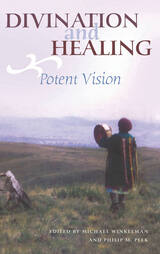 Divination and Healing: Potent Vision
Edited by Michael Winkelman and Philip M. Peek
University of Arizona Press, 2004 Divination is an important feature of cultures all over the world. While some may still question the efficacy of divination systems, they continue to serve their communities by diagnosing ailments, prescribing healing treatments, and solving problems. Yet despite their universality, there are relatively few comprehensive studies of divination systems. This volume seeks to fill this gap regarding the use of divination in healing. Here some of the world’s leading authorities draw on their own fieldwork and participation in ritual to present detailed case studies, demonstrating that divination rituals can have therapeutic effects. As the contributors examine the systems of knowledge that divination articulates and survey the varieties of divinatory experience, they seek to analyze divination as an epistemological system, as a social process, and as a therapeutic endeavor. While some of their findings reinforce traditional assumptions about the importance of social control, spirit relations, and community support in the divination process, the authors place these considerations within new epistemological frameworks that emphasize the use of alternative modes of knowing. In this wide-ranging volume, readers will find coverage of classic Ifa systems; Buddhist-influenced shamanic practices in the former Soviet Union; the reconciliation of Muslim beliefs and divinatory practices in Thailand; Native American divination used in diagnosis; Maya calendrical divination in Guatemala; mediumistic and chicken oracle divination among the Sukuma of Tanzania; Ndembu divination, focusing on the process of collective healing; and divination among the Samburu (Maasai) of Kenya, featuring dialogues from actual healing sessions. Together, these contributions argue for new perspectives on the study of divination that emphasize not only the epistemological roots of these systems but also their multifaceted therapeutic functions. Divination and Healing is a rich source of both data and insight for scholars of ritual, religion, medical anthropology, and the psychology of altered states of consciousness.
 Divination Engines: Natural Language Processing, Artificial Intelligence, and the Making of Algorithmic Culture
Xiaochang Li
University of Chicago Press A revealing and surprising origin story, showing how attempts to render human speech and language computable led from the era of big data to today’s AI.
Since the advent of computers, society has fantasized about conversing with machines. In this eye-opening book, technology expert Xiaochang Li shows readers how that dream both fueled the demand for data and set the stage for today’s generative AI. With original research and clear explanations, Li elucidates the origins of what’s known as natural language processing (NLP) and the heated twentieth-century debates between computer scientists, linguists, and communication engineers that shaped today’s technology. Starting with early devices that recorded, analyzed, and attempted to interpret human speech, she demonstrates how computer speech recognition, particularly efforts led by Bell Labs and IBM, advanced technology by deemphasizing linguistic meaning in favor of statistical prediction. In other words, researchers gradually abandoned systems that sought to understand human language, opting instead for workarounds that simply predicted patterns in speech and text data. That solution became incredibly and surprisingly adaptable. As Li reveals, transforming linguistic questions into engineering ones ushered in the routine operation of search engines, spam filters, and the varied content sorting and recommendation mechanisms that regulate the access, circulation, and legitimacy of information across every platform. But this has all come at the cost of forever requiring copious and ever-growing amounts of new data.
At its core, Divination Engines illuminates how the artifacts of human communication—speech, text, and images—have become both the fodder for and products of computers. This connection, between communication and computation, Li shows, has given rise to data-driven analytics, machine learning, and today’s algorithmic culture.
Divination, Politics, and Ancient Near Eastern Empires
Alan Lenzi
SBL Press, 2014 Advance your understanding of divination’s role in supporting or undermining imperial aspirations in the ancient Near East
This collection examines the ways that divinatory texts in the Hebrew Bible and the ancient Near East undermined and upheld the empires in which the texts were composed, edited, and read. Nine essays and an introduction engage biblical scholarship on the Prophets, Assyriology, the Dead Sea Scrolls, and the critical study of Ancient Empires.
Features:
- Interdisciplinary approaches include propaganda studies
- Essays examine how biblical and other ancient Near Eastern texts were shaped by political and theological empires
- Index of ancient sources
Divine and Demonic Imagery at Tor de'Specchi, 1400-1500: Religious Women and Art in 15th-century Rome
Suzanne M. Scanlan
Amsterdam University Press, 2018 In the fifteenth century, the Oblates of Santa Francesca Romana, a fledgling community of religious women in Rome, commissioned an impressive array of artwork for their newly acquired living quarters, the Tor de'Specchi. The imagery focused overwhelmingly on the sensual, corporeal nature of contemporary spirituality, populating the walls of the monastery with a highly naturalistic assortment of earthly, divine, and demonic figures. This book draws on art history, anthropology, and gender studies to explore the disciplinary and didactic role of the images, as well as their relationship to important papal projects at the Vatican.
 Divine Beauty: The Aesthetics of Charles Hartshorne
Daniel A. Dombrowski
Vanderbilt University Press, 2004 Considered by many to be one of the greatest philosophers of religion and metaphysicians of the twentieth century, Charles Hartshorne (1897-2000) addressed questions of aesthetics throughout his long career. Yet his efforts in this area are perhaps the most neglected aspect of his extensive and highly nuanced thought. Divine Beauty offers the first detailed explication of Hartshorne's aesthetic theory and its place within his theocentric philosophy. As Daniel A. Dombrowski explains, Hartshorne advanced a neoclassical or process theism that contrasted with the "classical" theism defended by traditionalist Jews, Christians, and Muslim believers. His conception of God was dipolar, which could attribute to God certain qualities that traditionalists would exclude. For example, in Hartshorne's view, God can embrace excellent aspects of both activity and passivity, or of permanence and change; classical theists, on the other hand, exclude passivity and change from their conceptions. Dombrowski goes on to explain the ramifications of Hartshorne's view of God for aesthetics, which for him had both broad and narrow meanings: all sensory feeling or sensation, in the broad sense, and a disciplined feeling for beauty, in the narrow sense. Included are discussions on Hartshorne's famous appreciation for the aesthetics of bird song; his view of beauty as a mean between two sets of extremes; his idea of the aesthetic attitude, which concentrates on values that are intrinsic and immediately felt; and the place of death in his aesthetics, in which the value of our lives consists in the beauty or intensity of experience that we contribute to the divine life. Filling an important gap in our understanding of Hartshorne, Divine Beauty also makes a persuasive case for the superiority of his neoclassical theism over classical theism.
Divine Comedies for the New Millennium
Edited by Ronald de Rooy
Amsterdam University Press, 2003 The difficulty of translating Dante has, paradoxically, created a steady of flux of translations. Around the year 2000, seven cantiche were translated by Dutchmen and seven by Americans, giving rise to a seminar on the state and tradition of translating Dante in both countries. In the course of discussing these landmark translations, contributors to this volume inevitably make statements about how Dante's masterpiece should be read: as a poem, to be translated fearlessly and confrontationally; as a scholarly text, to be treated cautiously and rigorously; or as some combination of the two?
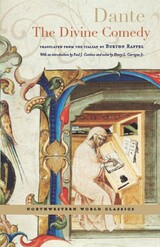 The Divine Comedy
Dante Alighieri; Translated from the Italian by Burton Raffel with an Introduction by Paul J. Contino and notes by Henry L. Carrigan Jr.
Northwestern University Press, 2010 At the midpoint of his life, during Holy Week in 1300, Dante awakes to himself in the middle of a forest so dark that the sun’s light cannot penetrate its gloom. of the wildness and brutality of the woods, Dante cries out for help, and thus begins one of Western literature’s greatest epic journeys.
The Divine Comedy follows Dante the pilgrim—guided by the great Roman poet Virgil, then by the love of his life, Beatrice—as he travels downward through Hell, then upward through Purgatory in order to reach Paradise and witness the love that moves the sun and the stars. Raffel’s translation vividly captures the divine contrapasso, the ultimate case of the punishment the crime, in the Inferno, while fathoming the complexity of the Purgatorio and the ecstasy of the Paradiso.
One of the world’s greatest works of literature, Dante’s Commedia revolutionized poetry and the Italian language. This epic poem was the to be written in the vernacular of the Italian people rather than in Latin. In it, Dante weaves the best of classical literature from Virgil, Statius, Aristotle, and Ovid with staples from the Christian tradition (including the Scriptures, Augustine, and Aquinas), into a colorful medieval tapestry that depicts at once the vividly checkered history of church and empire.
 Divine Days: A Novel
Leon Forrest; Foreword by Kenneth W. Warren, Preface by Zachary Price
Northwestern University Press, 2023 A virtuosic epic applauded by Stanley Crouch as “an adventurous masterwork that provides our literature with a signal moment,” back in print in a definitive new edition
“I have an awful memory for faces, but an excellent one for voices,” muses Joubert Jones, the aspiring playwright at the center of Divine Days. A kaleidoscopic whorl of characters, language, music, and Black experience, this saga follows Jones for one week in 1966 as he pursues the lore and legends of fictional Forest County, a place resembling Chicago’s South Side. Joubert is a veteran, recently returned to the city, who works for his aunt Eloise’s newspaper and pours drinks at her Night Light Lounge. He wants to write a play about Sugar-Groove, a drifter, “eternal wunderkind,” and local folk hero who seems to have passed away. Sugar-Groove’s disappearance recalls the subject of one of Joubert’s earlier writing attempts—W. A. D. Ford, a protean, diabolical preacher who led a religious sect known as “Divine Days.” Joubert takes notes as he learns about both tricksters, trying to understand their significance.
Divine Days introduces readers to a score of indelible characters: Imani, Joubert’s girlfriend, an artist and social worker searching for her lost siblings and struggling to reconcile middle class life with her values and Black identity; Eloise, who raised Joubert and whose influence is at odds with his writerly ambitions; (Oscar) Williemain, a local barber, storyteller, and founder of the Royal Rites and Righteous Ramblings Club; and the Night Light’s many patrons. With a structure inspired by James Joyce and jazz, Leon Forrest folds references to African American literature and cinema, Shakespeare, the Bible, and classical mythology into a heady quest that embraces life in all its tumult and adventure.
This edition brings Forrest’s masterpiece back into print, incorporating hundreds of editorial changes that the author had requested from W. W. Norton, but were not made for their editions in 1993 and 1994. Much of the inventory from the original printing of the book by Another Chicago Press in 1992 had been destroyed in a disastrous warehouse fire.
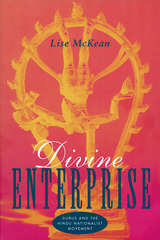 Divine Enterprise: Gurus and the Hindu Nationalist Movement
Lise McKean
University of Chicago Press, 1996 Through shrewd marketing and publicity, Hindu spiritual leaders can play powerful roles in contemporary India as businessmen and government officials. Focusing on the organizations and activities of Hindu ascetics and gurus, Lise McKean explores the complex interrelations among religion, the political economy of India, and global capitalism.
In this close look at the business of religion, McKean traces the ideological and organizational antecedents to the Hindu nationalist movement. The Indian state's increasing patronage of Hindu institutions makes competition for its support greater than ever. Using materials from guru's publications, the press, and extensive field research, McKean examines how participation by upper-caste ruling class groups in the Divine Life Society and other Hindu organizations further legitimates their own authority.
With a remarkable selection of photographs and advertisements showing icons of spirituality used to sell commodities from textiles to cement to comic books, McKean illustrates the pervasive presence of Hindu imagery in India's burgeoning market economy. She shows how gurus popularize Hindu nationalism through imagery such as the goddess, Mother India, and her martyred sons and daughters.
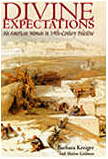 Divine Expectations: An American Woman In Nineteenth-Century Palestine
Barbara Kreiger
Ohio University Press, 1999 Barbara Kreiger’s intriguing narrative presents the account of Clorinda Minor, a charismatic American Christian woman whose belief in the Second Coming prompted her to leave a comfortable life in Philadelphia in 1851 and take up agriculture in Palestine.
After her disappointment in a failed prophecy that the End of Days would take place in October 1844, Mrs. Minor determined that the Holy Land was not yet adequately prepared for such an event and decided that it would be her mission to teach the poverty-stricken Jews of Palestine to work the soil. In this very American story, Mrs. Minor, like so many other pioneers of her day, looked to the land as her future.
Even as her mission was distinctly religious, her daily efforts were in the social realm. And although her work brought Jews and Arabs together, and her small farm was a unique settlement where Christians, Muslims, and Jews labored alongside one another, the events detailed in Divine Expectations had dramatic and tragic diplomatic and international repercussions.
With the deft touch of a novelist, Barbara Kreiger weaves the little-known story of Clorinda Minor into the larger context of the region and its history, presenting it in its charming eccentricity and its gripping reality.
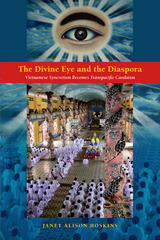 The Divine Eye and the Diaspora: Vietnamese Syncretism Becomes Transpacific Caodaism
Janet Hoskins
University of Hawaii Press, 2015 Caodaism is a new religion born in Vietnam during the struggles of decolonization, shattered and spatially dispersed by cold war conflicts, now trying to reshape the goals of its four million followers. Colorful and strikingly syncretistic, it incorporates elements of Chinese, Buddhist, and Western religions as well as more recent outstanding world figures like Victor Hugo, Jeanne d’Arc, Vladimir Lenin, and (in the United States) Joseph Smith, the founder of Mormonism. The book looks at the connections between “the age of revelations” (1925–1934) in French Indochina and the “age of diaspora” (1975–present) when many Caodai leaders and followers went into exile. Structured in paired biographies to trace relations between masters and disciples, now separated by oceans, it focuses on five members of the founding generation and their followers or descendants in California, showing the continuing obligation to honor those who forged the initial vision to “bring the gods of the East and West together.” The syncretism of the colonial period has been transformed by the experience of exile into a diasporic formation, at the same time that Caodaism in Vietnam has emerged from a period of severe restrictions to return to the public arena. Caodaism forces us to reconsider how anthropologists study religious mixtures in postcolonial settings, since its dynamics challenge the unconscious Eurocentrism of our notions of how religions are bounded and conceptualized.
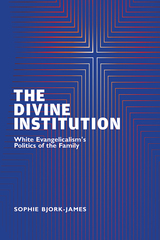 The Divine Institution: White Evangelicalism's Politics of the Family
Sophie Bjork-James
Rutgers University Press, 2021 The Divine Institution provides an account of how a theology of the family came to dominate a white evangelical tradition in the post-civil rights movement United States, providing a theological corollary to Religious Right politics. This tradition inherently enforces racial inequality in that it draws moral, religious, and political attention away from problems of racial and economic structural oppression, explaining all social problems as a failure of the individual to achieve the strong gender and sexual identities that ground the nuclear family. The consequences of this theology are both personal suffering for individuals who cannot measure up to prescribed gender and sexual roles, and political support for conservative government policies. Exposure to experiences that undermine the idea that an emphasis on the family is the solution to all social problems is causing a younger generation of white evangelicals to shift away from this narrow theological emphasis and toward a more social justice-oriented theology. The material and political effects of this shift remain to be seen.
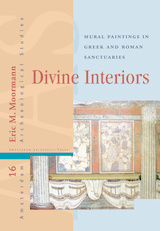 Divine Interiors: Mural Paintings in Greek and Roman Sanctuaries
Eric M. Moormann
Amsterdam University Press, 2012 Divine Interiors is an investigation into the decoration of Greek and Roman temples with wall paintings. Mighty marble facades, sculptures and paintings played an important role in relation to these monuments. While the official temples, which were connected to the city or state, usually had a simple but solemn appearance, the more popular buildings were true multi-color expressions of religiosity. Scenes from the life of the revered deity, supporters and practitioners of the cult, or of plants and animals could carry visitors of the shrines away to different worlds. It is also striking to find in the vast Greco-Roman world that there are many similarities between often widely separated temples. The wall paintings were characterized by stylistic and taste changes, but they had the same look everywhere. Besides using archeological remains, this book also uses the texts of antiquity, whose descriptions of the monuments provide additional information.
Amsterdam Archaeological Studies is a series devoted to the study of past human societies from the prehistory up into modern times, primarily based on the study of archaeological remains. The series will include excavation reports of modern fieldwork; studies of categories of material culture; and synthesising studies with broader images of past societies, thereby contributing to the theoretical and methodological debates in archaeology.
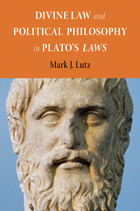 Divine Law and Political Philosophy in Plato's Laws
Mark J. Lutz
Northern Illinois University Press, 2012
All over the world secular rationalist governments and judicial authorities have been challenged by increasingly forceful claims made on behalf of divine law. For those who believe that reason—not faith—should be the basis of politics and the law, proponents of divine law raise theoretical and practical concerns that must be addressed seriously and respectfully. As Mark J. Lutz makes plain in this illuminating book, they have an important ally in Plato, whose long neglected Laws provides an eye-opening analysis of the relation between political philosophy and religion and a powerful defense of political rationalism.
Plato mounts his case, Lutz reveals, through a productive dialogue between his Athenian Stranger and various devout citizens that begins by exploring the common ground between them, but ultimately establishes the authority of rational political philosophy to guide the law. The result will fascinate not only political theorists but also scholars at all levels with an interest in the intersection of religion and politics or in the questions that surround ethics and civic education.
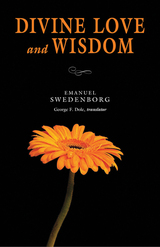 Divine Love and Wisdom: The Portable New Century Edition
Emanuel Swedenborg
Swedenborg Foundation Publishers, 2010 Divine Love and Wisdom has been called the most profound work of the Enlightenment scientist and seer Emanuel Swedenborg. It demonstrates how God’s love, wisdom, and humanity are reflected in creation and in ourselves, and suggests that the act of Creation is not a mystery of the past, but a miracle ongoing in every instant of the present. Like a blueprint of things unseen, Divine Love and Wisdom makes visible the hidden design of the universe, as well as the qualities of its Architect. Its vivid depiction of the spiritual mechanism of the world has impressed thinkers such as William Blake, Samuel Taylor Coleridge, Ralph Waldo Emerson, and Henry James, Sr. The New Century Edition of the Works of Emanuel Swedenborg is a modern-language, scholarly translation of Swedenborg’s theological works. The series’ easy-to-read style retains the dignity, variety, clarity, and gender-inclusive language of Swedenborg’s original Latin, bringing his thought to life. This portable edition contains the text of the New Century Edition translation, but not the introduction, annotations, or other supplementary materials found in the deluxe edition.
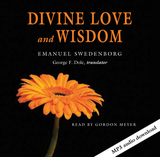 Divine Love and Wisdom: The Portable New Century Edition
Emanuel Swedenborg
Swedenborg Foundation Publishers Divine Love and Wisdom has been called the most profound work of the Enlightenment scientist and seer Emanuel Swedenborg. It demonstrates how God’s love, wisdom, and humanity are reflected in creation and in ourselves, and suggests that the act of Creation is not a mystery of the past, but a miracle ongoing in every instant of the present. Like a blueprint of things unseen, Divine Love and Wisdom makes visible the hidden design of the universe, as well as the qualities of its Architect. Its vivid depiction of the spiritual mechanism of the world has impressed thinkers such as William Blake, Samuel Taylor Coleridge, Ralph Waldo Emerson, and Henry James, Sr. The New Century Edition of the Works of Emanuel Swedenborg is a modern-language, scholarly translation of Swedenborg’s theological works. The series’ easy-to-read style retains the dignity, variety, clarity, and gender-inclusive language of Swedenborg’s original Latin, bringing his thought to life. This portable edition contains the text of the New Century Edition translation, but not the introduction, annotations, or other supplementary materials found in the deluxe edition.
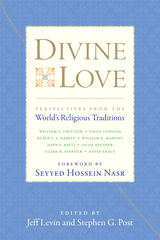 Divine Love: Perspectives from the World's Religious Traditions
Jeff Levin
Templeton Press, 2010 The contributors to Divine Love cover a broad spectrum of world religions, comparing and contrasting approaches among Christians of several denominations, Jews, Buddhists, Muslims, Hindus, and adherents of traditional African religions. Each chapter focuses on the definition and conceptual boundaries of divine love; its expression and experience; its instrumentality and salience; how it can become distorted, and how it has been made manifest or restored by great historic exemplars of altruism, compassion, and unlimited love. The ultimate aim for many of the world’s major faith traditions is to love and be loved by God—to live in connection with the Divine, in union with the Beloved, in reconciliation with the Ultimate. Religious scholars Jeff Levin and Stephen G. Post have termed this connection “divine love.” In their new collection of the same name, they have invited eight of the world’s preeminent religious scholars to share their perspectives on the what, how, and why of divine love. From this diverse gathering of perspectives emerges evidence that to love and to be loved by God, to enter into a mutual and covenantal relationship with the Divine, may well offer solutions to many of the current crises around the world. Only a loving relationship with the Source of being within the context of the great faith and wisdom traditions of the world can fully inform and motivate the acts of love, unity, justice, compassion, kindness, and mercy for all beings that are so desperately required to counter the toxic influences in the world. Contributors: William C. Chittick, Vigen Guroian, Ruben L. F. Habito, William K. Mahony, John S. Mbiti, Jacob Neusner, Clark H. Pinnock, and David Tracy.
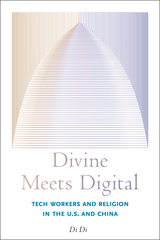 Divine Meets Digital: Tech Workers and Religion in the U.S. and China
Di Di
Rutgers University Press, 2026 What role does religion play in the tech industry? Based on nearly one hundred interviews, Divine Meets Digital uncovers the ways tech workers engage with religion and make sense of their work through religious and spiritual worldviews. While most identify as nonreligious, they are far from anti-religious. Instead, they navigate competing religious and nonreligious views, often distinguishing between what they see as the controversial elements of religion—such as belief in the supernatural in China and its politicized and dogmatic aspects in the United States—and its more noncontroversial aspects. In doing so, they justify their religious engagement by embracing religion's noncontroversial elements while distancing themselves from its controversial features. This book offers a powerful new lens for understanding one of the most influential industries of our time, inviting readers to better understand the people who live and work at the intersection between science, religion, and technology.
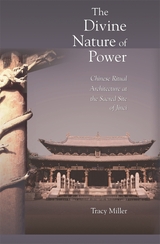 The Divine Nature of Power: Chinese Ritual Architecture at the Sacred Site of Jinci
Tracy Miller
Harvard University Press, 2007 Built around three sacred springs, the Jin Shrines complex (Jinci), near Taiyuan in Shanxi province, contains a wealth of ancient art and architecture dating back to the Northern Song dynasty (960-1127). The complex's 1,500-year-long textual record allows us to compare physical and written evidence to understand how the built environment was manipulated to communicate ideas about divinity, identity, and status. Jinci's significance varied over time according to both its patrons' needs and changes in the political and physical landscape. The impact of these changes can be read in the physical development of the site.
Using an interdisciplinary approach drawing on the research of archaeologists, anthropologists, and religious, social, and art historians, this book seeks to recover the motivations behind the creation of religious art, including temple buildings, sculpture, and wall paintings. Through an examination of building style and site organization, the author illuminates the multiplicity of meanings projected by buildings within a sacred landscape and the ability of competing patronage groups to modify those meanings with text and context, thereby affecting the identity of the deities housed within them. This study of the art and architecture of Jinci is thus about divine creations and their power to create divinity.
 Divine Presence in Spain and Western Europe 1500–1960: Visions, Religious Images and Photographs
William A. Christian Jr.
Central European University Press, 2012 This study addresses the relation of people to divine beings in contemporary and historical communities, as exemplified in three strands. One is a long tradition of visions of mysterious wayfarers in rural Spain who bring otherworldly news and help, including recent examples. Another treats the seeming vivification of religious images—statues, paintings, engravings, and photographs apparently exuding blood, sweat and tears in Spanish homes and churches in the early modern period and the revival of the phenomenon throughout Europe in the twentieth century. Of special interest is the third strand of the book: the transposition of medieval and early modern representations of the relations between humans and the divine into the modern art of photography. Christian presents a pictorial examination of the phenomenon with a large number of religious images, commercial postcards and family photographs from the first half of past century Europe.
 Divine Providence: The Portable New Century Edition
Emanuel Swedenborg
Swedenborg Foundation Publishers, 2010 Divine Providence is one of the major works of the Enlightenment scientist and religious seer Emanuel Swedenborg. It provides a coherent and satisfying solution to what has been called “the problem of evil”: How are God’s goodness and power reconcilable with evil’s presences in the larger world and in the human mind and heart? By tackling an array of issues that commonly undermine belief in God, including war, suffering, and inequality—and by revealing the wise and loving laws that lie hidden behind these seemingly senseless phenomena—Divine Providence aims to restore our faith in the meaningfulness of the world. Despite its universal focus, Divine Providence is also a highly practical book on the personal level, demonstrating how we can put aside negative attitudes and behaviors and grow into positive thought and action.
The New Century Edition of the Works of Emanuel Swedenborg is a modern-language, scholarly translation of Swedenborg’s theological works. The series’ easy-to-read style retains the dignity, variety, clarity, and gender-inclusive language of Swedenborg’s original Latin, bringing his thought to life. This portable edition contains the text of the New Century Edition translation, but not the introduction, annotations, or other supplementary materials found in the deluxe editions.
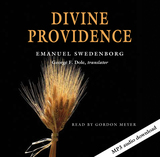 Divine Providence: The Portable New Century Edition
Emanuel Swedenborg
Swedenborg Foundation Publishers, 2010 Divine Providence is one of the major works of the Enlightenment scientist and religious seer Emanuel Swedenborg. It provides a coherent and satisfying solution to what has been called “the problem of evil”: How are God’s goodness and power reconcilable with evil’s presences in the larger world and in the human mind and heart? By tackling an array of issues that commonly undermine belief in God, including war, suffering, and inequality—and by revealing the wise and loving laws that lie hidden behind these seemingly senseless phenomena—Divine Providence aims to restore our faith in the meaningfulness of the world. Despite its universal focus, Divine Providence is also a highly practical book on the personal level, demonstrating how we can put aside negative attitudes and behaviors and grow into positive thought and action.
The New Century Edition of the Works of Emanuel Swedenborg is a modern-language, scholarly translation of Swedenborg’s theological works. The series’ easy-to-read style retains the dignity, variety, clarity, and gender-inclusive language of Swedenborg’s original Latin, bringing his thought to life. This portable edition contains the text of the New Century Edition translation, but not the introduction, annotations, or other supplementary materials found in the deluxe editions.
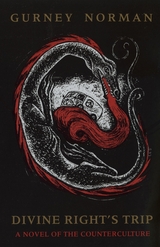 Divine Right's Trip: A Novel of the Counterculture
Gurney Norman
Ohio University Press, 1990 This first Gnomon Press edition was published in 1990. Divine Right’s Trip is a countercultural classic that captures the spirit of the 1960s and early 1970s. The novel follows Divine Right (D. R.) Davenport, a restless young man on a journey of self-discovery, as he embarks on a cross-country road trip in his beloved but unreliable old Volkswagen bus, Urge. Accompanied at times by his free-spirited girlfriend, Estelle, D. R. embarks on an odyssey that takes him through communes, small towns, and encounters with eccentric characters, each offering insights into D. R.’s own struggles with identity, freedom, and belonging. Originally published as a serial in the Last Whole Earth Catalog in 1971, Divine Right’s Trip is both a road novel and a coming-of-age story, reflecting the era’s tensions between individualism and community, rebellion and responsibility. Gurney Norman’s writing is infused with humor, sharp social observation, and a deep appreciation for the landscapes and people of Appalachia, where D. R. ultimately finds himself confronting his roots. A defining work of Appalachian literature and the countercultural movement, Divine Right’sTrip remains a thought-provoking exploration of personal growth, societal change, and the search for meaning in an ever-shifting world.
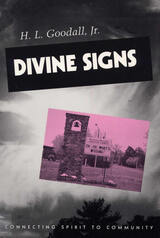 Divine Signs: Connecting Spirit to Community
H. L. Goodall, Jr.
Southern Illinois University Press, 1996
Divine Signs is the concluding volume of the ethnographic trilogy about the communicative tensions in everyday American cultural life H. L. Goodall, Jr., began with Casing a Promised Land and continued with Living in the Rock n Roll Mystery.
In this final work, the terms for understanding these tensions are found in a historical and mythological drama featuring Power (as the embodiment of the modern), Other (as the embodiment of the postmodern), and Spirit (as the unifying power capable of connecting disparate selves to dangerously fragmented communities). For this study, the localized site of interpretation is in and around Pickens and Oconee Counties, South Carolina, where every day street signs, business advertisements on billboards, signs that announce church themes, Internet postings, and other forms of public communication that invite private meanings are read as rhetorical invitations to participate in these myths and mysteries.
Using themes discoverable in such public forms of communication, Goodall deconstructs a variety of communal experiences—from annual community celebrations to weekly therapy sessions in local beauty salons to the fall audience rituals of Clemson University football games—to gain a deeper appreciation of the unifying symbolic orders that enrich the interpretive possibilities of our lives and that serve as signs of our deeply spiritual connections to each other and to the planet.
In the last sections of the book, the interplays of Power, Other, and Spirit are read into and against a wide variety of everyday interpretive contexts, from Rush Limbaugh and talk radio to narratives about angels and stories about the transformative powers of spiritual practices in organizations. Goodall then asks the important question: Where are the themes of this mythological drama leading us? In the stunning conclusion, Goodall creates communicative, cultural, and spiritual challenges for us all.
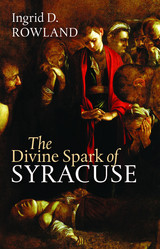 The Divine Spark of Syracuse
Ingrid D. Rowland
Brandeis University Press, 2018 Focusing on the figures of Plato, Archimedes, and Caravaggio, The Divine Spark of Syracuse discloses the role that Syracuse, a Greek cultural outpost in Sicily, played in fueling creative energies. Among the topics this book explores are Plato and the allegory of the cave, and the divine spark mentioned in his Seventh Letter. It also considers the machines of Archimedes, including his famous screw, and the variety of siege and antisiege weapons that he developed for the defense of his hometown during the siege of Syracuse during the Second Punic War, including “the hand” (a giant claw), the “burning mirror,” and the catapult. The final chapter offers a look at the artist and roustabout Caravaggio. On the run after yet another street brawl, Caravaggio traveled to Syracuse, where he painted Burial of St. Lucy (Santa Lucia) in 1608. Typical of his late works, the painting is notable for its subdued tones and emotional and psychological delicacy. This captivating book lends clear insight into the links between the sense of place and inspiration in philosophy, mathematics, and art. Rowland is the most learned tour guide we could ask for.
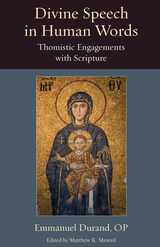 Divine Speech in Human Words: Thomistic Engagements with Scripture
Emmanuel Durand, OP
Catholic University of America Press, 2022 Is the portrait of God revealed in Scripture fundamentally intelligible? The biblical accounts of God reveal seemingly contradictory themes: God’s holiness and narratives telling of his anger; the Divine Omnipotence faced with the Impossible; the suffering Christ upon the Cross and the transcendent Trinity of Persons in God; the unique Savior and the universality of God’s salvific will; and so forth. How are we to hold together all of this data without denying any aspect of the mystery of God? Must we give into our ambient culture’s sense that the biblical God cannot be taken seriously by truly discerning and rational minds when they try to understand “the Divine”? Or, in the midst of this apparent contradiction, can we find the lines of harmony in the revealed mysteries?
In Divine Speech in Human Words, Fr. Emmanuel Durand unties some of the knots that face us when we reflect on the God of biblical Revelation. In each of the essays gathered here, Fr. Durand sympathetically articulates the tensions and apparent contradictions experienced by contemporary minds as they strive to understand the revealed truth of God. A whole host of topics are covered in this volume: the Cross and the revelation of the Trinity; God’s holiness and transcendence; divine immutability and the sorrow of a loving God; Divine Providence and human prayer; the fatherhood of God and eschatology; Christ’s way of life; and many others.
Drawing philosophical insights from the Thomistic tradition as his intellectual tools, Fr. Durand nonetheless emphasizes the importance of a properly theological mode of reflection, allowing these issues to be illuminated by the revealed truth of Sacred Scripture. Thus, for each of these difficult topics, he shows that a vital theological response must not limit itself to mere logical rigor but, rather, requires metaphysical insight and, above all, sapiential appreciation of God’s revealed word. With such instruments in hand, each essay approaches the tensions of biblical revelation with an eager readiness to show how a thoughtful Thomistic practice of biblical theology can guide faith as it seeks an understanding of both contemporary and perennial theological problems.
 Divine Yet Human Epics: Reflections of Poetic Rulers from Ancient Greece and India
Shubha Pathak
Harvard University Press, 2014 The central character of Divine Yet Human Epics is the developing conception of epic itself. Its story unfolds as the ancient Greek idea of epic originates with Pindar and Herodotus on the basis of the Iliad and Odyssey. While this notion eventually leads their Sanskrit counterparts, the Ramaya?a and Mahabharata, to be understood selectively in modern times, medieval readers Anandavardhana and Rajasekhara reveal distinctive features of these ancient Indian poems earlier in this exegetical tale. Shubha Pathak's interpretative account concludes with a new way to connect these primary epics to their Greek analogues. Both epic pairs feature poetic kings who together affirm and interrogate their societies' central religious ideals: Greek kléos (or heroic glory, which assuages uncertainty about the afterlife) and Indian dharma (or righteousness, which counters encroaching immorality). The Greek and Sanskrit epics, by showing both the divine ease and the human difficulty with which kléos and dharma are achieved, employ similar teaching strategies to address the shared psychological needs of human beings learning to live within the disparate cultures of ancient Greece and India. This cross-cultural comparative study thus provides a more comprehensive perspective on the poems' religiosity than the vantage points of Hellenists or of Indologists alone.
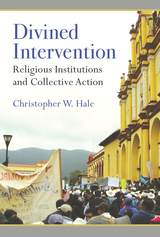 Divined Intervention: Religious Institutions and Collective Action
Christopher W. Hale
University of Michigan Press, 2020 Divined Intervention provides an innovative institutionalist account for why religion enables political activism in some settings, but not others. Christopher W. Hale argues that decentralized religious institutions facilitate grassroots collective action, and he uses a multimethod approach to test this explanation against several theoretical alternatives. Utilizing nationally representative Mexican survey data, the book’s statistical analyses demonstrate that decentralization by the Catholic Church is positively associated with greater individual political activism across the country. Using case studies centered in the Mexican states of Chiapas, Yucatán, and Morelos, the author shows that religious decentralization encourages reciprocal cooperative interactions at a local level. This then increases the ability of religion to provide goods and services to its local adherents. These processes then prompt the growth of organizational capacities at the grassroots, enabling secular political activism. Because this theoretical framework is grounded in human behavior, it shows how local institutions politically organize at the grassroots level. Divined Intervention also offers an improved understanding of religion’s relationship with political activism, a topic of ever-increasing significance as religion fuels political engagement across the globe. The book further synthesizes seemingly disparate approaches to the study of collective action into a cohesive framework. Finally, there is some debate as to the impact of ethnic diversity on the provision of public goods, and this study helps us understand how local institutional configurations can enable collective action across ethnic boundaries.
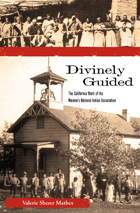 Divinely Guided: The California Work of the Women's National Indian Association
Valerie Sherer Mathes
Texas Tech University Press, 2012 Founded in Philadelphia in 1879, the WNIA devoted seventy years to working among Native women. Bucking society’s narrow sense of women’s appropriate sphere, WNIA members across the U.S. built homes, missionary cottages, schools, and chapels, and sponsored teachers and physicians—all with a strong dose of Christianity. Though goals of forced assimilation were as unrealistic as they were unsuccessful, WNIA’s contributions to the welfare of Native women were hardly insignificant, especially in California. In the north, they worked at the Round Valley and Hoopa Reservations and realized their most unusual undertaking—the funding of the Greenville Indian Industrial School. In the south they worked with the Native mission populations, where cultural similarities and greater proximity fostered unprecedented cooperation among WNIA workers. Amelia Stone Quinton, longtime WNIA president and editor of The Indian’s Friend, provides a consistent narrative thread, as does Helen Hunt Jackson in the chapters on Southern California. Even after Jackson’s death, her spiritual presence and the impact of her novel Ramona guided WNIA membership. Mathes’s recovery of WNIA history, supported by a wealth of documentation, reveals much about an era’s sense of sphere, service, and sisterhood.
The Diviners
Margaret Laurence
University of Chicago Press, 1993 In The Diviners, Morag Gunn, a middle aged writer who lives in a farmhouse on the Canadian prairie, struggles to understand the loneliness of her eighteen-year-old daughter. With unusual wit and depth, Morag recognizes that she needs solitude and work as much as she needs the love of her family. With an afterword by Margaret Atwood.
"Mrs. Laurence's [novel] is both poetic and muscular, and her heroine is certainly one of the more humane, unglorified, unpolemical, believable women to have appeared in recent fiction."—The New Yorker
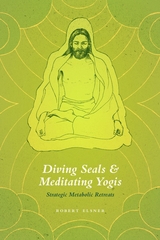 Diving Seals and Meditating Yogis: Strategic Metabolic Retreats
Robert Elsner
University of Chicago Press, 2015 The comparative physiology of seemingly disparate organisms often serves as a surprising pathway to biological enlightenment. How appropriate, then, that Robert Elsner sheds new light on the remarkable physiology of diving seals through comparison with members of our own species on quests toward enlightenment: meditating yogis.
As Elsner reveals, survival in extreme conditions such as those faced by seals is often not about running for cover or coming up for air, but rather about working within the confines of an environment and suppressing normal bodily function. Animals in this withdrawn state display reduced resting metabolic rates and are temporarily less dependent upon customary levels of oxygen. For diving seals—creatures especially well-adapted to prolonged submergence in the ocean’s cold depths—such periods of rest lengthen dive endurance. But while human divers share modest, brief adjustments of suppressed metabolism with diving seals, it is the practiced response achieved during deep meditation that is characterized by metabolic rates well below normal levels, sometimes even approaching those of non-exercising diving seals. And the comparison does not end here: hibernating animals, infants during birth, near-drowning victims, and clams at low tide all also display similarly reduced metabolisms.
By investigating these states—and the regulatory functions that help maintain them—across a range of species, Elsner offers suggestive insight into the linked biology of survival and well-being.
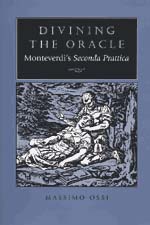 Divining the Oracle: Monteverdi's Seconda prattica
Massimo Ossi
University of Chicago Press, 2003 Claudio Monteverdi's historical position in music has been compared to that of Shakespeare in literature: almost exact contemporaries, each worked from traditional beginnings to transform nearly every genre he attempted. In this book, Massimo Ossi delves into the most significant aspect of Monteverdi's career: the development, during the first years of the seventeenth century, of a new compositional style he called the seconda prattica or "second manner."
Challenged in print for the unconventional aspects of his music, Monteverdi found himself at the center of a debate between defenders of Renaissance principles and the newest musical currents of the time. The principles of the seconda prattica, Ossi argues in this sophisticated analysis of Monteverdi's writings, music, and approaches to text-setting, were in fact much more significant to the course of Monteverdi's career than previously thought by modern scholars-not only did Monteverdi continue to pursue their aesthetic and theoretical implications for the rest of his life, but they also affected his dramatic compositions as well as his chamber vocal music and sacred works.
Ossi "divines the oracle" of Monteverdi's ambiguous theoretical concepts in a clear way and in terms of pure music; his book will enhance our understanding of Monteverdi as one of the most significant figures in western music history.
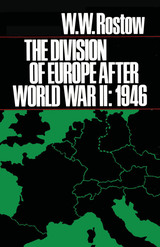 The Division of Europe after World War II: 1946
By W. W. Rostow
University of Texas Press, 1981 Should the negotiation of the post–World War II peace treaties in Europe have been pursued separately or should they have been approached within the framework of a general European settlement? The debate on this fundamental foreign policy issue, which has left only faint tracks in the documentary record, is fully explored here for the first time.
W. W. Rostow, in his second book in the Ideas and Action Series, describes a meeting that took place on the eve of the departure of Secretary of State James Byrnes for Paris to participate in treaty negotiations. The meeting was probably the only occasion during 1946 when the peace treaty issue as a whole was explicitly addressed at a high level with lucid alternatives on the table. The plan laid before Secretary of State Byrnes by his senior subordinates, Under Secretary Dean Acheson and Assistant Secretary for Economic Affairs Will Clayton, aimed to halt the movement toward the split of Europe and the emergence of hostile blocs. It outlined an all-European settlement, including economic and security institutions linked to the United Nations. Only one part of the proposal gained Byrnes's support and came to life: the United Nations Economic Commission for Europe in Geneva. But the Acheson-Clayton proposal foreshadowed the Marshall Plan.
The book's larger theme is the process by which the Cold War came about. Rostow's interpretation differs from either conventional or revisionist views, emphasizing as it does the process of incremental deterioration that occurred in 1946 and the role of uncertainty and weakness in American policy.
This second volume in the Ideas and Action Series will interest general readers as well as those with a particular interest in World War II. It should be of special value to political scientists, economists, military historians, and policy makers, and may serve as a case study in a variety of courses.
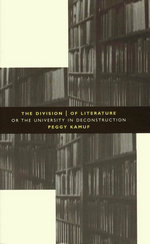 The Division of Literature: Or the University in Deconstruction
Peggy Kamuf
University of Chicago Press, 1996 Where does the university begin and the "outside" end? How has literature become established as a separate domain within the university? Demonstrating that these questions of division are intricately related, Peggy Kamuf explores the space that the university devotes to the study of literature.
Kamuf begins by analyzing the complex history of literary study within the modern university, critically reading developments from the French Revolution through the nineteenth century and beyond in Europe. She then turns to one of the most troubling works in the American literary canon—Melville's The Confidence-Man—to show how academic literary history has avoided confronting the implications of works in which meaning is never solely confined within a past. By engaging a future readership to which it applies for credit, Kamuf argues, literature cannot serve as a stable object of study. It locates, rather, a site of "the university in deconstruction."
Ranging from disciplinary histories of literature to our current culture wars, Kamuf offers a fascinating critique of academic literary study.
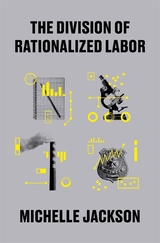 The Division of Rationalized Labor
Michelle Jackson
Harvard University Press, 2025 A pathbreaking study of why, paradoxically, workforce specialization and job responsibilities have increased hand in hand.
In the United States and other late-industrial countries, the division of labor has changed radically over the last 150 years. This comes as no surprise: the nature of work has been transformed by new technologies, new discoveries, and new challenges. While the fact of change was predictable, the type of change is not at all as theorists envisioned.
For all their differences, Adam Smith, Karl Marx, Emile Durkheim, and Max Weber each presumed that specialized workers would perform a narrower range of tasks. The early history of the industrial age supported this view. As the assembly line overtook the workshop, the artisan who constructed every part of a useful object was replaced with workers who handled a single piece of the work process. The Division of Rationalized Labor demonstrates that—although early industrialization may have operated as Smith, Marx, and their colleagues surmised—in late industrialization we are witnessing something quite different: specialization in many occupations has actually led to workers taking on an increasingly wide range of responsibilities.
Marshaling rich historical and statistical data, Michelle Jackson shows how this paradox of specialization emerges today in education, law enforcement, medicine, and manufacturing. Jackson argues that the development of probabilistic science provided the foundation for growing job complexity. As researchers learned which levers to pull in order to maximize productivity in a given industry, they created new tasks for the workers who specialized in producing industry outputs. As researchers developed the capacity to predict bad outcomes—criminality, low test scores, poor health—they left police, teachers, doctors, and nurses responsible for increasingly complicated preventive work. Analogous situations arise throughout the labor force, ensuring that workers across the occupational structure are overworked and overwhelmed.
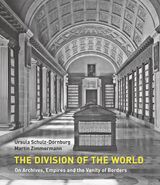 The Division of the World: On Archives, Empires and the Vanity of Borders
Martin Zimmerman
Haus Publishing, 2021 A photographer and a historian explore a vast archive of Spanish colonial history.
At a time when Western nations are being urged to confront their colonial past, this book examines a major archive, revealing the scale of the Spanish colonial enterprise in South and Central America.
Established in 1785, the Archivo General de Indias in Seville holds roughly three hundred years of Spanish colonial history in the Americas. It houses 8,000 charts and around ninety million documents—among them Christopher Columbus’s logbook and the famous Treaty of Tordesillas which, mediated by the Pope and signed in 1494, entitled the Spanish and Portuguese kings to divide the world between them. With this treaty as a starting point, the historian Martin Zimmermann journeys into the age of discovery and recounts stories of dangerous passages, encounters with the unknown, colonial brutality, and the power of cartographers, illustrating the insatiable lust of colonialists to conquer, exploit, and own the world. Ursula Schulz-Dornburg’s photographs show the archive before its redevelopment in 2002, offering a unique view into one of Europe’s most significant archives.
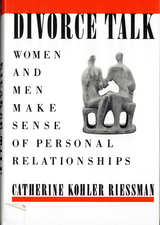 Divorce Talk: Women and Men Make Sense of Personal Relationships
Catherine Kohler Riessman
Rutgers University Press, 1990 Taking a new look at divorce in America, Catherine Reissman shows how divorce is socially shared, and how it takes crucially different forms for women and men. Drawing on interviews with adults who are divorcing, she treats their accounts as texts to be interpreted, as templates for understanding contemporary beliefs about personal relationships.
Riessman looks at the ideology of the companionate marriage: husband and wife should be each other's closest companion, and in marriage one should achieve emotial intimacy and sexual fulfillment. These beliefs imply a level of equality that rarely exists. In reality, most wives are subordinate to their husbands, most husbands want neither "deep talk" nor small talk that women want, and many husbands resent their wife's ties to kin and friends. To explain divorce, women and men construct gendered visions of what marriage should provide, and at the same time they mourn gender divisions and blame their divorces on them. Riessman examines the stories people tell about their marriages--the protagonists, inciting conditions, and culminating events--and how these narrative structures provide ways to persuade both teller and listener that divorce was justified.
Although divorce is invariably stressful, many people believe that men suffer less than women. This is an artifact of what Riessman calls the "feminization of psychological distress"--traditional ways of measuring distress reflect women's idioms, not men's. Departing from a literature that casts divorce in only negative terms, she finds paradoxically that women sense rewards, even as they report hardship. There is a shakeup in gender roles, and women more than men feel they gain a fuller idea of who they are. The author allows us to enter the points of view of her subjects, while her analytic approach makes links between the self and society.
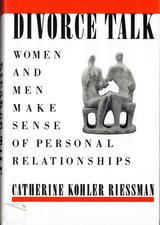 Divorce Talk: Women and Men Make Sense of Personal Relationships
Catherine Kohler Riessman
Rutgers University Press, 1990 Taking a new look at divorce in America, Catherine Reissman shows how divorce is socially shared, and how it takes crucially different forms for women and men. Drawing on interviews with adults who are divorcing, she treats their accounts as texts to be interpreted, as templates for understanding contemporary beliefs about personal relationships.
Riessman looks at the ideology of the companionate marriage: husband and wife should be each other's closest companion, and in marriage one should achieve emotial intimacy and sexual fulfillment. These beliefs imply a level of equality that rarely exists. In reality, most wives are subordinate to their husbands, most husbands want neither "deep talk" nor small talk that women want, and many husbands resent their wife's ties to kin and friends. To explain divorce, women and men construct gendered visions of what marriage should provide, and at the same time they mourn gender divisions and blame their divorces on them. Riessman examines the stories people tell about their marriages--the protagonists, inciting conditions, and culminating events--and how these narrative structures provide ways to persuade both teller and listener that divorce was justified.
Although divorce is invariably stressful, many people believe that men suffer less than women. This is an artifact of what Riessman calls the "feminization of psychological distress"--traditional ways of measuring distress reflect women's idioms, not men's. Departing from a literature that casts divorce in only negative terms, she finds paradoxically that women sense rewards, even as they report hardship. There is a shakeup in gender roles, and women more than men feel they gain a fuller idea of who they are. The author allows us to enter the points of view of her subjects, while her analytic approach makes links between the self and society.
Divrei Mishkan HaNefesh: A Guide to the CCAR Machzor
Rabbi Edwin Goldberg
Central Conference of American Rabbis, 2016 Divrei Mishkan HaNefesh is like a midrash on the machzor, a "Mishkan Hanefesh Rabah." This volume serves as a springboard for entering into the sanctuary of our souls with enthusiasm and helpful insights, exegetical and homiletical material, tips and guideposts, as well as indexes of poems and biblical citations. This book focuses on the prayers and scriptural offerings included in Mishkan HaNefesh. Rubric by rubric, insights are presented with background information concerning the perspective and choices of the editors, as well as offering extra material to engage the reader. A number of brief essays, composed by members of the machzor editorial team, are also included.
Divrei Mishkan T'filah: Delving into the Siddur
Rabbi Richard S. Sarason
Central Conference of American Rabbis, 2018 This long-awaited collection of essays on Mishkan T'filah by Rabbi Richard Sarason, PhD, serves as a commentary on our prayerbook. Drawing on Dr. Sarason's deep knowledge of liturgy, these essays teach about Mishkan T'filah specifically and about prayer in general.
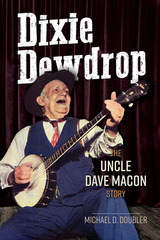 Dixie Dewdrop: The Uncle Dave Macon Story
Michael D. Doubler
University of Illinois Press, 2018 One of the earliest performers on WSM in Nashville, Uncle Dave Macon became the Grand Ole Opry's first superstar. His old-time music and energetic stage shows made him a national sensation and fueled a thirty-year run as one of America's most beloved entertainers. Michael D. Doubler tells the amazing story of the Dixie Dewdrop, a country music icon. Born in 1870, David Harrison Macon learned the banjo from musicians passing through his parents' Nashville hotel. After playing local shows in Middle Tennessee for decades, a big break led Macon to Vaudeville, the earliest of his two hundred-plus recordings and eventually to national stardom. Uncle Dave--clad in his trademark plug hat and gates-ajar collar--soon became the face of the Opry itself with his spirited singing, humor, and array of banjo picking styles. For the rest of his life, he defied age to tour and record prolifically, manage his business affairs, mentor up-and-comers like David "Stringbean" Akeman, and play with the Delmore Brothers, Roy Acuff, and Bill Monroe.
Dixie Diaspora: An Anthology of Southern Jewish History
Mark K. Bauman
University of Alabama Press, 2006 Regional Jewish history at its best. This book is an anthology of essays designed to introduce readers to key issues in this growing field of scholarship and to encourage further study. Divided into five sections--“Jews and Judaism,” “Small Town Life,” “Business and Governance,” “Interaction,” and “Identity”--the essays cover a broad geographical and chronological span and address a variety of topics, including economics, politics, roles of women, ethnicity, and race. This organizational structure enhances the volume’s historical treatment of regional Jewish history and lends itself to cross-disciplinary study in fields such as cultural studies, religious studies, and political science.
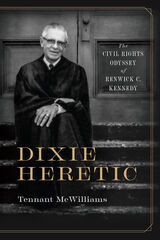 Dixie Heretic: The Civil Rights Odyssey of Renwick C. Kennedy
Tennant McWilliams
University of Alabama Press, 2023 A life-and-times biography of the minister and social reformer Renwick C. Kennedy
Drawn from some 5,000 letters, six decades of daily-diary writings, and extensive interviews, Dixie Heretic: The Civil Rights Odyssey of Renwick C. Kennedy offers a life-and-times biography of the Alabama Black Belt minister, Renwick C. Kennedy (1900–1985). Here, Tennant McWilliams gives an unvarnished account of Kennedy’s tortuous efforts to make his congregants and other southern whites “better Christians.”
Kennedy came from “upcountry” South Carolina, a place rife with Scotch-Irish Associate Reformed Presbyterians—people of biblical infallibility and individual piety and salvation. In 1927, after a life-changing theology education at Princeton, he moved to Camden, Alabama, county seat of Wilcox County. There, he came to believe that God had a mandate for him: to change the “Half Christian” conservative, and the often violent, racial behaviors around him. As a neo-orthodox Protestant, Kennedy never rejected literal approaches to the Bible. Still, out of the “Full Christian” Social Gospel, he urged changed racial behavior. Ultimately this led him to publish confrontational short stories and essays in Christian Century and New Republic—most set in fictitious “Yaupon County.”
In World War II, Kennedy served as a chaplain with the famed 102nd Evacuation Hospital. He came home hoping the Allied victory would spur Americans to fight racial segregation just as they had fought racial fascism in Europe. The 1948 Dixiecrat movement dashed these hopes, turning much of his neo-orthodox optimism to cynicism. His hope found fleeting resurgence in the civil rights movement, and saw Kennedy quietly leading desegregation of Troy University, where he was an administrator. But the era’s assassinations, combined with George Wallace and the rise of southern white Republicans, regularly returned him to the frustrated hopes of 1948 and fostered a pessimism about truly changed hearts that he took to his grave in 1985.
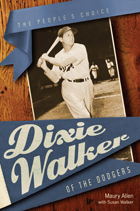 Dixie Walker of the Dodgers: The People's Choice
Maury Allen and Susan Walker
University of Alabama Press, 2010 Fred “Dixie” Walker was a gifted ballplayer from a family of gifted athletes. (His father, uncle, and brother all played major league baseball.) Dixie Walker played in the majors for 18 seasons and in 1,905 games, assembling a career batting average of .306 while playing for the Yankees, White Sox, Tigers, Dodgers, and Pirates. Walker won the 1944 National League batting title, was three times an All-Star, and was runner-up for Most Valuable Player in the National League in 1946. He was particularly beloved by Brooklyn Dodgers fans, to whom he was the “People’s Choice.” But few remember any of those achievements today. Dixie Walker—born in Georgia, and a resident of Birmingham, Alabama, for most of his life—is now most often remembered as one of the southerners on the Dodgers team who resented and resisted Jackie Robinson when he joined the ball club in 1947, as the first African American major leaguer in the modern game. Having grown up in conditions of strict racial segregation, Walker later admitted to being under pressure from Alabama business associates when, in protest, he demanded to be traded away from the Dodgers. Written by a professional sportswriter knowledgeable of the era and of personalities surrounding that event, and Dixie Walker’s daughter, this collaborative work provides a fuller account of Walker and fleshes out our understanding of him as a player and as a man. Walker ultimately came to respect Robinson, referred to him as “a gentleman,” and gave him pointers, calling him “as outstanding an athlete as I ever saw.”
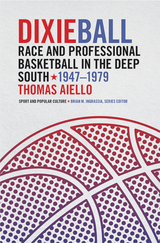 Dixieball: Race and Professional Basketball in the Deep South, 1947–1979
Thomas Aiello
University of Tennessee Press, 2019 In Dixieball, Thomas Aiello considers the cultural function of professional basketball in the Deep South between 1947 and 1979. Making a strong case for the role of race in this process, Aiello ties the South’s initial animus toward basketball to the same complex that motivated the region to sacrifice its own economic interests to the cause of white supremacy. Fans of basketball, as compared to other team sports, were closer to the players, who showed more of their bodies; blackness, then, had more visibility in basketball than it had in other sports. By the time Lyndon Johnson signed the Voting Rights Act in 1965, African Americans made up 47.5 percent of professional basketball players, and despite integrating later than baseball and football, it was fast becoming known as a “black” sport. Over time, survival for southern teams grew more tenuous, fan support more fickle, and racial incidents between players and fans more hostile. Racism clashed with civic development in a fast-evolving region.
To identify the sources of this clash, Dixieball locates the main points of intersection between professional basketball and the Deep South in the two decades prior to the region’s first major franchise. Aiello then takes readers to New Orleans, where the first major Deep South professional basketball team—the New Orleans Buccaneers—was born, and on to Atlanta, Birmingham, St. Louis, and others, leading up to 1979. Scholars of sport and Southern history alike will find Dixieball a compelling contribution to the lively, interdisciplinary discussions animating the Sport and Popular Culture series.
Dixiecrats and Democrats: Alabama Politics
William D. Barnard
University of Alabama Press, 1984 A pivotal in the study of history and politics, not only in Alabama but in the other states of the South
Barnard’s account is elegantly concise, the labor of conspicuous scholarship. In an effort to analyze Alabama’s political bedrock, the author has tapped virtually every source. What results is a cogent and harmonious theme.
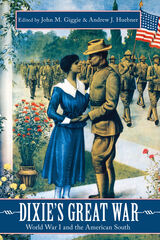 Dixie's Great War: World War I and the American South
Edited by John M. Giggie and Andrew J. Huebner
University of Alabama Press, 2021 Examining the First World War through the lens of the American South
How did World War I affect the American South? Did southerners experience the war in a particular way? How did regional considerations and, more generally, southern values and culture impact the wider war effort? Was there a distinctive southern experience of WWI?
Scholars considered these questions during “Dixie’s Great War,” a symposium held at the University of Alabama in October 2017 to commemorate the centenary of the American intervention in the war. With the explicit intent of exploring iterations of the Great War as experienced in the American South and by its people, organizers John M. Giggie and Andrew J. Huebner also sought to use historical discourse as a form of civic engagement designed to facilitate a community conversation about the meanings of the war.
Giggie and Huebner structured the panels thematically around military, social, and political approaches to the war to encourage discussion and exchanges between panelists and the public alike. Drawn from transcriptions of the day’s discussions and lightly edited to preserve the conversational tone and mix of professional and public voices, Dixie’s Great War: World War I and the American South captures the process of historians at work with the public, pushing and probing general understandings of the past, uncovering and reflecting on the deeper truths and lessons of the Great War—this time, through the lens of the South.
This volume also includes an introduction featuring a survey of recent literature dealing with regional aspects of WWI and a discussion of the centenary commemorations of the war. An afterword by noted historian Jay Winter places “Dixie’s Great War”—the symposium and this book—within the larger framework of commemoration, emphasizing the vital role such forums perform in creating space and opportunity for scholars and the public alike to assess and understand the shifting ground between cultural memory and the historical record.
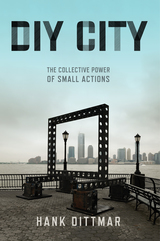 DIY City: The Collective Power of Small Actions
Hank Dittmar
Island Press, 2020 Some utopian plans have shaped our cities —from England’s New Towns and Garden Cities to the Haussmann plan for Paris and the L’Enfant plan for Washington, DC. But these grand plans are the exception, and seldom turn out as envisioned by the utopian planner. Inviting city neighborhoods are more often works of improvisation on a small scale. This type of bottom-up development gives cities both their character and the ability to respond to sudden change.
Hank Dittmar, urban planner, friend of artists and creatives, sometime rancher, “high priest of town planning” to the Prince of Wales, believed in letting small things happen. Dittmar concluded that big plans were often the problem. Looking at the global cities of the world, he saw a crisis of success, with gentrification and global capital driving up home prices in some cities, while others decayed for lack of investment.
In DIY City, Dittmar explains why individual initiative, small-scale business, and small development matter, using lively stories from his own experience and examples from recent history, such as the revival of Camden Lock in London and the nascent rebirth of Detroit. DIY City, Dittmar’s last original work, captures the lessons he learned throughout the course of his varied career—from transit-oriented development to Lean Urbanism—that can be replicated to create cities where people can flourish.
DIY City is a timely response to the challenges many cities face today, with a short supply of affordable housing, continued gentrification, and offshore investment. Dittmar’s answer to this crisis is to make Do-It-Yourself the norm rather than the exception by removing the barriers to small-scale building and local business. The message of DIY City can offer hope to anyone who cares about cities.
Dizzy: A Memoir
Rachel Weaver
West Virginia University Press, 2026 A memoir chronicling the author’s 18-year struggle with an undiagnosed illness, exposing the failures of the medical system while reflecting on resilience, uncertainty, and the search for joy amid hardship.
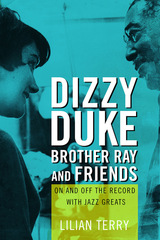 Dizzy, Duke, Brother Ray, and Friends: On and Off the Record with Jazz Greats
Lillian Terry
University of Illinois Press, 2017 Lilian Terry has lived music. As a performer, she has shared the stage with Ella Fitzgerald and Nina Simone. She cofounded the European Jazz Federation and pioneered jazz education in Italy. Her work as a director-producer of radio and television programs has spread the music by introducing countless people to its legendary performers. Drawing on Terry’s long friendships and professional associations, Dizzy, Duke, Brother Ray, and Friends offers readers a rare opportunity to hear intimate conversations with some of the world’s greatest musical figures. Dizzy Gillespie offers his thoughts on playing with “sanctified” rhythm and the all-important personal touch in performance. Duke Ellington discourses on jazz history and concludes an interview to sing a self-written ditty in Italian. Ray Charles gives candid thoughts on race and politics while taking charge of Terry’s tape recorder. Abbey Lincoln, Max Roach, Horace Silver, Bill Evans—all provide Terry and her readers with unforgettable encounters. The result is a collection of profiles, some stretching over a decade or more, that reveal these performers in ways that illuminate their humanity and expand our appreciation of their art.
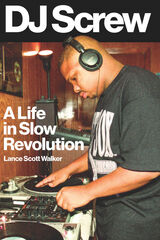 DJ Screw: A Life in Slow Revolution
Lance Scott Walker
University of Texas Press, 2022 DJ Screw, a.k.a. Robert Earl Davis Jr., changed rap and hip-hop forever. In the 1990s, in a spare room of his Houston home, he developed a revolutionary mixing technique known as chopped and screwed. Spinning two copies of a record, Screw would “chop” in new rhythms, bring in local rappers to freestyle over the tracks, and slow the recording down on tape. Soon Houstonians were lining up to buy his cassettes—he could sell thousands in a single day. Fans drove around town blasting his music, a sound that came to define the city’s burgeoning and innovative rap culture. June 27 has become an unofficial city holiday, inspired by a legendary mix Screw made on that date. Lance Scott Walker has interviewed nearly everyone who knew Screw, from childhood friends to collaborators to aficionados who evangelized Screw’s tapes—millions of which made their way around the globe—as well as the New York rap moguls who honored him. Walker brings these voices together with captivating details of Screw’s craft and his world. More than the story of one man, DJ Screw is a history of the Houston scene as it came of age, full of vibrant moments and characters. But none can top Screw himself, a pioneer whose mystique has only grown in the two decades since his death.
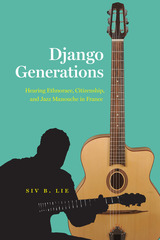 Django Generations: Hearing Ethnorace, Citizenship, and Jazz Manouche in France
Siv B. Lie
University of Chicago Press, 2021 Django Generations shows how relationships between racial identities, jazz, and national belonging become entangled in France.
Jazz manouche—a genre known best for its energetic, guitar-centric swing tunes—is among France’s most celebrated musical practices of the twentieth and twenty-first centuries. It centers on the recorded work of famed guitarist Django Reinhardt and is named for the ethnoracial subgroup of Romanies (also known, often pejoratively, as “Gypsies”) to which Reinhardt belonged. French Manouches are publicly lauded as bearers of this jazz tradition, and many take pleasure and pride in the practice while at the same time facing pervasive discrimination. Jazz manouche uncovers a contradiction at the heart of France’s assimilationist republican ideals: the music is portrayed as quintessentially French even as Manouches themselves endure treatment as racial others.
In this book, Siv B. Lie explores how this music is used to construct divergent ethnoracial and national identities in a context where discussions of race are otherwise censured. Weaving together ethnographic and historical analysis, Lie shows that jazz manouche becomes a source of profound ambivalence as it generates ethnoracial difference and socioeconomic exclusion. As the first full-length ethnographic study of French jazz to be published in English, this book enriches anthropological, ethnomusicological, and historical scholarship on global jazz, race and ethnicity, and citizenship while showing how music can be an important but insufficient tool in struggles for racial and economic justice.
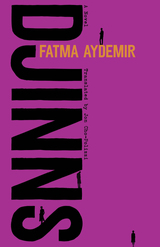 Djinns
Fatma Aydemir, Translated by Jon Cho-Polizzi
University of Wisconsin Press, 2024 After laboring in Germany for thirty years, Hüseyin uses his hard-earned savings to purchase a sunny and spacious flat in Istanbul, envisioning the joys of retirement in his home country with his wife, Emine, by his side. But in a cruel twist of fate, he dies of a heart attack on the day he moves in. As Hüseyin’s children and wife travel to Turkey for his funeral, the novel explores their lives and dreams: a teenage son struggling to embrace his sexuality; a college-educated daughter desperate to align conflicting facets of her identity; a first-born son racialized and profiled all his life, forced to perform a role he could not choose for himself; a lonely daughter left behind in rural Turkey who dreams of recapturing her family’s love after joining them in Germany as a teenager; and a mother unable to break free from the cycles of violence that have defined her.
In this epic tale, Fatma Aydemir explores the lives of characters who could not be more different from one another—except in their insatiable desires to be understood. Rather than a seamless narrative, the novel circles around suppressed memories, unspoken trauma, and buried pasts. Turning expectations and stereotypes of the immigrant experience on their side, Aydemir shows how we all grapple with power and beauty, the holes in our lives, and the demons that hover just out of sight.
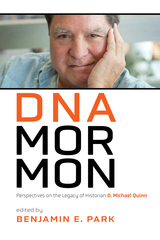 DNA Mormon: Perspectives on the Legacy of Historian D. Michael Quinn
Benjamin E. Park
Signature Books, 2022 Few lives have been as consequential for modern Mormonism as D. Michael Quinn. The son of a Mexican immigrant father and a California Mormon mother, Quinn became an influential participant in the New Mormon History movement. Much of his scholarly work remains classic in the field. Yet while he was publicly celebrated for his award-winning books and articles, he privately struggled to reconcile his sexuality with his faith. Eventually, his revisionist scholarship and homosexuality placed him in the crosshairs of church leaders, and he was excommunicated as one of the September Six in 1993.
This compilation is a rigorous and riveting assessment of Quinn’s legacy. In this volume, scholars examine him as a historical figure who helps us better understand modern Mormonism. They also probe his role as a historiographical titan. These essays enable us to analyze his influence on scholarship that both preceded and followed him. More than an investigation into his life and work, DNA Mormon uncovers the world in which he lived.
The DNA Mystique: The Gene as a Cultural Icon
Dorothy Nelkin and M. Susan Lindee
University of Michigan Press, 2004 The DNA Mystique suggests that the gene in popular culture draws on scientific ideas but is not constrained by the technical definition of the gene as a section of DNA that codes for a protein. In highlighting DNA as it appears in soap operas, comic books, advertising, and other expressions of mass culture, the authors propose that these domains provide critical insights into science itself.
With a new introduction and conclusion, this edition will continue to be an engaging, accessible, and provocative text for the sociology, anthropology, and bioethics classroom, as well as stimulating reading for those generally interested in science and culture.
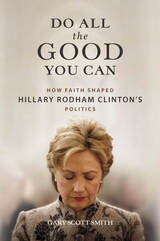 Do All the Good You Can: How Faith Shaped Hillary Rodham Clinton’s Politics
Gary Scott Smith
University of Illinois Press, 2023 Methodism in the public and private lives of the politician After more than forty contentious years in the public eye, Hillary Rodham Clinton is one of the best-known political figures in the nation. Yet the strong religious faith at the heart of her politics and personal life often remains confounding, if not mysterious, to longtime observers. Even many of her admirers would be surprised to hear Clinton state that her Methodist outlook has “been a huge part of who I am and how I have seen the world, and what I believe in, and what I have tried to do in my life.” Gary Scott Smith’s biography of Clinton’s journey in faith begins with her Methodist upbringing in Park Ridge, Illinois, where she faithfully attended worship services, Sunday school, and youth group meetings. Like many mainline Protestants, Clinton’s spiritual commitment developed gradually throughout childhood, while her combination of missionary zeal and impressive personal talents has informed her career from the time of her pro bono work at Yale on behalf of children to the present. Her Methodist faith has been very important to many of Clinton’s high-profile endeavors and in helping her cope with the prominent travails brought on by two presidential campaigns, never-ending conservative rancor, and her husband’s infidelity. Smith’s account examines Clinton’s faith in the context of work ranging from her 1990s pursuit of healthcare reform to a “Hillary doctrine” of foreign policy focused on her longtime goal of providing basic human rights for children and women--a project she saw as essential to United States security. The result is an enlightening reconsideration of an extraordinary political figure who has defied private doubts and public controversy to live by John Wesley’s dictum: “Do all the good you can, by all the means you can, in all the ways you can, in all the places you can, at all the times you can, to all the people you can, as long as ever you can.”
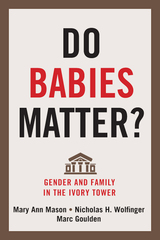 Do Babies Matter?: Gender and Family in the Ivory Tower
Mason, Mary Ann
Rutgers University Press, 2013 The new generation of scholars differs in many ways from its predecessor of just a few decades ago. Academia once consisted largely of men in traditional single-earner families. Today, men and women fill the doctoral student ranks in nearly equal numbers and most will experience both the benefits and challenges of living in dual-income households. This generation also has new expectations and values, notably the desire for flexibility and balance between careers and other life goals. However, changes to the structure and culture of academia have not kept pace with young scholars’ desires for work-family balance.
Do Babies Matter? is the first comprehensive examination of the relationship between family formation and the academic careers of men and women. The book begins with graduate students and postdoctoral fellows, moves on to early and mid-career years, and ends with retirement. Individual chapters examine graduate school, how recent PhD recipients get into the academic game, the tenure process, and life after tenure. The authors explore the family sacrifices women often have to make to get ahead in academia and consider how gender and family interact to affect promotion to full professor, salaries, and retirement. Concrete strategies are suggested for transforming the university into a family-friendly environment at every career stage.
The book draws on over a decade of research using unprecedented data resources, including the Survey of Doctorate Recipients, a nationally representative panel survey of PhDs in America, and multiple surveys of faculty and graduate students at the ten-campus University of California system..
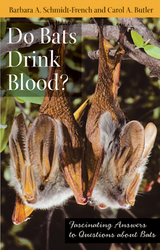 Do Bats Drink Blood?: Fascinating Answers to Questions about Bats
Schmidt-French, Barbara A
Rutgers University Press, 2009 Bat biologist Barbara A. Schmidt-French and writer Carol A. Butler offer a compendium of insightful facts about bats in this accessible and expertly written question-and-answer volume. Numbering more than one thousand species in our world today, bats in the wild are generally unthreatening. Like most other mammals, bats are curious, affectionate, and even playful with one another. Highly beneficial animals, bats are critical to global ecological, economic, and public health. Do Bats Drink Blood? illuminates the role bats play in the ecosystem, their complex social behavior, and how they glide through the night sky using their acute hearing: echolocation skills that have helped in the development of navigational aids for the blind. Personal in voice with the perspective of a skilled bat researcher, this book explores wide-ranging topics as well as common questions people have about bats, providing a trove of fascinating facts. Featuring rare color and black-and-white photographs, including some by renowned biologist, photographer, and author Merlin Tuttle, Do Bats Drink Blood? provides a comprehensive resource for general readers, students, teachers, zoo and museum enthusiasts, farmers and orchardists, or anyone who may encounter or be fascinated by these extraordinary animals.
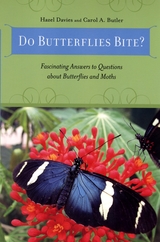 Do Butterflies Bite?: Fascinating Answers to Questions about Butterflies and Moths
Davies, Hazel
Rutgers University Press, 2008 How fast do butterflies fly? Does a butterfly have ears? Do they sleep? Does a caterpillar have a skeleton? How does a moth get out of its cocoon? What is the difference between a butterfly and a moth? And just what is a skipper?
Every year, thousands of people visit butterfly conservatories to stand in quiet awe of the simple beauty displayed by these magical creatures. Hazel Davies and Carol A. Butler capture the sense of wonderment and curiosity experienced by adults and children alike in this book about butterflies and their taxonomic cousins, the moths and the skippers. Beautifully illustrated with color and black and white photographs, and drawings by renowned artist William Howe, this book is an essential resource for parents, teachers, students, or anyone who has ever been entranced by these fascinating, fluttering creatures.
Covering everything from their basic biology to their complex behaviors at every stage of life to issues in butterfly conservation, Davies and Butler explore wide-ranging topics and supply a trove of intriguing facts. You'll find tips on how to attract more butterflies to your garden, how to photograph them, and even how to raise them in your own home. Arranged in a question and answer format, the book provides detailed information written in an accessible style that brings to life the science and natural history of these insects. In addition, sidebars throughout the book detail an assortment of butterfly trivia, while extensive appendices direct you to organizations, web sites, and more than 200 indoor and outdoor public exhibits, where you can learn more or connect with other lepidopterophiles (butterfly lovers).
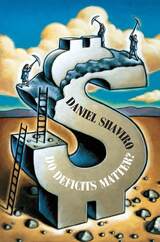 Do Deficits Matter?
Daniel Shaviro
University of Chicago Press, 1997 Do deficits matter? Yes and no, says Daniel Shaviro in this political and economic study. Yes, because fiscal policy affects generational distribution, national saving, and the level of government spending. And no, because the deficit is an inaccurate measure with little economic content. This book provides an invaluable guide for anyone wanting to know exactly what is at stake for Americans in this ongoing debate.
"[An] excellent, comprehensive, and illuminating book. Its analysis, deftly integrating considerations of economics, law, politics, and philosophy, brings the issues of 'balanced budgets,' national saving, and intergenerational equity out of the area of religious crusades and into an arena of reason. . . . A magnificent, judicious, and balanced treatment. It should be read and studied not just by specialists in fiscal policy but by all those in the economic and political community."—Robert Eisner, Journal of Economic Literature
"Shaviro's history, economics, and political analysis are right on the mark. For all readers."—Library Journal
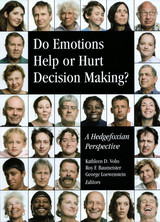 Do Emotions Help or Hurt Decisionmaking?: A Hedgefoxian Perspective
Kathleen D. Vohs
Russell Sage Foundation, 2007 Philosophers have long tussled over whether moral judgments are the products of logical reasoning or simply emotional reactions. From Jane Austen's Sense and Sensibility to the debates of modern psychologists, the question of whether feeling or sober rationality is the better guide to decision making has been a source of controversy. In Do Emotions Help or Hurt Decision Making? Kathleen Vohs, Roy Baumeister, and George Loewenstein lead a group of prominent psychologists and economists in exploring the empirical evidence on how emotions shape judgments and choices. Researchers on emotion and cognition have staked out many extreme positions: viewing emotions as either the driving force behind cognition or its side effect, either an impediment to sound judgment or a guide to wise decisions. The contributors to Do Emotions Help or Hurt Decision Making? provide a richer perspective, exploring the circumstances that shape whether emotions play a harmful or helpful role in decisions. Roy Baumeister, C. Nathan DeWall, and Liqing Zhang show that while an individual's current emotional state can lead to hasty decisions and self-destructive behavior, anticipating future emotional outcomes can be a helpful guide to making sensible decisions. Eduardo Andrade and Joel Cohen find that a positive mood can negatively affect people's willingness to act altruistically. Happy people, when made aware of risks associated with altruistic acts, become wary of jeopardizing their own well-being. Benoît Monin, David Pizarro, and Jennifer Beer find that whether emotion or reason matters more in moral evaluation depends on the specific issue in question. Individual characteristics often mediate the effect of emotions on decisions. Catherine Rawn, Nicole Mead, Peter Kerkhof, and Kathleen Vohs find that whether an individual makes a decision based on emotion depends both on the type of decision in question and the individual's level of self-esteem. And Quinn Kennedy and Mara Mather show that the elderly are better able to regulate their emotions, having learned from experience to anticipate the emotional consequences of their behavior. Do Emotions Help or Hurt Decision Making? represents a significant advance toward a comprehensive theory of emotions and cognition that accounts for the nuances of the mental processes involved. This landmark book will be a stimulus to scholarly debates as well as an informative guide to everyday decisions.
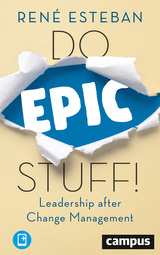 Do Epic Stuff!: Leadership after Change Management
René Esteban
Campus Verlag, 2020 The fast-paced energy of contemporary society is riddled with distractions, disappointments, and discouragement. From our home lives to our work lives, feeling driven and creative has become exceedingly difficult.
The methods of change management are outdated. Today what matters most is focus and inspiration. In Do Epic Stuff!, René Esteban shows leaders how to use goals and inspiration as beacons, bringing teams to the heights of success. Esteban provides insight for leaders and managers to help encourage their team to give their all for an attractive goal, how to keep it in sight against all odds, and how to work towards it with zeal and enthusiasm. Esteban mixes his own tried and tested experiences from the corporate world with surprisingly effective psychological methods.
Drawing on expert advice from top executives at such companies as Allianz, BMW, E.ON, and Deutsche Telekom, Do Epic Stuff! will enable leaders to foster outstanding teams that can achieve big goals.
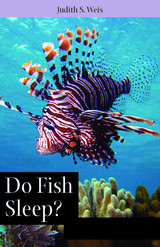 Do Fish Sleep?: Fascinating Answers to Questions about Fishes
Weis, Judith S
Rutgers University Press, 2011 From the fifty-one-foot whale shark Rhincodon typus to a less-than-one-half-inch fish in the minnow family--the tiny Paedocypris progenetica--fish certainly carry a lot of weight . . . or do they? A fish's heft in water may vary, but these diverse aquatic animals certainly carry a lot of weight in our ecosystems and environment. From freshwater to ocean habitats, Judith S. Weis offers a fascinating look at these deceptively simple creatures. Fishes may appear to live a dull existence, but appearances change once we understand more about how they survive. These wonders actually possess attributes that would make us superpowers--they can change color, sex, produce light and electricity, regenerate injured fins, prevent themselves from sinking, and some can even walk on land. Do Fish Sleep? is organized in an easy-to-read and accessible question-and-answer format, filled with more than 55 photographs and over 100 interesting facts from fish biology basics to the importance of preserving and restoring fish diversity and healthy populations. A captivating read for fish enthusiasts of all ages--naturalists, environmentalists, aquarists, scuba divers, and students--this is also the perfect primer for those just about to get their feet wet. Dive in!
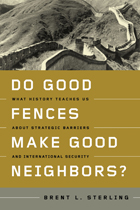 Do Good Fences Make Good Neighbors?: What History Teaches Us about Strategic Barriers and International Security
Brent L. Sterling
Georgetown University Press, 2010 A number of nations, conspicuously Israel and the United States, have been increasingly attracted to the use of strategic barriers to promote national defense. In Do Good Fences Make Good Neighbors?, defense analyst Brent Sterling examines the historical use of strategic defenses such as walls or fortifications to evaluate their effectiveness and consider their implications for modern security. Sterling studies six famous defenses spanning 2,500 years, representing both democratic and authoritarian regimes: the Long Walls of Athens, Hadrian’s Wall in Roman Britain, the Ming Great Wall of China, Louis XIV’s Pré Carré, France’s Maginot Line, and Israel’s Bar Lev Line. Although many of these barriers were effective in the short term, they also affected the states that created them in terms of cost, strategic outlook, military readiness, and relations with neighbors. Sterling assesses how modern barriers against ground and air threats could influence threat perceptions, alter the military balance, and influence the builder’s subsequent policy choices. Advocates and critics of strategic defenses often bolster their arguments by selectively distorting history. Sterling emphasizes the need for an impartial examination of what past experience can teach us. His study yields nuanced lessons about strategic barriers and international security and yields findings that are relevant for security scholars and compelling to general readers.
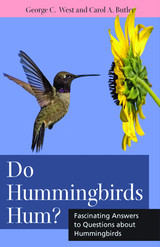 Do Hummingbirds Hum?: Fascinating Answers to Questions about Hummingbirds
West, George C
Rutgers University Press, 2010 Hummingbirds may be the smallest birds in the world, but they have the biggest appetites. Their wings flutter on average fifty to eighty times each second as they visit hundreds of flowers over the course of a day to sip the sweet nectar that sustains them. Their hearts beat nearly twelve hundred times a minute and their rapid breathing allows these amazing birds to sustain their unique manner of flight. They can hover in the air for prolonged periods, fly backwards using forceful wings that swivel at the shoulder, and dive at nearly two hundred miles per hour. Native only to the Americas, some hummingbirds have been known to migrate from Mexico to Alaska in the course of a season. Watching a hummingbird at a backyard feeder, we only see its glittering iridescent plumage and its long, narrow beak; its rapidly moving wings are a blur to our eyes.
These tiny, colorful birds have long fascinated birders, amateur naturalists, and gardeners. But, do they really hum?
In Do Hummingbirds Hum? George C. West, who has studied and banded over 13,500 hummingbirds in Arizona, and Carol A. Butler provide an overview of hummingbird biology for the general reader, and more detailed discussions of their morphology and behavior for those who want to fly beyond the basics. Enriched with beautiful and rare photography, including a section in vivid color, this engaging question and answer guide offers readers a wide range of information about these glorious pollinators as well as tips for attracting, photographing, and observing hummingbirds in the wild or in captivity.
Do It Yourself: A Handbook For Changing Our World
Edited by Trapese Trapese
Pluto Press, 2007 Do you really want to change the world? If the answer is YES, then this book shows you how.
Ethical consumerism is now big business. But leading a sustainable and truly radical life encompasses a whole variety of things that challenge the mainstream. This book shows how we can make real changes to the way we live. In simple steps, it describes how you can create sustainable and equitable ways of living that can help transform not just your own life, but the culture around you.
The book weaves together analysis, stories and experiences. It combines in-depth analytical chapters followed by easy to follow 'How to Guides' with practical ideas for change. Taken together, these small steps can move us towards taking back control of our lives from governments and corporations.
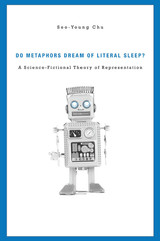 Do Metaphors Dream of Literal Sleep?: A Science-Fictional Theory of Representation
Seo-Young Chu
Harvard University Press, 2010 In culture and scholarship, science-fictional worlds are perceived as unrealistic and altogether imaginary. Seo-Young Chu offers a bold challenge to this perception of the genre, arguing instead that science fiction is a form of “high-intensity realism” capable of representing non-imaginary objects that elude more traditional, “realist” modes of representation. Powered by lyric forces that allow it to transcend the dichotomy between the literal and the figurative, science fiction has the capacity to accommodate objects of representation that are themselves neither entirely figurative nor entirely literal in nature.
Chu explores the globalized world, cyberspace, war trauma, the Korean concept of han, and the rights of robots, all as referents for which she locates science-fictional representations in poems, novels, music, films, visual pieces, and other works ranging within and without previous demarcations of the science fiction genre. In showing the divide between realism and science fiction to be illusory, Do Metaphors Dream of Literal Sleep? sheds new light on the value of science fiction as an aesthetic and philosophical resource—one that matters more and more as our everyday realities grow increasingly resistant to straightforward representation.
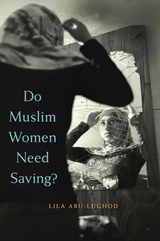 Do Muslim Women Need Saving?
Lila Abu-Lughod
Harvard University Press, 2013 Frequent reports of honor killings, disfigurement, and sensational abuse have given rise to a consensus in the West, a message propagated by human rights groups and the media: Muslim women need to be rescued. Lila Abu-Lughod boldly challenges this conclusion. An anthropologist who has been writing about Arab women for thirty years, she delves into the predicaments of Muslim women today, questioning whether generalizations about Islamic culture can explain the hardships these women face and asking what motivates particular individuals and institutions to promote their rights.
In recent years Abu-Lughod has struggled to reconcile the popular image of women victimized by Islam with the complex women she has known through her research in various communities in the Muslim world. Here, she renders that divide vivid by presenting detailed vignettes of the lives of ordinary Muslim women, and showing that the problem of gender inequality cannot be laid at the feet of religion alone. Poverty and authoritarianism—conditions not unique to the Islamic world, and produced out of global interconnections that implicate the West—are often more decisive. The standard Western vocabulary of oppression, choice, and freedom is too blunt to describe these women's lives.
Do Muslim Women Need Saving? is an indictment of a mindset that has justified all manner of foreign interference, including military invasion, in the name of rescuing women from Islam—as well as a moving portrait of women's actual experiences, and of the contingencies with which they live.
 Do Not Forsake Me, Oh My Darling
Maura Stanton
University of Notre Dame Press, 2002 Do Not Forsake Me, Oh My Darling contains ten darkly funny short stories by Maura Stanton. Anything can happen in this swiftly narrated book, which provides glimpses of Gertrude Stein playing Ping-Pong with a G.I. in Paris during World War II, a famous contemporary writer giving a haircut in a bar in Eureka, California, and Katherine Mansfield struggling to write her final stories in Montana, Switzerland. The characters in Stanton’s lively stories try to sort out their lives by telling stories or listening closely to the stories of other people. Two sisters interrogate each other about different versions of the party that changed their lives forever. A young woman entertains and shocks her friends in a café with a funny story about her first love affair. A landlady tries to reconstruct the life of a Sicilian immigrant whose ashes she finds in a trailer. In capturing with wit and sensitivity the struggles of its characters to make sense of the many strange and ordinary occurrences of everyday life, Do Not Forsake Me, Oh My Darling reminds us that we are all, in some sense, characters in many of life’s different stories.
Do Not Reisist the Spirit's Call
Michael D. Torre
Catholic University of America Press, 2013 In this book, Michael D. Torre makes Marín-Sola's articles available in English for the first time. The articles are preceded by an introduction on Marín-Sola and followed by a conclusion that traces the reception of his thought within the Catholic theological community. In Torre's afterword, he defends Marín-Sola's position as substantively the same as that of Aquinas.
Do Not Rise
Beth Bachmann
University of Pittsburgh Press, 2015 “Beth Bachmann’s Temper was the last time [in forty years] I remember reading a first book by a poet so prodigally and—the word that came to my mind was—severely gifted. The new poems in Do Not Rise are a quantum leap forward with all the metaphorical leaps, adumbrations, dizzyings, deft, brief knottings that make the poems in Temper so dazzling. A remarkable young talent, and a scary one.”
—Robert Hass
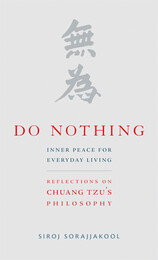 Do Nothing: Peace for Everyday Living: Reflections on Chuang Tzu's Philosophy
Siroj Sorajjakool
Templeton Press, 2009 "Words," writes Chuang Tzu, "are for catching ideas; once you've caught the idea, you can forget the words." In Do Nothing, author Siroj Sorajjakool lends us some of his insightful words to help us all "catch" the provocative ideas of one of China's most important literary and philosophical giants—one who emerged at a time when China had several such giants philosophizing on Tao or "the Way." Though his thinking dates back to the fourth century, Chuang Tzu's Tao has profound implications for our modern lives. He welcomes an existence that is radically removed from the image of normalcy that society often projects, wherein the individual must always strive for more, always seek greater productivity, and always try to better him or herself and his or her place in life. Chuang Tzu would posit that the definitions of normalcy, success, and happiness are arbitrarily assigned and that our rigid and unquestioning adherence to these so-called "norms" leads to existential restlessness and unease. Instead of striving, he would say, be still. Instead of acquiring, embrace nothingness. Instead of seeking to understand the limitlessness of the universe during your brief and extremely limited existence, enjoy the wonder of it. Siroj Sorajjakool suggests that when we can embrace nothingness, we undergo a spiritual transformation that liberates us to see more clearly and truly find ourselves. He offers a very personal exploration of Chuang Tzu's Tao, first in its historical and literary context, and then in the context of our twenty-first century existence. What emerges is a liberating and highly readable meditation on the many lessons we can "catch" from Chuang Tzu on how we view our aspirations, our joys and sorrows, our successes and failures, and what it means to be a worthwhile person.
Do Options Exist ?: The Reform of Pension and Health Care Systems in Latin America
Maria Amparo Cruz-Saco
University of Pittsburgh Press, 1999 This timely volume brings together specialists on the reform of social security systems to analyze the similarities and differences of those health care and pension reforms that have taken place since the early 1990s and suggests possible gains through recent or contemplated revisions to those systems.
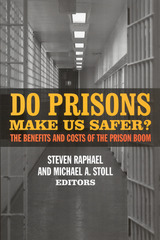 Do Prisons Make Us Safer?: The Benefits and Costs of the Prison Boom
Steven Raphael
Russell Sage Foundation, 2009 The number of people incarcerated in U.S. prisons and jails more than quadrupled between 1975 and 2005, reaching the unprecedented level of over two million inmates today. Annual corrections spending now exceeds 64 billion dollars, and many of the social and economic burdens resulting from mass incarceration fall disproportionately on minority communities. Yet crime rates across the country have also dropped considerably during this time period. In Do Prisons Make Us Safer? leading experts systematically examine the complex repercussions of the massive surge in our nation's prison system. Do Prisons Make Us Safer? asks whether it makes sense to maintain such a large and costly prison system. The contributors expand the scope of previous analyses to include a number of underexplored dimensions, such as the fiscal impact on states, effects on children, and employment prospects for former inmates. Steven Raphael and Michael Stoll assess the reasons behind the explosion in incarceration rates and find that criminal behavior itself accounts for only a small fraction of the prison boom. Eighty-five percent of the trend can be attributed to "get tough on crime" policies that have increased both the likelihood of a prison sentence and the length of time served. Shawn Bushway shows that while prison time effectively deters and incapacitates criminals in the short term, long-term benefits such as overall crime reduction or individual rehabilitation are less clear cut. Amy Lerman conducts a novel investigation into the effects of imprisonment on criminal psychology and uncovers striking evidence that placement in a high security penitentiary leads to increased rates of violence and anger—particularly in the case of first time or minor offenders. Rucker Johnson documents the spill-over effects of parental incarceration—children who have had a parent serve prison time exhibit more behavioral problems than their peers. Policies to enhance the well-being of these children are essential to breaking a devastating cycle of poverty, unemployment, and crime. John Donohue's economic calculations suggest that alternative social welfare policies such as education and employment programs for at-risk youth may lower crime just as effectively as prisons, but at a much lower human cost. The cost of hiring a new teacher is roughly equal to the cost of incarcerating an additional inmate. The United States currently imprisons a greater proportion of its citizens than any other nation in the world. Until now, however, we've lacked systematic and comprehensive data on how this prison boom has affected families, communities, and our nation as a whole. Do Prisons Make Us Safer? provides a highly nuanced and deeply engaging account of one of the most dramatic policy developments in recent U.S. history.
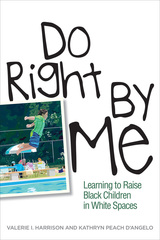 Do Right by Me: Learning to Raise Black Children in White Spaces
Valerie I. Harrison and Kathryn Peach D'Angelo
Temple University Press, 2021 For decades, Katie D’Angelo and Valerie Harrison engaged in conversations about race and racism. However, when Katie and her husband, who are white, adopted Gabriel, a biracial child, Katie’s conversations with Val, who is black, were no longer theoretical and academic. The stakes grew from the two friends trying to understand each other’s perspectives to a mother navigating, with input from her friend, how to equip a child with the tools that will best serve him as he grows up in a white family. Through lively and intimate back-and-forth exchanges, the authors share information, research, and resources that orient parents and other community members to the ways race and racism will affect a black child’s life—and despite that, how to raise and nurture healthy and happy children. These friendly dialogues about guarding a child’s confidence and nurturing positive racial identity form the basis for Do Right by Me. Harrison and D’Angelo share information on transracial adoption, understanding racism, developing a child’s positive racial identity, racial disparities in healthcare and education, and the violence of racism. Do Right by Me also is a story about friendship and kindness, and how both can be effective in the fight for a more just and equitable society.
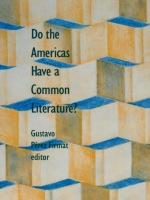 Do the Americas Have a Common Literature?
Gustavo Pérez Firmat, ed.
Duke University Press, 1990 This volume takes an important step toward the discovery of a common critical heritage that joins the diverse literatures of North America and Latin America. Traditionally, literary criticism has treated the literature of the Americas as “New World” literature, examining it in relation to its “Old World”—usually European—counterparts. This collection of essays redirects the Eurocentric focus of earlier scholarship and identifies a distinctive pan-American consciousness. The essays here place the literature of the Americas in a hemispheric context by drawing on approaches derived from various schools of contemporary critical thought—Marxism, feminism, culture studies, semiotics, reception aesthetics, and poststructuralism. As part of their search for a distinctly New World literary idiom, the contributors engage not only the major North American and Spanish American writers, but also such “marginal” or “minor” literatures as Chicano, African American, Brazilian, and Québecois. In identifying areas of agreement and confluence, this work lays the groundwork for finding historical, ideological, and cultural homogeneity in the imaginative writing of the Americas. Contributors. Lois Parkinson Zamora, David T. Haberly, José David Saldívar, Antonio Benítez-Rojo, José Piedra, Doris Sommer, Enrico Mario Santí, Eduardo González, John Irwin, Wendy B. Faris, René Prieto, Jonathan Monroe, Gustavo Pérez Firmat
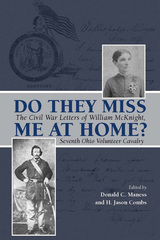 Do They Miss Me at Home?: The Civil War Letters of William McKnight, Seventh Ohio Volunteer Cavalry
Donald C. Maness
Ohio University Press, 2010 William McKnight was a member of the Seventh Ohio Volunteer Cavalry from September 1862 until his death in June of 1864. During his time of service, McKnight penned dozens of emotion-filled letters, primarily to his wife, Samaria, revealing the struggles of an entire family both before and during the war. This collection of more than one hundred letters provides in-depth accounts of several battles in Kentucky and Tennessee, such as the Cumberland Gap and Knoxville campaigns that were pivotal events in the Western Theater. The letters also vividly respond to General John Hunt Morgan’s raid through Ohio and correct claims previously published that McKnight was part of the forces chasing Morgan. By all accounts Morgan did stay for a period of time at McKnight’s home in Langsville during his raid through Ohio, much to McKnight’s horror and humiliation, but McKnight was in Kentucky at the time. Tragically, McKnight was killed in action nearly a year later during an engagement with Morgan’s men near Cynthiana, Kentucky.
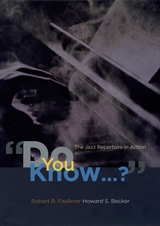 "Do You Know...?": The Jazz Repertoire in Action
Robert R. Faulkner and Howard S. Becker
University of Chicago Press, 2009 Every night, somewhere in the world, three or four musicians will climb on stage together. Whether the gig is at a jazz club, a bar, or a bar mitzvah, the performance never begins with a note, but with a question. The trumpet player might turn to the bassist and ask, “Do you know ‘Body and Soul’?”—and from there the subtle craft of playing the jazz repertoire is tested in front of a live audience. These ordinary musicians may never have played together—they may never have met—so how do they smoothly put on a show without getting booed offstage.
In “Do You Know . . . ?” Robert R. Faulkner and Howard S. Becker—both jazz musicians with decades of experience performing—present the view from the bandstand, revealing the array of skills necessary for working musicians to do their jobs. While learning songs from sheet music or by ear helps, the jobbing musician’s lexicon is dauntingly massive: hundreds of thousands of tunes from jazz classics and pop standards to more exotic fare. Since it is impossible for anyone to memorize all of these songs, Faulkner and Becker show that musicians collectively negotiate and improvise their way to a successful performance. Players must explore each others’ areas of expertise, develop an ability to fake their way through unfamiliar territory, and respond to the unpredictable demands of their audience—whether an unexpected gang of polka fanatics or a tipsy father of the bride with an obscure favorite song.
“Do You Know . . . ?” dishes out entertaining stories and sharp insights drawn from the authors’ own experiences and observations as well as interviews with a range of musicians. Faulkner and Becker’s vivid, detailed portrait of the musician at work holds valuable lessons for anyone who has to think on the spot or under a spotlight.
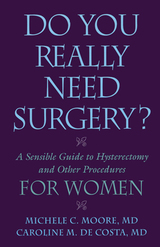 Do You Really Need Surgery?: A Sensible Guide to Hysterectomy and Other Procedures for Women
Michele C. Moore, M.D., FAAFP and Caroline M. de Costa
Rutgers University Press, 2004 At last, here is a user-friendly guide to gynecologic surgery. The authors' guiding principle is that each woman for whom any kind of surgery is recommended should be well informed about the indications, the risks, and the expected results. Using anecdotes drawn from a combined fifty years of experience, doctors Moore and de Costa provide clear and accurate information about women's anatomy, physiology, common gynecological ailments, diagnosis, alternative treatments, and, finally, full details about surgery itself. Among the surgeries discussed are removal of the uterus (hysterectomy), removal of the ovaries (oophorectomy), and removal of fibroids. The various ways of performing these procedures are examined, including minimally invasive surgery done through the laparoscope. The authors also help the patient through the post-operative phase, revealing what to expect, how to make the recovery easier, and how to take care of yourself after the surgery. The result is a book that empowers women as they weigh their options with regard to gynecologic surgery.
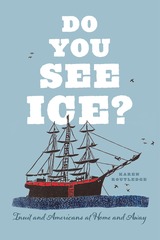 Do You See Ice?: Inuit and Americans at Home and Away
Karen Routledge
University of Chicago Press, 2018 Many Americans imagine the Arctic as harsh, freezing, and nearly uninhabitable. The living Arctic, however—the one experienced by native Inuit and others who work and travel there—is a diverse region shaped by much more than stereotype and mythology. Do You See Ice? presents a history of Arctic encounters from 1850 to 1920 based on Inuit and American accounts, revealing how people made sense of new or changing environments.
Routledge vividly depicts the experiences of American whalers and explorers in Inuit homelands. Conversely, she relates stories of Inuit who traveled to the northeastern United States and were similarly challenged by the norms, practices, and weather they found there. Standing apart from earlier books of Arctic cultural research—which tend to focus on either Western expeditions or Inuit life—Do You See Ice? explores relationships between these two groups in a range of northern and temperate locations. Based on archival research and conversations with Inuit Elders and experts, Routledge’s book is grounded by ideas of home: how Inuit and Americans often experienced each other’s countries as dangerous and inhospitable, how they tried to feel at home in unfamiliar places, and why these feelings and experiences continue to resonate today.
The author intends to donate all royalties from this book to the Elders’ Room at the Angmarlik Center in Pangnirtung, Nunavut.
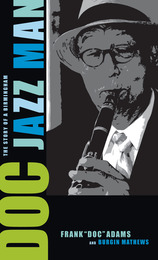 Doc: The Story of a Birmingham Jazz Man
Frank "Doc" Adams and Burgin Mathews
University of Alabama Press, 2012 Autobiography of jazz elder statesman Frank “Doc” Adams, highlighting his role in Birmingham, Alabama’s, historic jazz scene and tracing his personal adventure that parallels, in many ways, the story and spirit of jazz itself.
Doc tells the story of an accomplished jazz master, from his musical apprenticeship under John T. “Fess” Whatley and his time touring with Sun Ra and Duke Ellington to his own inspiring work as an educator and bandleader. Central to this narrative is the often-overlooked story of Birmingham’s unique jazz tradition and community. From the very beginnings of jazz, Birmingham was home to an active network of jazz practitioners and a remarkable system of jazz apprenticeship rooted in the city’s segregated schools. Birmingham musicians spread across the country to populate the sidelines of the nation’s bestknown bands. Local musicians, like Erskine Hawkins and members of his celebrated orchestra, returned home heroes. Frank “Doc” Adams explores, through first-hand experience, the history of this community, introducing readers to a large and colorful cast of characters—including “Fess” Whatley, the legendary “maker of musicians” who trained legions of Birmingham players and made a significant mark on the larger history of jazz. Adams’s interactions with the young Sun Ra, meanwhile, reveal life-changing lessons from one of American music’s most innovative personalities. Along the way, Adams reflects on his notable family, including his father, Oscar, editor of the Birmingham Reporter and an outspoken civic leader in the African American community, and Adams’s brother, Oscar Jr., who would become Alabama’s first black supreme court justice. Adams’s story offers a valuable window into the world of Birmingham’s black middle class in the days before the civil rights movement and integration. Throughout, Adams demonstrates the ways in which jazz professionalism became a source of pride within this community, and he offers his thoughts on the continued relevance of jazz education in the twenty-first century.
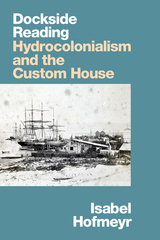 Dockside Reading: Hydrocolonialism and the Custom House
Isabel Hofmeyr
Duke University Press, 2022 In Dockside Reading Isabel Hofmeyr traces the relationships among print culture, colonialism, and the ocean through the institution of the British colonial Custom House. During the late nineteenth and early twentieth centuries, dockside customs officials would leaf through publications looking for obscenity, politically objectionable materials, or reprints of British copyrighted works, often dumping these condemned goods into the water. These practices, echoing other colonial imaginaries of the ocean as a space for erasing incriminating evidence of the violence of empire, informed later censorship regimes under apartheid in South Africa. By tracking printed matter from ship to shore, Hofmeyr shows how literary institutions like copyright and censorship were shaped by colonial control of coastal waters. Set in the environmental context of the colonial port city, Dockside Reading explores how imperialism colonizes water. Hofmeyr examines this theme through the concept of hydrocolonialism, which puts together land and sea, empire and environment.
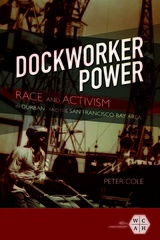 Dockworker Power: Race and Activism in Durban and the San Francisco Bay Area
Peter Cole
University of Illinois Press, 2018 Philip Taft Labor History Book Award, Labor and Working-Class History Association (LAWCHA) and the Cornell ILR School, 2019
A Black Perspectives Best Black History Book of 2018 Dockworkers have power. Often missed in commentary on today's globalizing economy, workers in the world's ports can harness their role, at a strategic choke point, to promote their labor rights and social justice causes. Peter Cole brings such overlooked experiences to light in an eye-opening comparative study of Durban, South Africa, and the San Francisco Bay Area, California. Path-breaking research reveals how unions effected lasting change in some of the most far-reaching struggles of modern times. First, dockworkers in each city drew on longstanding radical traditions to promote racial equality. Second, they persevered when a new technology--container ships--sent a shockwave of layoffs through the industry. Finally, their commitment to black internationalism and leftist politics sparked transnational work stoppages to protest apartheid and authoritarianism. Dockworker Power not only brings to light surprising parallels in the experiences of dockers half a world away from each other. It also offers a new perspective on how workers can change their conditions and world.
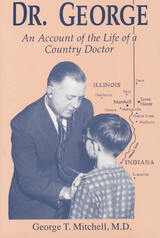 Doctor George: An Account of the Life of a Country Doctor
George T. Mitchell, M.D. Foreword by Glen W. Davidson
Southern Illinois University Press, 1993
Dr. George T. Mitchell of Marshall, Illinois, shares with humor and compassion stories and reflections about his medical practice of fifty years.
Having grown up in Marshall, Dr. Mitchell writes of his early experiences in midwestern America: basketball rivalries, school-boy pranks, and the traditions passed down through a family of doctors. Dr. Mitchell tells of his brief detour to obtain a degree in mechanical engineering, his decision to pursue a career in medicine, and his medical school experiences at the George Washington School of Medicine before the days of antibiotics and sophisticated medical technology. He vividly describes his subsequent service in World War II as a young surgeon at a military hospital helping injured soldiers resume normal lives while enduring the frustrations and occasional horrors of military life.
After the war, Dr. Mitchell joined his father’s practice in Marshall, where, he observes, he was among sixteen physicians in a rural county with a population of less than twenty thousand people. Within twenty-five years, the number of doctors had dropped to only four. In this memoir Dr. Mitchell conveys his unwillingness to just sit by and watch the health needs of his community increase while medical and other services decline. He, instead, became a community activist, representing rural concerns to the state medical society, organizing the first emergency medical technician teams in the county, masterminding the planning of a regional medical center, campaigning successfully for improved highway safety, and spurring the extension of reliable telephone service throughout his area.
As Dr. Mitchell recounts the house calls, farm accidents, emergency surgeries, and family counseling that comprised the life of this country doctor, he offers the keen insights of a clinician trained to look beyond what others only see.
 A Doctor in Galilee: The Life and Struggle of a Palestinian in Israel
Jonathan Cook
Pluto Press, 2008 Hatim Kanaaneh is a Palestinian doctor who has struggled for over 35 years to bring medical care to Palestinians in Galilee, against a culture of anti-Arab discrimination. This is the story of how he fought for the human rights of his patients and overcame the Israeli authorities' cruel indifference to their suffering.
Kanaaneh is a native of Galilee, born before the creation of Israel. He left to study medicine at Harvard, before returning to work as a public health physician with the intention of helping his own people. He discovered a shocking level of disease and malnutrition in his community and a shameful lack of support from the Israeli authorities. After doing all he could for his patients by working from inside the system, Kanaaneh set up The Galilee Society, an NGO working for equitable health, environmental and socio-economic conditions for Palestinian Arabs in Israel.
This is a brilliant memoir that shows how grass roots organisations can loosen the Zionist grip upon Palestinian lives.
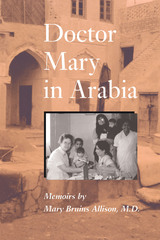 Doctor Mary in Arabia: Memoirs
By Mary Bruins Allison
University of Texas Press, 1994 Until fairly recently, Arab women rarely received professional health care, since few women doctors had ever practiced in Arabia and their culture forbade them from consulting male doctors. Not surprisingly, Dr. Mary Bruins Allison faced an overwhelming demand when she arrived in Kuwait in 1934 as a medical missionary of the Reformed Church of America. Over the next forty years, "Dr. Mary" treated thousands of women and children, faithfully performing the duties that seemed required of her as a Christian—to heal the sick and seek converts. These memoirs record a fascinating life. Dr. Allison briefly describes her upbringing and her professional training at Women's Medical College of Pennsylvania. She then focuses on her experiences in Kuwait, where women of all classes, including royalty, flocked to her care. In addition to describing many of her cases, Dr. Allison paints a richly detailed picture of life in Kuwait both before and after the discovery of oil transformed the country. Her recollections include invaluable details of women's lives in the Middle East during the early and mid-twentieth century. They add a valuable chapter to the story of modern medicine, to the largely unsuccessful efforts of the Christian church to win converts in the Middle East, and to the opportunities and limitations that faced American women of the period. Dr. Allison also worked briefly in Bahrain, Qatar, Oman, and India, and she includes material on each country. The introduction situates her experiences in the context of Middle Eastern and medical developments of the period.
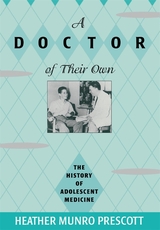 A Doctor of Their Own: The History of Adolescent Medicine
Heather Munro Prescott
Harvard University Press, 1998 Parents have known since time immemorial, and social scientists have agreed since the turn of the century, that adolescents are a people unto themselves--a "distinct developmental category." Yet it was not until the 1950s that a medical specialty specifically for teenagers came into being. In this book, Heather Munro Prescott shows how the mid-twentieth-century emergence of adolescent medicine resulted from a combination of social changes that reached far beyond the field of medicine--changes that placed teenagers themselves at the center of the national agenda.
The first book to trace the history of adolescent medicine, A Doctor of Their Own draws on oral histories of physicians in the field, patient records from adolescent medical facilities, medical and popular advice literature, and letters from teenagers and their parents. Prescott examines the interplay between the emergence of adolescent medicine and changes in American family relationships, youth culture, popular perceptions about young people, and the social experience of adolescence. With special attention to the role of young people themselves in the shaping of this new discipline, her book follows the development of adolescent medicine from its origins in the work of J. Roswell Gallagher at Boston Children's Hospital in the 1950s to its uncertain prospects today, when, despite heightened recognition of their specific medical needs, most teenagers still receive inadequate health care.
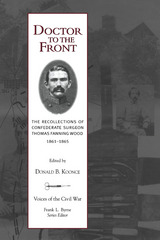 Doctor To The Front: Confederate Surgeon Thomas Fanning Wood
Donald B. Koonce
University of Tennessee Press, 2000 "Filled with perceptive observations about military leaders, morale in the Confederacy, life in the Southern capital of Richmond, and a range of medical topics including the treatment of wounded, . . . Confederate surgeon Thomas Fanning Wood’s wartime letters and postwar reminiscences constitute a fine addition to the roster of published firsthand testimony about the Civil War."—Gary W. Gallagher
The Civil War was a tragic conflict that destroyed many lives, but for those trying to save lives the tragedy was often compounded. Military doctors labored through the smoke of battle where impossible conditions and fear of infection often forced them to resort to amputation, and most operations were performed without painkillers. Thomas Fanning Wood recorded his wartime experiences as a Confederate Army surgeon, and his recollections of those events allow us to hear a distinct voice of the Civil War.
As a young soldier recovering from fever at a Richmond hospital, Wood developed an interest in medicine that was encouraged by a doctor who steered him toward medical training. After only eight months of study he was made an assistant surgeon in the Third North Carolina Regiment. His narrative—drawn from his memoirs, letters from the front, and articles written for his hometown newspaper—presents a poignant and sometimes horrifying picture of what the Civil War physician had to face both under battlefield conditions and in urban hospitals.
Wood himself spent much of his time at the front, and his vivid narrative describes both a doctor’s daily activities and the campaigns he witnessed. He was present at many of the war’s major engagements: he was near Stonewall Jackson when the general fell at Chancellorsville, manned a field dressing station at the foot of Culp’s Hill at Gettysburg, and was one of the few survivors of the Union attack on the "mule shoe" at Spotsylvania when his entire division was wiped out. Wood’s account also lends new insight into Jubal Early’s 1864 campaigns in the Shenandoah Valley and against Washington.
With its observations of medical care and training not found in standard histories of the war—including a description of the examination required to become an assistant surgeon—Doctor to the Front offers a unique human perspective on the Civil War. With their additional descriptions of key figures and events, Wood’s recollections combine historical significance and human interest to show us another side of that terrible conflict.
The Author: Donald B. Koonce is the great-grandson of Thomas Fanning Wood and has served on the Board of Directors of the South Carolina Historical Society and the Historic Greenville Foundation. He is president of the Koonce Group, Inc., an award-winning communications company whose productions include Daybreak at the Cowpens, a documentary for the National Park Service.
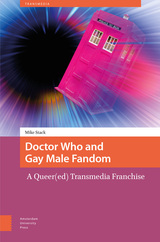 Doctor Who and Gay Male Fandom: A Queer(ed) Transmedia Franchise
Mike Stack
Amsterdam University Press, 2024 Doctor Who is a BBC transmedia franchise that has lasted over sixty years. Its fanbase boasts a substantial following of gay men. This book asks why this should be.
Through examining four core components – the Doctor, the TARDIS, the companion and the Daleks – this book traces the trajectory of queerness from wider culture to paratextual media and finally into the parent text, resulting in an inclusive brand. In doing so, it argues that fandom provides a space to mediate between personal identities and the wider world. Drawing from interviews with fans, the book demonstrates the complexities and contradictions of queerness, and proposes an alternative theory of gay cultural formation.
This is the first book-length study to use queer theory to understand Doctor Who. It will be of interest to students and teachers of media theory and fan studies, psychosocial studies, queer theory and history, as well as Doctor Who fans.
 Doctor Who and Race
Edited by Lindy Orthia
Intellect Books, 2013 Doctor Who is the longest running science fiction television series in the world and is regularly watched by millions of people across the globe. While its scores of fans adore the show with cult-like devotion, the fan-contributors to this book argue that there is an uncharted dimension to Doctor Who. Bringing together diverse perspectives on race and its representation in Doctor Who, this anthology offers new understandings of the cultural significance of race in the programme – how the show’s representations of racial diversity, colonialism, nationalism and racism affect our daily lives and change the way we relate to each other. An accessible introduction to critical race theory, postcolonial studies and other race-related academic fields, the 23 contributors deftly combine examples of the popular cultural icon and personal reflections to provide an analysis that is at once approachable but also filled with the intellectual rigor of academic critique.
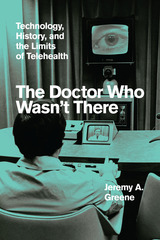 The Doctor Who Wasn't There: Technology, History, and the Limits of Telehealth
Jeremy A. Greene
University of Chicago Press, 2022 This gripping history shows how the electronic devices we use to access care influence the kind of care we receive.
The Doctor Who Wasn’t There traces the long arc of enthusiasm for—and skepticism of—electronic media in health and medicine. Over the past century, a series of new technologies promised to democratize access to healthcare. From the humble telephone to the connected smartphone, from FM radio to wireless wearables, from cable television to the “electronic brains” of networked mainframe computers: each new platform has promised a radical reformation of the healthcare landscape. With equal attention to the history of technology, the history of medicine, and the politics and economies of American healthcare, physician and historian Jeremy A. Greene explores the role that electronic media play, for better and for worse, in the past, present, and future of our health.
Today’s telehealth devices are far more sophisticated than the hook-and-ringer telephones of the 1920s, the radios that broadcasted health data in the 1940s, the closed-circuit televisions that enabled telemedicine in the 1950s, or the online systems that created electronic medical records in the 1960s. But the ethical, economic, and logistical concerns they raise are prefigured in the past, as are the gaps between what was promised and what was delivered. Each of these platforms also produced subtle transformations in health and healthcare that we have learned to forget, displaced by promises of ever newer forms of communication that took their place.
Illuminating the social and technical contexts in which electronic medicine has been conceived and put into practice, Greene’s history shows the urgent stakes, then and now, for those who would seek in new media the means to build a more equitable future for American healthcare.
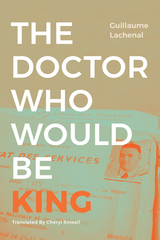 The Doctor Who Would Be King
Guillaume Lachenal
Duke University Press, 2022 In The Doctor Who Would Be King Guillaume Lachenal tells the extraordinary story of Dr. Jean Joseph David, a French colonial army doctor who governed an entire region of French Cameroon during World War II. Dr. David—whom locals called “emperor”—dreamed of establishing a medical utopia. Through unchecked power, he imagined realizing the colonialist fantasy of emancipating colonized subjects from misery, ignorance, and sickness. Drawing on archives, oral histories, and ethnographic fieldwork, Lachenal traces Dr. David’s earlier attempts at a similar project on a Polynesian island and the ongoing legacies of his failed experiment in Cameroon. Lachenal does not merely recount a Conradian tale of imperial hubris, he brings the past into the present, exploring the memories and remains of Dr. David’s rule to reveal a global history of violence, desire, and failure in which hope for the future gets lost in the tragic comedy of power.
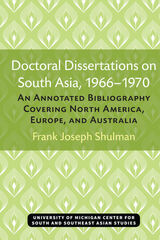 Doctoral Dissertations on South Asia, 1966–1970: An Annotated Bibliography Covering North America, Europe, and Australia
Frank Joseph Shulman
University of Michigan Press, 1971 This volume gathers the harvest of recent doctoral dissertations on South Asia, principally from North America and Western Europe, but exclusive of theses from universities in South Asia itself. The yield—1305 dissertations based on research carried out during the early and middle nineteen-sixties and brought to completion between 1966 and 1970—is even greater than one would have guessed, eloquent testimony to the expansion of South Asian studies in the West over the last decade. Doctoral Dissertations on South Asia seeks to be a comprehensive compilation of recently completed theses dealing in whole or in part with the former civilizations and the contemporary affairs of Ceylon, India, Nepal and Pakistan. At the same time, this work provides striking testimony of the dynamic growth of Asian Studies outside the subcontinent and particularly in the United States, Great Britain, Germany and France, where most of the major centers of scholarship are presently found. It is an interdisciplinary work covering the natural sciences as well as the humanities and social sciences.
 Doctoring the Novel: Medicine and Quackery from Shelley to Doyle
Sylvia A. Pamboukian
Ohio University Press, 2012 If nineteenth-century Britain witnessed the rise of medical professionalism, it also witnessed rampant quackery. It is tempting to categorize historical practices as either orthodox or quack, but what did these terms really signify in medical and public circles at the time? How did they develop and evolve? What do they tell us about actual medical practices?
Doctoring the Novel explores the ways in which language constructs and stabilizes these slippery terms by examining medical quackery and orthodoxy in works such as Mary Shelley’s Frankenstein, Charles Dickens’s Bleak House and Little Dorrit, Charlotte Brontë’s Villette, Wilkie Collins’s Armadale, and Arthur Conan Doyle’s Stark Munro Letters. Contextualized in both medical and popular publishing, literary analysis reveals that even supposedly medico-scientific concepts such as orthodoxy and quackery evolve not in elite laboratories and bourgeois medical societies but in the rough-and-tumble of the public sphere, a view that acknowledges the considerable, and often underrated, influence of language on medical practices.
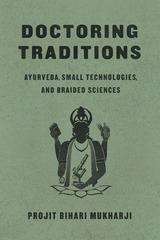 Doctoring Traditions: Ayurveda, Small Technologies, and Braided Sciences
Projit Bihari Mukharji
University of Chicago Press, 2016 Like many of the traditional medicines of South Asia, Ayurvedic practice transformed dramatically in the later nineteenth and early twentieth centuries. With Doctoring Tradition, Projit Bihari Mukharji offers a close look at that recasting, upending the widely held yet little-examined belief that it was the result of the introduction of Western anatomical knowledge and cadaveric dissection.
Rather, Mukharji reveals, what instigated those changes were a number of small technologies that were introduced in the period by Ayurvedic physicians, men who were simultaneously Victorian gentlemen and members of a particular Bengali caste. The introduction of these devices, including thermometers, watches, and microscopes, Mukharji shows, ultimately led to a dramatic reimagining of the body. By the 1930s, there emerged a new Ayurvedic body that was marked as distinct from a biomedical body. Despite the protestations of difference, this new Ayurvedic body was largely compatible with it. The more irreconcilable elements of the old Ayurvedic body were then rendered therapeutically indefensible and impossible to imagine in practice. The new Ayurvedic medicine was the product not of an embrace of Western approaches, but of a creative attempt to develop a viable alternative to the Western tradition by braiding together elements drawn from internally diverse traditions of the West and the East.
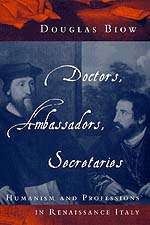 Doctors, Ambassadors, Secretaries: Humanism and Professions in Renaissance Italy
Douglas Biow
University of Chicago Press, 2002 In this book, Douglas Biow traces the role that humanists played in the development of professions and professionalism in Renaissance Italy, and vice versa. For instance, humanists were initially quite hostile to medicine, viewing it as poorly adapted to their program of study. They much preferred the secretarial profession, which they made their own throughout the Renaissance and eventually defined in treatises in the late sixteenth and early seventeenth centuries.
Examining a wide range of treatises, poems, and other works that humanists wrote both as and about doctors, ambassadors, and secretaries, Biow shows how interactions with these professions forced humanists to make their studies relevant to their own times, uniting theory and practice in a way that strengthened humanism. His detailed analyses of writings by familiar and lesser-known figures, from Petrarch, Machiavelli, and Tasso to Maggi, Fracastoro, and Barbaro, will especially interest students of Renaissance Italy, but also anyone concerned with the rise of professionalism during the early modern period.
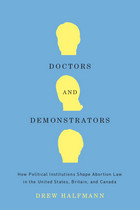 Doctors and Demonstrators: How Political Institutions Shape Abortion Law in the United States, Britain, and Canada
Drew Halfmann
University of Chicago Press, 2011 Since Roe v. Wade, abortion has continued to be a divisive political issue in the United States. In contrast, it has remained primarily a medical issue in Britain and Canada despite the countries’ shared heritage. Doctors and Demonstrators looks beyond simplistic cultural or religious explanations to find out why abortion politics and policies differ so dramatically in these otherwise similar countries. Drew Halfmann argues that political institutions are the key. In the United States, federalism, judicial review, and a private health care system contributed to the public definition of abortion as an individual right rather than a medical necessity. Meanwhile, Halfmann explains, the porous structure of American political parties gave pro-choice and pro-life groups the opportunity to move the issue onto the political agenda. A groundbreaking study of the complex legal and political factors behind the evolution of abortion policy, Doctors and Demonstrators will be vital for anyone trying to understand this contentious issue.
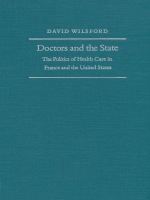 Doctors and the State: The Politics of Health Care in France and the United States
David Wilsford
Duke University Press, 1991 All advanced health care systems face severe difficulties in financing the delivery of today’s sophisticated medical care. In this study David Wilsford compares the health systems in France and the United States to demonstrate that some political systems are considerably more effective at controlling the cost of care than others. He argues that two variables—the autonomy of the state and the strength and cohesiveness of organized medicine—explain this variance.
In France, Wilsford shows, the state is strong in the health policy domain, while organized medicine is weak and divided. Consequently, physicians exercise little influence over health care policymaking. By contrast, in the United States the state is weak, the employers and insurers who pay for health care are fragmented, and organized medicine is strong and well financed. As a result, medical professionals are able to exert a greater influence on policymaking, thus making cost control more difficult.
Wilsford extends his comparison to health care systems in the United Kingdom, West Germany, Italy, Canada, and Japan. Whether the private or public sector finances health care, he discovers, there is now an important trend in all of the advanced industrial countries toward controlling escalating costs by curbing both the medical profession’s clinical autonomy and physicians’ incomes.
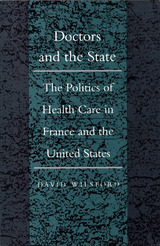 Doctors and the State: The Politics of Health Care in France and the United States
David Wilsford
Duke University Press All advanced health care systems face severe difficulties in financing the delivery of today’s sophisticated medical care. In this study David Wilsford compares the health systems in France and the United States to demonstrate that some political systems are considerably more effective at controlling the cost of care than others. He argues that two variables—the autonomy of the state and the strength and cohesiveness of organized medicine—explain this variance.
In France, Wilsford shows, the state is strong in the health policy domain, while organized medicine is weak and divided. Consequently, physicians exercise little influence over health care policymaking. By contrast, in the United States the state is weak, the employers and insurers who pay for health care are fragmented, and organized medicine is strong and well financed. As a result, medical professionals are able to exert a greater influence on policymaking, thus making cost control more difficult.
Wilsford extends his comparison to health care systems in the United Kingdom, West Germany, Italy, Canada, and Japan. Whether the private or public sector finances health care, he discovers, there is now an important trend in all of the advanced industrial countries toward controlling escalating costs by curbing both the medical profession’s clinical autonomy and physicians’ incomes.
Doctors and Their Workshops: Economic Models of Physician Behavior
Mark V. Pauly
University of Chicago Press, 1980 Doctors are obviously influential in determining the costs of their services. But even more important, many believe, is the influence physicians have over the use and cost of nonphysician health-care resources and services. Doctors and Their Workshops is the first comprehensive attempt to use economic analysis to understand some of the physician effects on nonphysician aspects of health care.
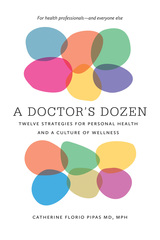 A Doctor's Dozen: Twelve Strategies for Personal Health and a Culture of Wellness
Catherine Florio Pipas
Dartmouth College Press, 2018 Burnout affects a third of our population and over half of our health professionals. For the second group, the impact is magnified, as consequences play out not only on a personal level, but also on a societal level and lead to medical errors, suboptimal care, low levels of patient satisfaction, and poor clinical outcomes. Achieving wellbeing requires strategies for change. In this book, Dr. Pipas shares twelve lessons and strategies for improved health that she has learned from patients, students, and colleagues over her twenty years working as a family physician. Each lesson is based on observation and research, and begins with a story of an exemplary patient whose challenges and successes reflect the theme of the lesson. Along with the lessons, the author offers plans for action, which taken together create the framework for a healthy life. Each lesson concludes with resources and a “health challenge.”
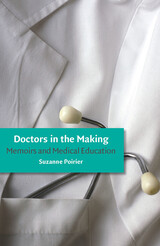 Doctors in the Making: Memoirs and Medical Education
Suzanne Poirier
University of Iowa Press, 2009 Recent surveys of medical students reveal stark conditions: more than a quarter have experienced episodes of depression during their medical school and residency careers, a figure much higher than that of the general population. Compounded by long hours of intellectually challenging, physically taxing, and emotionally exhausting work, medical school has been called one of the most harrowing experiences a student can encounter. Plumbing the diaries, memoirs, and blogs of physicians-in-training, Suzanne Poirier’s Doctors in the Making illuminates not just the process by which students become doctors but also the physical, emotional, and spiritual consequences of the process.
Through close readings of these accounts, Poirier draws attention to the complex nature of power in medicine, the rewards and hazards of professional and interpersonal relationships in all aspects of physicians’ lives, and the benefits to and threats from the vulnerability that medical students and residents experience.
Although most students emerge from medical education as well-trained, well-prepared professionals, few of them will claim that they survived the process unscathed. The authors of these accounts document—for better or for worse—the ways in which they have been changed. Based on their stories, Poirier recommends that medical education should make room for the central importance of personal relationships, the profound sense of isolation and powerlessness that can threaten the wellbeing of patients and physicians alike, and the physical and moral vulnerability that are part of every physician’s life.
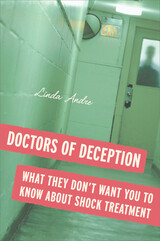 Doctors of Deception: What They Don't Want You to Know about Shock Treatment
Andre, Linda
Rutgers University Press, 2009 Mechanisms and standards exist to safeguard the health and welfare of the patient, but for electroconvulsive therapy (ECT)—used to treat depression and other mental illnesses—such approval methods have failed. Prescribed to thousands over the years, public relations as opposed to medical trials have paved the way for this popular yet dangerous and controversial treatment option.
Doctors of Deception is a revealing history of ECT (or shock therapy) in the United States, told here for the first time. Through the examination of court records, medical data, FDA reports, industry claims, her own experience as a patient of shock therapy, and the stories of others, Andre exposes tactics used by the industry to promote ECT as a responsible treatment when all the scientific evidence suggested otherwise.
As early as the 1940s, scientific literature began reporting incidences of human and animal brain damage resulting from ECT. Despite practitioner modifications, deleterious effects on memory and cognition persisted. Rather than discontinue use of ECT, the $5-billion-per-year shock industry crafted a public relations campaign to improve ECT’s image. During the 1970s and 1980s, psychiatry’s PR efforts misled the government, the public, and the media into believing that ECT had made a comeback and was safe.
Andre carefully intertwines stories of ECT survivors and activists with legal, ethical, and scientific arguments to address issues of patient rights and psychiatric treatment. Echoing current debates about the use of psychopharmaceutical interventions shown to have debilitating side-effects, she candidly presents ECT as a problematic therapy demanding greater scrutiny, tighter control, and full disclosure about its long-term cognitive effects.
 Doctors' Plot of 1953
Yakov Rapoport
Harvard University Press, 1991 On January 13, 1953, the official press agency Tass announced the arrest of a group of "killer doctors" who were systematically doing away with prominent public figures in the Soviet Union. Nine doctors, six of them Jews, were cited, and in the next few weeks many more were carted off to the dread prisons of Lubyanka and Lefortovo. Among them was Yakov Lvovich Rapoport, a distinguished pathologist; this book is a firsthand memoir of his imprisonment, revealing not only the suffering caused by a fabricated "plot" but also the devastating climate of antisemitism and the appalling disarray of medicine and science in the Stalinist era.
Rapoport outlines the background of the infamous incident: arrests of prominent physicians had begun in 1952 and created hysteria throughout the country. Clinics were empty, patients refused professional medical advice, rumors abounded of poisoned medicines in pharmacies and murdered infants in maternity wards. Public opinion was primed to accept the Doctors' Plot, and to this day no one knows how many hundreds or thousands of doctors, prominent and ordinary, were victimized. Rapoport himself was arrested in early February, and he recalls in meticulous detail the psychological and physical pain he endured, all the while steadfastly denying that there was any conspiracy. He was saved from certain execution only by the death of Stalin.
The Doctors' Plot of 1953 is the gripping story of a brave man that gives a dismal picture of what life—especially for intellectuals and for Jews—was like in the Soviet Union under the paranoid Stalin. There is much information on the distortion of biology by Lysenko, the demagogic elevation of such charlatans as Olga Lepeshinskaya, the fictitious murder of Gorky and the quite likely murder of Frunze, and other mind-boggling examples of the surrealistic politics of Soviet science.
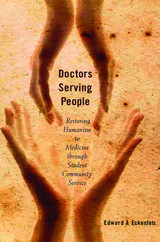 Doctors Serving People: Restoring Humanism to Medicine through Student Community Service
Eckenfels, Edward J
Rutgers University Press, 2008 Today's physicians are medical scientists, drilled in the basics of physiology, anatomy, genetics, and chemistry. They learn how to crunch data, interpret scans, and see the human form as a set of separate organs and systems in some stage of disease. Missing from their training is a holistic portrait of the patient as a person and as a member of a community. Yet a humanistic passion and desire to help people often are the attributes that compel a student toward a career in medicine. So what happens along the way to tarnish that idealism? Can a new approach to medical education make a difference?
Doctors Serving People is just such a prescriptive. While a professor at Rush Medical College in Chicago, Edward J. Eckenfels helped initiate and direct a student-driven program in which student doctors worked in the poor, urban communities during medical school, voluntarily and without academic credit. In addition to their core curriculum and clinical rotations, students served the social and health needs of diverse and disadvantaged populations. Now more than ten years old, the program serves as an example for other medical schools throughout the country. Its story provides a working model of how to reform medical education in America.
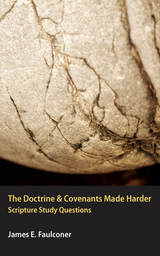 The Doctrine & Covenants Made Harder
James E. Faulconer
Neal A. Maxwell Institute for Religious Scholarship, 2014 Latter-day Saint philosopher James E. Faulconer’s Made Harder series raises many more questions than it answers. And that is precisely the point. Faulconer wrote The Doctrine & Covenants Made Harder on the premise that our scripture study is only as good as the questions we bring to the endeavor. The book consists almost entirely of challenging questions (with occasional commentary for clarity’s sake) because, in Faulconer’s experience, questions themselves are the key to reflective and deep scripture study. This book is intended to make reading harder—and therefore fresher—by priming your pondering pump with insightful study questions. The Doctrine & Covenants Made Harder is the perfect tool to improve personal and family scripture study, sacrament meeting talks, or Sunday School lessons. So much of modern life is geared to finding faster and easier ways to do the same old things. The Made Harder series is proof that making things easier does not always make them better.
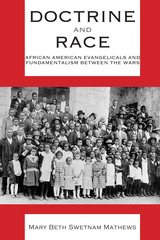 Doctrine and Race: African American Evangelicals and Fundamentalism between the Wars
Mary Beth Swetnam Mathews
University of Alabama Press, 2017 Doctrine and Race examines the history of African American Baptists and Methodists of the early twentieth century and their struggle for equality in the context of white Protestant fundamentalism.
By presenting African American Protestantism in the context of white Protestant fundamentalism, Doctrine and Race: African American Evangelicals and Fundamentalism between the Wars demonstrates that African American Protestants were acutely aware of the manner in which white Christianity operated and how they could use that knowledge to justify social change. Mary Beth Swetnam Mathews’s study scrutinizes how white fundamentalists wrote blacks out of their definition of fundamentalism and how blacks constructed a definition of Christianity that had, at its core, an intrinsic belief in racial equality. In doing so, this volume challenges the prevailing scholarly argument that fundamentalism was either a doctrinal debate or an antimodernist force. Instead, it was a constantly shifting set of priorities for different groups at different times.
A number of African American theologians and clergy identified with many of the doctrinal tenets of the fundamentalism of their white counterparts, but African Americans were excluded from full fellowship with the fundamentalists because of their race. Moreover, these scholars and pastors did not limit themselves to traditional evangelical doctrine but embraced progressive theological concepts, such as the Social Gospel, to help them achieve racial equality. Nonetheless, they identified other forward-looking theological views, such as modernism, as threats to “true” Christianity.
Mathews demonstrates that, although traditional portraits of “the black church” have provided the illusion of a singular unified organization, black evangelical leaders debated passionately among themselves as they sought to preserve select aspects of the culture around them while rejecting others. The picture that emerges from this research creates a richer, more profound understanding of African American denominations as they struggled to contend with a white American society that saw them as inferior.
Doctrine and Race melds American religious history and race studies in innovative and compelling ways, highlighting the remarkable and rich complexity that attended to the development of African American Protestant movements.
 The Doctrine of Double Effect: Philosophers Debate a Controversial Moral Principle
P. A. Woodward
University of Notre Dame Press, 2001 This anthology of philosophical essays, gathered from numerous sources, provides a convenient, in-depth introduction to the Doctrine of Double Effect. A number of important philosophers and intellectual perspectives are represented in what constitutes a debate over the doctrine and the various concerns it raises. Philosophers represented in these readings include Joseph M. Boyle, Jr., Warren Quinn, G.E.M. Anscombe, Thomas Nagel, Phillippa Foot, Jonathan Bennett, Nancy Davis, Donald Marquis, and many others.
The Doctrine of Double Effect is a principle of reasoning well known to moral philosophers. The standard formulation of the doctrine states that it is "licit to posit a cause which is either good or indifferent from which there follows a twofold effect, one good, the other evil, if a proportionally grave reason is present, and if the end of the agent is honorable."
According to this doctrine, an effect that would be considered morally wrong if it were the intentional outcome of an act could be morally permissible if it were the unintended effect of that act, even if it had been foreseen. As a method of drawing moral distinctions between the intentional and unintentional production of evil, the doctrine has had a long history. It has often been employed, for example, in debates about "just war" and the kinds of acts that are permissible in war.
The first section of this collection offers an introduction to the doctrine, its purpose, its claims, and the issues it raises for moral philosophers. Sections two and three take the form of a debate by several influential thinkers about the validity of the doctrine and the many problems surrounding it. The authors in section two defend the doctrine; those in section three oppose it. Sections four and five focus on applications, concrete and theoretical, of the doctrine, showing its possible uses and misuses.
This book will be valuable to teachers and students of philosophy as well as others interested in a clear understanding of this controversial doctrine.
Contributors: G. E. M. Anscombe, Greg Beabout, Jonathan Bennett, Joseph M. Boyle, Jr., William Cooney, David Copp, Nancy Davis, Stanislaus J. Dundon, John Martin Fischer, Philippa Foot, Jeff Jordan, Donald B. Marquis, Robert M. Martin, Thomas Nagel, Warren S. Quinn, Mark Ravizza, Michael Walzer, and P. A. Woodward.
DOCTRINE OF SIGNATURES: A DEFENSE OF THEORY IN MEDICINE
Scott Buchanan
University of Illinois Press, 1991 "The Doctrine of Signatures
is one of the first and most significant works in our time to show how closely
connected the liberal arts are to clinical medicine. It is the seminal work
in the recent history of the philosophy of medicine, a field that is enjoying
a renaissance throughout the world today."
-- Edmund D. Pellegrino, M.D.
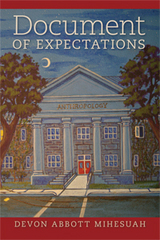 Document of Expectations
Devon Abbott Mihesuah
Michigan State University Press, 2011 When Hopi/White Mountain Apache anthropologist Tony M. Smokerise is found murdered in his office at Central Highlands University, the task of solving the crime falls to jaded Choctaw detective Monique Blue Hawk and her partner Charles T. Clarke. A seemingly tolerant and amicable office of higher education, the university, Monique soon learns, harbors parties determined to destroy the careers of Tony and his best friend, the volatile Oglala anthropologist Roxanne Badger. In the course of her investigation, Monique discovers that the scholars who control Tony’s department are also overseeing the excavation of a centuries-old tribal burial site that was uncovered during the construction of a freeway. Tony’s role in the project, she realizes, might be the key to identifying his murderer. This virtuosic mystery novel explores, in engrossing detail, the complex motives for a killing within the sometimes furtive and hermetic setting of academia.
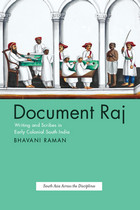 Document Raj: Writing and Scribes in Early Colonial South India
Bhavani Raman
University of Chicago Press, 2012 Historians of British colonial rule in India have noted both the place of military might and the imposition of new cultural categories in the making of Empire, but Bhavani Raman, in Document Raj, uncovers a lesser-known story of power: the power of bureaucracy. Drawing on extensive archival research in the files of the East India Company’s administrative offices in Madras, she tells the story of a bureaucracy gone awry in a fever of documentation practices that grew ever more abstract—and the power, both economic and cultural, this created. In order to assert its legitimacy and value within the British Empire, the East India Company was diligent about record keeping. Raman shows, however, that the sheer volume of their document production allowed colonial managers to subtly but substantively manipulate records for their own ends, increasingly drawing the real and the recorded further apart. While this administrative sleight of hand increased the company’s reach and power within the Empire, it also bolstered profoundly new orientations to language, writing, memory, and pedagogy for the officers and Indian subordinates involved. Immersed in a subterranean world of delinquent scribes, translators, village accountants, and entrepreneurial fixers, Document Raj maps the shifting boundaries of the legible and illegible, the legal and illegitimate, that would usher India into the modern world.
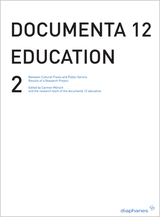 documenta 12 education 2: Between Critical Practice and Visitor Services Results of a Research Project
Edited by Carmen Mörsch
Diaphanes, 2009 »Cultural Education« is much debated. It is pivotal in sustaining a sense of community in a society that is constantly shifting. A space where differences can be explored, art exhibitions act as a superb medium for cultural and aesthetic education. They don‘t aspire to peace and harmony but to stage controversy. They enable multiple models of communication, open to dissent and rupture.
Education is situated in tension between public sphere and institution, amateur and professional, artist and audience. Its development needs felicitous examples as well as rigor in discussing problems towards identifying practical solutions.
»documenta 12 education« presents in two illustrated volumes the education formats with concomitant research, providing a basis for developing theory and praxis of gallery education.
These volumes are an ideal resource for people working in the fields of curating exhibitions, gallery education, youth work and cultural policy. People less familiar with cultural work will find in these books a valuable introduction to the field of gallery education.
Volume 2 focuses on a theory of gallery education, its methods and contexts, and reflects theoretically on examples presented in Volume 1. It is addressed to professionals from the field of gallery education, cultural education and formal education.
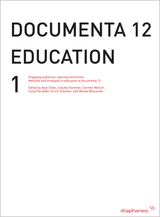 documenta 12 education I: Engaging audiences, opening institutions Methods and strategies in education at documenta 12
Edited by Ayse Güleç, Claudia Hummel, Ulrich Schötker, and Wanda Wieczorek
Diaphanes, 2009 »Cultural Education« is much debated. It is pivotal in sustaining a sense of community in a society that is constantly shifting. A space where differences can be explored, art exhibitions act as a superb medium for cultural and aesthetic education. They don‘t aspire to peace and harmony but to stage controversy. They enable multiple models of communication, open to dissent and rupture.
Education is situated in tension between public sphere and institution, amateur and professional, artist and audience. Its development needs felicitous examples as well as rigor in discussing problems towards identifying practical solutions.
»documenta 12 education« presents in two illustrated volumes the education formats with concomitant research, providing a basis for developing theory and praxis of gallery education.
These volumes are an ideal resource for people working in the fields of curating exhibitions, gallery education, youth work and cultural policy. People less familiar with cultural work will find in these books a valuable introduction to the field of gallery education.
Volume 1 gives a comprehensive and richly illustrated survey of formats and models of education and collaboration with the public at documenta 12.
Documentary Dilemmas: Frederick Wiseman's Titicut Follies
Carolyn Anderson and Thomas W. Benson
Southern Illinois University Press, 1991 A case history of the only American film under court-imposed restrictions for reasons other than obscenity or national security. Titicut Follies is an excoriating depiction of conditions in the Massachusetts Correctional Institution at Bridgewater, a prison-hospital for the criminally insane. The Commonwealth of Massachusetts took Wiseman to court, seeking to prevent the exhibition of Titicut Follies soon after its release in 1967. This account of the Titicut Follies case is based on ten years of research and relies on interviews, journalistic accounts, and especially on the legal record, including the Commonwealth v. Wiseman transcript, to describe the entire process of independent documentary filmmaking. The trials of Titicut Follies raise crucial questions about the relation of social documentary to its subjects and audiences.
Documentary Expression and Thirties America
William Stott
University of Chicago Press, 1986 "A comprehensive inquiry into the attitudes and ambitions that characterized the documentary impulse of the thirties. The subject is a large one, for it embraces (among much else) radical journalism, academic sociology, the esthetics of photography, Government relief programs, radio broadcasting, the literature of social work, the rhetoric of political persuasion, and the effect of all these on the traditional arts of literature, painting, theater and dance. The great merit of Mr. Stott's study lies precisely in its wide-ranging view of this complex terrain."—Hilton Kramer, New York Times Book Review
"[Scott] might be called the Aristotle of documentary. No one before him has so comprehensively surveyed the achievement of the 1930s, suggesting what should be admired, what condemned, and why; no one else has so persuasively furnished an aesthetic for judging the form."—Times Literary Supplement
 The Documentary Heritage Of Ohio
Phillip R. Shriver
Ohio University Press, 2010 Key to the successful teaching and learning of history is its personalization. In presenting documents that help Ohio’s rich history come alive in the minds of its readers, this book has purposely sought to provide eyewitness, first-person narratives that will make the reader want to turn the page and keep on reading. At the same time, mindful of the significance of guideposts basic to our understanding of the development of the state, care has been taken to include those documents such as constitutions, laws, and ordinances that have truly made a difference in the shaping of our institutions and the lives of our people. With informative and accessible introductions to each document, editors Shriver and Wunderlin have produced a book of record that reveals the sources of Ohio’s heritage. The Documentary Heritage of Ohio is the second volume in the Ohio Bicentennial Series and a must for all libraries, schools, and the bookshelves of any who wish to appreciate the state’s historic accomplishments and rich heritage not only for the bicentennial of statehood in 2003 but for many years to come.
A Documentary History of Arkansas
C. Fred Williams
University of Arkansas Press, 2013 A Documentary History of Arkansas provides a comprehensive look at Arkansas history from the state's earliest events to the present. Here are newspaper articles, government bulletins, legislative acts, broadsides, letters, and speeches that, taken collectively, give a firsthand glimpse at how the twenty-fifth state's history was made. Enhanced by additional documents and brought up to date since its original publication in 1984, this new edition is the standard source for essential primary documents illustrating the state's political, social, economic, educational, and environmental history.
A Documentary History of Arkansas
C. Fred Williams
University of Arkansas Press This collection of documents represents a behind-the-scenes look at Arkansas from earliest times to 1984. Here are newspaper articles, government bulletins, legislative acts, broadsides, letters, and speeches. Collectively, they give a firsthand glimpse at how the twenty-fifth state’s history was made. Consideration is given to social and cultural aspects of Arkansas history, with special attention focused on the role played by women and blacks.
A Documentary History of Communism and the World: From Revolution to Collapse
Edited by Robert V. Daniels
Brandeis University Press, 1994 In the ten years since the last edition of this book, the world has undergone tremendous and, seemingly irrevocable change. With the virtual demise of the international communist movement and the increasing isolation of the remaining old-style regimes, communism has become history. Robert V. Daniels has updated his definitive work to chronicle the last years of international communism. It contains a new chapter with 22 documents pertaining to such key ideas and events as perestroika, the Velvet Revolution in Czechoslovakia, the dissolution of the Warsaw Pact, and the Tiananmen Massacre. Together with his Documentary History of Communism in Russia, this book provides a complete documentary history of the communist movement from Lenin and world revolution to Gorbachev and the end of world communism.
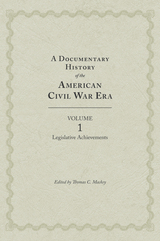 A Documentary History of the American Civil War Era: Volume 1, Legislative Achievements
Thomas C. Mackey
University of Tennessee Press, 2012 A Documentary History of the American Civil War Era is the first comprehensive collection of public policy actions, political speeches, and judicial decisions related to the American Civil War. This three-volume set gives scholars, teachers, and students easy access to the full texts of the most important, fundamental documents as well as hard-to-find, rarely published primary sources on this critical period in U.S. history.
The first volume of the series, Legislative Achievements, contains legislation passed in response to the turmoil seizing the country on the brink of, during, and in the wake of the Civil War. Forthcoming are volume 2, Political Arguments, which contains voices of politicians, political party platforms, and administrative speeches, and volume 3, Judicial Decisions, which provides judicial opinions and decisions as the Civil War raged in the courtrooms as well as on the battlefields.
Organized chronologically, each of the selections is preceded by an introductory headnote that explains the document’s historical significance and traces its lasting impact. These headnotes provide insight into not only law and public policy but also the broad sweep of issues that engaged Civil War–era America.
Legislative Achievements features some of the most momentous and enduring public policy documents from the time, beginning with the controversial September 15, 1850, Fugitive Slave Act and concluding with the June 18, 1878, Posse Comitatus Act. Both military and nonmilitary legislation constitute this part, including the April 19, 1861, proclamation by President Abraham Lincoln declaring a naval blockade on Southern ports and Confederate President Jefferson Davis’s proclamation authorizing blockade runners to attack Northern shipping, both issued on the same day. Nonmilitary legislation includes statutes affecting the postwar period, such as the 1862 Homestead Act, the Civil Rights Act of 1866, and all four of the Reconstruction Acts. Also in this section are the three constitutional amendments, the Habeas Corpus Acts of 1863 and 1867, the Freedman’s Bureau Acts of 1865 and 1866, and the 1867 Tenure of Office Act together with President Andrew Johnson’s message vetoing the Act.
A Documentary History of the American Civil War Era is an essential acquisition for academic and public libraries in addition to being a valuable resource for students of the Civil War and Reconstruction, legal history, public policy, and nineteenth-century American history.
THOMAS C. MACKEY is a professor of history at the University of Louisville and adjunct Professor of Law at Brandeis School of Law. He is the author of Pornography on Trial (2002) and Pursuing Johns (2005).
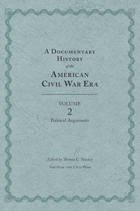 A Documentary History of the American Civil War Era: Volume 2, Political Arguments
Thomas C. Mackey
University of Tennessee Press, 2013 A Documentary History of the American Civil War Era is the first comprehensive collection of public policy actions, political speeches, and judicial decisions related to the American Civil War. This three-volume set gives scholars and students easy access to the full texts of both the most important, fundamental documents as well as hard-to-find, rarely published primary sources on this critical period in U.S. history.
Volume 2 in the series, Political Arguments, presents the words of politicians, political party platforms, and administrative speeches. It is divided into two sections. The first, Voices of the Politicians and Political Parties, comprises the platforms of the major (and some minor) parties from1856 to 1876. Also included are such pieces as Robert E. Lee’s letter of resignation from the U.S. Army, a few key speeches by that rising politician from Illinois, Abraham Lincoln, and a letter on the “American Question” written by a European observer, Karl Marx. Other items include examples of the 1860–1861 state ordinances of secession and addresses on emancipation and Reconstruction by Jefferson Davis and by the Republican leader in the House of Representatives, Thaddeus Stevens.
Section two, Voices of the Administrations, contains records from the presidencies of James Buchanan, Abraham Lincoln, Andrew Johnson, Ulysses S. Grant, and Rutherford B. Hayes as well as a message from Confederate President Jefferson Davis telling his congress that the Southern cause was “just and holy.” Classic documents such as Lincoln’s announcement of forthcoming emancipation and the Emancipation Proclamation are here, as are lesser-known but important documents such as Francis Lieber’s 1863 revised law code for war, General Order 100, and Attorney General James Speed’s 1865 opinion supporting the Johnson administration’s decision to try the Lincoln murder conspirators by special military commission and not in the civilian courts.
Each of the selections in <i>Political Arguments<i> is preceded by editor Thomas Mackey’s introductory headnotes that explain the document’s historical significance and trace its lasting impact. These commentaries provide insight into not just law and public policy but also the broad sweep of issues important to Civil War– era Americans.
A Documentary History of the American Civil War Era is an essential acquisition for academic and public libraries in addition to being a valuable resource for courses on the War and Reconstruction, legal history, political history, and nineteenth- century American history.
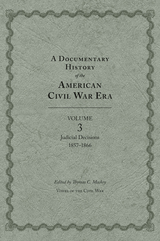 A Documentary History of the American Civil War Era: Volume 3, Judicial Decisions, 1857-1866
Thomas C. Mackey
University of Tennessee Press, 2014 A Documentary History of the American Civil War Era is the first comprehensive collection of public policy actions, political speeches, and judicial decisions related to the American Civil War. Collectively, the four volumes in this series give scholars, teachers, and students easy access to the full texts of the most important, fundamental documents as well as hard-to-find, rarely published primary sources on this critical period in U.S. history.
The first two volumes of the series, Legislative Achievements and Political Arguments, were released last year. The final installments, Judicial Decisions, is split into two volumes, with this one, volume 3, spanning from 1857 to 1866. It contains some of the classic judicial decisions of the time such as the 1857 decision in Dred Scott and the 1861 Ex parte Merryman decision. Other decisions are well known to specialists but deserve wider readership and discussion, such as the October 1859 Jefferson County, Virginia, indictment of John Brown and the decision in the 1864 case of political and seditious activity in Ex parte Vallandigham. These judicial voices constitute a lasting and often overlooked aspect of the age of Abraham Lincoln. Mackey’s headnotes and introductory essays situate cases within their historical context and trace their lasting significance. In contrast to the war, these judicial decisions lasted well past their immediate political and legal moment and deserve continued scholarship and scrutiny.
This document collection presents the raw “stuff” of the Civil War era so that students, scholars, and interested readers can measure and gauge how that generation met Lincoln’s challenge to “think anew, and act anew.” A Documentary History of the American Civil War Era is an essential acquisition for academic and public libraries in addition to being a valuable resource for courses on the Civil War and Reconstruction, legal history, political history, and nineteenth-century American history.
Thomas C. Mackey is a professor of history at the University of Louisville and adjunct Professor of Law at Brandeis School of Law. He is the author of Pornography on Trial and Pursuing Johns.
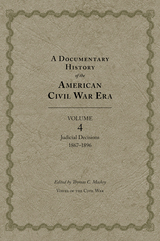 A Documentary History of the American Civil War Era: Volume 4, Judicial Decisions, 1867–1896
Thomas C. Mackey
University of Tennessee Press, 2012 A Documentary History of the American Civil War Era is the first comprehensive collection
of public policy actions, political speeches, and judicial decisions related to the American
Civil War. Collectively, the four volumes in this series give scholars, teachers, and students
easy access to the full texts of the most important, fundamental documents as well as hardto-
find, rarely published primary sources on this critical period in U.S. history.
The first two volumes of the series, Legislative Achievements and Political Arguments,
were released last year. The final installment, Judicial Decisions, is divided into two volumes.
The first volume, spanning the years 1857 to 1866, was released last year. This second
volume of Judicial Decisions covers the years 1867 to 1896. Included here are some of
the classic judicial decisions of this time such as the 1869 decision in Texas v. White and
the first judicial interpretation of the 1868 Fourteenth Amendment, the 1873 Slaughter-
House Cases. Other decisions are well known to specialists but deserve wider readership
and discussion, such as the 1867 state and 1878 federal cases that upheld the separation of
the races in public accommodations (and thus constituted the common law of common
commerce) long before the more notorious 1896 case of Plessy v. Ferguson (also included).
These judicial voices constitute a lasting and often overlooked aspect of the age of Abraham
Lincoln. Mackey’s headnotes and introductory essays situate cases within their historical
context and trace their lasting significance. In contrast to decisions handed down
during the war, these judicial decisions lasted well past their immediate political and legal
moment and deserve continued scholarship and scrutiny.
This document collection presents the raw “stuff” of the Civil War era so that students,
scholars, and interested readers can measure and gauge how that generation met Lincoln’s
challenge to “think anew, and act anew.” A Documentary History of the American Civil
War Era is an essential acquisition for academic and public libraries in addition to being a
valuable resource for courses on the Civil War and Reconstruction, legal history, political
history, and nineteenth-century American history.
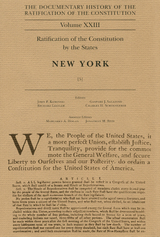 Documentary History of the Ratification of the Constitution, Volume 23: Ratification of the Constitution by the States: New York, No. 5
Edited by John P. Kaminski and Gaspare J. Saladino; Senior Associate Editor: Richard Leffler; Associate Editor: Charles H. Schoenleber; Assistant Editor: Margaret A. Hogan
Wisconsin Historical Society Press, 2009 This is the fifth and final volume documenting New York State's ratification of the Constitution. This particular volume includes the complete record of the state ratifying convention. In addition to the official journal and the proceedings and debates of the convention, the volume contains many documents never before published, including the voluminous notes of the secretary of the convention and several of the convention delegates, the correspondence of delegates and spectators at the convention, and the rich newspaper commentaries describing the day-by-day events in the convention. For the first time, historians will be able to see how the New York convention - dominated by a two-thirds majority of Antifederalists - came to adopt the Constitution. This documentary series is a research tool of remarkable power, an unrivaled work for historical and legal scholars, librarians, and students of the Constitution.
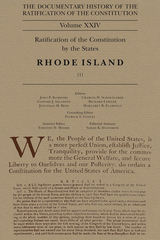 Documentary History of the Ratification of the Constitution, Volume 24: Ratification of the Constitution by the States: Rhode Island, No. 1
Kaminski
Wisconsin Historical Society Press, 2011 This is the first of three volumes documenting Rhode Island's public and private debates about the Constitution. This documentary series is a research tool of remarkable power, an unrivaled reference work for historical and legal scholars, librarians, and students of the Constitution. The volumes are encyclopedic, consisting of manuscript and printed documents-contemporary newspapers, broadsides, and pamphlets-compiled from hundreds of sources, copiously annotated, thoroughly indexed, and often accompanied by microfiche supplements. Pulitzer Prize-winning historian Michael Kammen has noted that The Documentary History of the Ratification of the Constitution series "will be of enduring value centuries hence" and described it as "one of the most interesting documentary publications we have ever had." The American Bar Association Journal has stated, "Each new volume now fills another vital part of the mosaic of national history."
 The Documentary History of the Ratification of the Constitution, Volume 25: Ratification of the Constitution by the States: Rhode Island, No. 2
John P. Kaminski
Wisconsin Historical Society Press, 2012 This is the second of three volumes documenting Rhode Island's public and private debates about the Constitution. This documentary series is a research tool of remarkable power, an unrivaled reference work for historical and legal scholars, librarians, and students of the Constitution. The volumes are encyclopedic, consisting of manuscript and printed documents-contemporary newspapers, broadsides, and pamphlets-compiled from hundreds of sources, copiously annotated, thoroughly indexed, and often accompanied by microfiche supplements.
Pulitzer Prize-winning historian Michael Kammen has noted that The Documentary History of the Ratification of the Constitution series "will be of enduring value centuries hence" and described it as "one of the most interesting documentary publications we have ever had." The American Bar Association Journal has stated, "Each new volume now fills another vital part of the mosaic of national history."
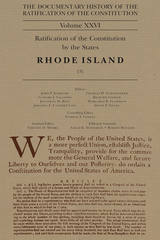 The Documentary History of the Ratification of the Constitution Volume 26: Ratification of the Constitution by the States, Rhode Island, No. 3
John P. Kaminski
Wisconsin Historical Society Press, 2013 This is the third and final volume documenting Rhode Island's public and private debates about the Constitution. This documentary series is a research tool of remarkable power, an unrivaled reference work for historical and legal scholars, librarians, and students of the Constitution. The volumes are encyclopedic, consisting of manuscript and printed documents-contemporary newspapers, broadsides, and pamphlets-compiled from hundreds of sources, copiously annotated, thoroughly indexed, and often accompanied by microfiche supplements.
Pulitzer Prize-winning historian Michael Kammen has noted that The Documentary History of the Ratification of the Constitution series "will be of enduring value centuries hence" and described it as "one of the most interesting documentary publications we have ever had." The American Bar Association Journal has stated, "Each new volume now fills another vital part of the mosaic of national history."
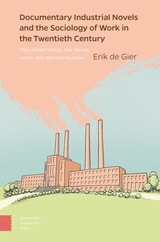 Documentary Industrial Novels and the Sociology of Work in the Twentieth Century: The United States, the Soviet Union and Western Europe
Erik de Gier
Amsterdam University Press, 2023 In several European countries, the United States, and the Soviet Union, remarkable industrial novels based on empirical observations were written between 1900 and 1970. With two successive world wars and the rise of communism and fascism, this was an exceptionally turbulent time in the history of industrial capitalism as Taylorism and Fordism sought to increase production and consumption. This social landscape shaped modernist industrial novels. Key themes in these novels were class conflict, bad working conditions, worker alienation, changing workmen and employee cultures, urbanization, and worker migration. The primary goal was to document and publicize the real developments of working conditions in factories and offices, often aiming to influence both company welfare work and state social policies. This book focuses on the modernist industrial novel as written in five large industrial nations: the United States before WWII, the Stalinist Soviet Union, Weimar Germany, post-WWII Italy, and France.
The Documentary Politics of Conquered England's Queens: New Translations of the "Encomium of Queen Emma" and the "Life of King Edward"
Jacob Bell
Arc Humanities Press, 2025 This book provides new and approachable translations of two important medieval artifacts: the Encomium of Queen Emma and the Life of King Edward. Sponsored by royal women—Emma of Normandy, wife of two English kings and mother to two more; and Edith of Wessex, the wife of Edward the Confessor and sister to Harold Godwineson—these texts place the politics of history writing centre-stage against the backdrop of the Anglo-Scandinavian regime of Cnut the Great and the Norman Conquest of 1066. Readers will encounter the drama and pageantry of civil war, invasion, and resistance through the eyes of the queens behind the thrones.
Documentary Sources on the History of Rus’ Metropolitanate: The Fourteenth to the Early Sixteenth Centuries
Andrei I. Pliguzov
Harvard University Press Documentary Sources on the History of Rus’ Metropolitanate contains an extensive collection of letters and documents relating to the late medieval Orthodox Church, edited and curated by the renowned medievalist Andrei Pliguzov. This volume includes acts, edicts, and decrees regarding the lands in the metropolitanate’s jurisdiction; reports prepared for the metropolitans by their secretariat; and the letters of the hierarchs themselves. These documents pertain to all aspects of the metropolitanate’s activity and reflect the various concerns and debates that defined the life of the Church and its relations with other religious entities and the secular leaders.
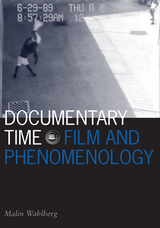 Documentary Time: Film and Phenomenology
Malin Wahlberg
University of Minnesota Press, 2008 Finding the theoretical space where cinema and philosophy meet, Malin Wahlberg’s sophisticated approach to the experience of documentary film aligns with attempts to reconsider the premises of existential phenomenology. The configuration of time is crucial in organizing the sensory affects of film in general but, as Wahlberg adroitly demonstrates, in nonfiction films the problem of managing time is writ large by the moving image’s interaction with social memory and historical figures. Wahlberg discusses a thought-provoking corpus of classical and recent experiments in film and video (including Andy Warhol’s films) in which creative approaches to the time of the image and the potential archive memory of filmic representation illuminates meanings of temporality and time experience. She also offers a methodological account of film and brings Deleuze and Ricoeur into dialogue with Bazin and Mitry on the subject of cinema and phenomenology. Drawing attention to the cultural significance of the images’ imprint as a trace of the past, Documentary Time brings to bear phenomenological inquiry on nonfiction film while at the same time reconsidering the existential dimensions of time that have always puzzled humans. Malin Wahlberg is a research fellow in cinema studies at Stockholm University.
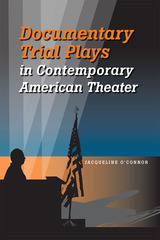 Documentary Trial Plays in Contemporary American Theater
Jacqueline O’Connor
Southern Illinois University Press, 2013 From the Chicago Conspiracy Trial and the O. J. Simpson trial to the Clarence Thomas/Anita Hill congressional hearings, legal and legislative proceedings in the latter part of the twentieth-century kept Americans spellbound. Situated on the shifting border between imagination and the law, trial plays edit, arrange, and reproduce court records, media coverage, and first-person interviews, transforming these elements into a performance. In this first book-length critical study of contemporary American documentary theater, Jacqueline O’Connor examines in depth ten such plays, all written and staged since 1970, and considers the role of the genre in re-creating and revising narratives of significant conflicts in contemporary history. Documentary theater, she shows, is a particularly appropriate and widely utilized theatrical form for engaging in debate about tensions between civil rights and institutional power, the inconsistency of justice, and challenges to gender norms. For each of the plays discussed, including The Trial of the Catonsville Nine, Unquestioned Integrity: The Hill/Thomas Hearings, and The Laramie Project, O'Connor provides historical context and a brief production history before considering the trial the play focuses on. Grouping plays historically and thematically, she demonstrates how dramatic representation advances our understanding of the law's power while revealing the complexities that hinder society's pursuit of justice.
 The Documented Child: Migration, Personhood, and Citizenship in Twenty-First-Century U.S. Latinx Children's Literature
Maya Socolovsky
University of Arizona Press, 2025 Immigration is at once a personal, immediate, and urgent issue that plays a central role in the United States’ perception of itself. In The Documented Child, scholar Maya Socolovsky demonstrates how the portrayal of Latinx children has shifted over the first two decades of the twenty-first century in literary texts aimed at children and young adults and looks at how these shifts map onto broader changes in immigration policy and discourse. Through a critical inquiry into picture books and middle-grade and young adult literature, Socolovsky argues that the literary documentations of—and for—U.S. Latinx children have shifted over the decades, from an emphasis on hybrid transnationalism to that of a more American-oriented self. Socolovsky delves into texts written from 1997 to 2020, a period marked by tremendous changes in U.S. immigration policies, amplified discourses around nationhood, and an increasingly militarized border. The author shows how children’s and young adult books have shifted their depictions of the border, personal and national identity, and sovereignty. For students, scholars, and educators of Latinx studies and children’s literature, this work shows how the creators of children’s literature reflect new strategies for representing the undocumented Latinx child protagonist. While earlier books document the child as a transnational (sometimes global) subject, later books document her as both a transnational and U.S. national subject. The Documented Child explores this change as a necessary survival strategy, reflecting current awareness that cultural hybridity and transnational identity are not sufficient stand-ins for the stability and security of legal personhood.
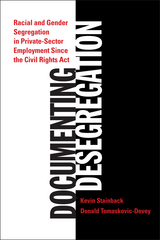 Documenting Desegregation: Racial and Gender Segregation in Private Sector Employment Since the Civil Rights Act
Kevin Stainback
Russell Sage Foundation, 2013 Enacted nearly fifty years ago, the Civil Rights Act codified a new vision for American society by formally ending segregation and banning race and gender discrimination in the workplace. But how much change did the legislation actually produce? As employers responded to the law, did new and more subtle forms of inequality emerge in the workplace? In an insightful analysis that combines history with a rigorous empirical analysis of newly available data, Documenting Desegregation offers the most comprehensive account to date of what has happened to equal opportunity in America—and what needs to be done in order to achieve a truly integrated workforce. Weaving strands of history, cognitive psychology, and demography, Documenting Desgregation provides a compelling exploration of the ways legislation can affect employer behavior and produce change. Authors Kevin Stainback and Donald Tomaskovic-Devey use a remarkable historical record—data from more than six million workplaces collected by the U.S. Equal Employment Opportunity Commission (EEOC) since 1966—to present a sobering portrait of race and gender in the American workplace. Progress has been decidedly uneven: black men, black women, and white women have prospered in firms that rely on educational credentials when hiring, though white women have advanced more quickly. And white men have hardly fallen behind—they now hold more managerial positions than they did in 1964. The authors argue that the Civil Rights Act's equal opportunity clauses have been most effective when accompanied by social movements demanding changes. EEOC data show that African American men made rapid gains in the 1960s at the height of the Civil Rights movement. Similarly, white women gained access to more professional and managerial jobs in the 1970s as regulators and policymakers began to enact and enforce gender discrimination laws. By the 1980s, however, racial desegregation had stalled, reflecting the dimmed status of the Civil Rights agenda. Racial and gender employment segregation remain high today, and, alarmingly, many firms, particularly in high-wage industries, seem to be moving in the wrong direction and have shown signs of resegregating since the 1980s. To counter this worrying trend, the authors propose new methods to increase diversity by changing industry norms, holding human resources managers to account, and exerting renewed government pressure on large corporations to make equal employment opportunity a national priority. At a time of high unemployment and rising inequality, Documenting Desegregation provides an incisive re-examination of America's tortured pursuit of equal employment opportunity. This important new book will be an indispensable guide for those seeking to understand where America stands in fulfilling its promise of a workplace free from discrimination.
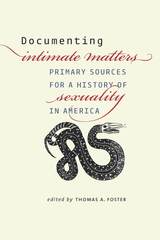 Documenting Intimate Matters: Primary Sources for a History of Sexuality in America
Edited by Thomas A. Foster
University of Chicago Press, 2012 Over time, sexuality in America has changed dramatically. Frequently redefined and often subject to different systems of regulation, it has been used as a means of control; it has been a way to understand ourselves and others; and it has been at the center of fierce political storms, including some of the most crucial changes in civil rights in the last decade. Edited by Thomas A. Foster, Documenting Intimate Matters features seventy-two documents that collectively highlight the broad diversity inherent in the history of American sexuality. Complementing the third edition of Intimate Matters, by John D’Emilio and Estelle B. Freedman—often hailed as the definitive survey of sexual history in America—the multiple narratives presented by these documents reveal the complexity of this subject in US history. The historical moments captured in this volume will show that, contrary to popular misconception, the history of sexuality is not a simple story of increased freedoms and sexual liberation, but an ongoing struggle between change and continuity.
 Documenting Iran: Filmmakers, Social Change, and the State
Persheng Vaziri
University of Texas Press, 2026 An ethnographic study of how Iranian documentary filmmakers navigate censorship and creativity to shape civic discourse. Iranian filmmakers have overcome significant obstacles to create a distinctive, globally renowned cinema. Filmmaker and educator Persheng Vaziri explores how documentarians, in particular, have developed a dynamic and creative environment by negotiating limited resources and official constraints. Through their films, they share hard truths—and artful narratives—with fellow Iranians and viewers the world over. Documenting Iran introduces key historical foundations of documentary filmmaking amid generations of political change—first under the shah and later the Islamic government—before turning to the experiences of contemporary directors and writers. Drawing on interviews and ethnographic encounters, Vaziri describes the creative practices and pragmatic choices that provide documentarians relative independence from state censorship and other curbs on artistic production. Relying on poetic aesthetics, international connections, and the accumulated knowledge of a tight-knit local community, filmmakers engage with controversial topics like women’s rights, marriage and divorce laws, environmental degradation, and encounters with Western culture. Documentarians have thus created an activist cinema both subtle and persuasive enough to challenge dogmatic rule and uphold progressive elements of Iranian society.
Documenting Israel
Charles Berlin
Harvard University Press This volume contains the proceedings of an international conference held at the Harvard Library on May 10-12, 1993 to focus attention on the documentation of Jewish life and culture in the State of Israel, the needs of scholars doing research on Israel, the role of the research library in making the needed documentation available to researchers, and the contribution of the Harvard Library to that effort.
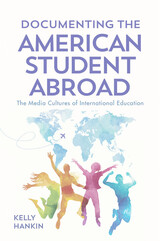 Documenting the American Student Abroad: The Media Cultures of International Education
Kelly Hankin
Rutgers University Press, 2021 1 in 10 undergraduates in the US will study abroad. Extoled by students as personally transformative and celebrated in academia for fostering cross-cultural understanding, study abroad is also promoted by the US government as a form of cultural diplomacy and a bridge to future participation in the global marketplace.
In Documenting the American Student Abroad, Kelly Hankin explores the documentary media cultures that shape these beliefs, drawing our attention to the broad range of stakeholders and documentary modes involved in defining the core values and practices of study abroad. From study abroad video contests and a F.B.I. produced docudrama about student espionage to reality television inspired educational documentaries and docudramas about Amanda Knox, Hankin shows how the institutional values of "global citizenship," "intercultural communication," and "cultural immersion" emerge in contradictory ways through their representation.
By bringing study abroad and media studies into conversation with one another, Documenting the American Student Abroad: The Media Cultures of International Education offers a much needed humanist contribution to the field of international education, as well as a unique approach to the growing scholarship on the intersection of media and institutions. As study abroad practitioners and students increase their engagement with moving images and digital environments, the insights of media scholars are essential for helping the field understand how the mediation of study abroad rhetoric shapes rather than reflects the field's central institutional ideals
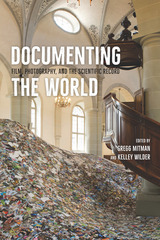 Documenting the World: Film, Photography, and the Scientific Record
Edited by Gregg Mitman and Kelley Wilder
University of Chicago Press, 2016 Imagine the twentieth century without photography and film. Its history would be absent of images that define historical moments and generations: the death camps of Auschwitz, the assassination of John F. Kennedy, the Apollo lunar landing. It would be a history, in other words, of just artists’ renderings and the spoken and written word. To inhabitants of the twenty-first century, deeply immersed in visual culture, such a history seems insubstantial, imprecise, and even, perhaps, unscientific.
Documenting the World is about the material and social life of photographs and film made in the scientific quest to document the world. Drawing on scholars from the fields of art history, visual anthropology, and science and technology studies, the chapters in this book explore how this documentation—from the initial recording of images, to their acquisition and storage, to their circulation—has altered our lives, our ways of knowing, our social and economic relationships, and even our surroundings. Far beyond mere illustration, photography and film have become an integral, transformative part of the world they seek to show us.
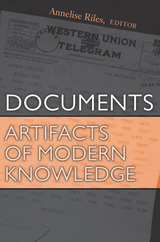 Documents: Artifacts of Modern Knowledge
Edited by Annelise Riles
University of Michigan Press, 2006 Documents reflects on the new challenges to humanistic social science in a world in which the subjects of research increasingly share the professional passions and problems of the researcher.
Documents are everywhere in modern life, from the sciences to bureaucracy to law; at the same time, fieldworkers document social realities by collecting, producing, and exchanging documents of their own. Capping off a generation of reflection and critique about the promises and pitfalls of ethnographic methods, the contributors explore how ethnographers conceive, grasp, appreciate, and see patterns, demonstrating that the core of the ethnographic method now lies in the way ethnographers respond to, and increasingly share the professional passions and problems of, their subjects.
"Sophisticated and provocative. The original and unique focus of this volume effectively opens up a new arena of critique that will move ethnography and qualitative inquiry forward in a way that few other works do."
—George Marcus, Department of Anthropology, Rice University
"This edited collection asks how an understanding of documentary forms sheds light on the creation and circulation of modern forms of knowledge, expertise, and governance. This is a major intervention in how we understand the everyday practice and techne of the documentary impulse and documentary apparatuses of law, bureaucratic review, and other institutions of modernity, as well as linguistic anthropology, literary theory, and law. The topic of Documents is not just of interest because of epistemological quandaries in the human sciences over textualization and interpretation, but also because the domains to which we increasingly turn our attention are themselves auto-documentary." —William M. Maurer, Chair and Associate Professor, Anthropology, University of California, Irvine Contributors: Mario Biagioli, Donald Brenneis, Carol Heimer, Hirokazu Miyazaki, Adam Reed, Annelise Riles, and Marilyn Strathern. Annelise Riles is Professor of Law and Anthropology at Cornell University.
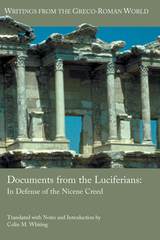 Documents from the Luciferians: In Defense of the Nicene Creed
Colin M. Whiting
SBL Press, 2019 Six important documents for scholars of early church history
This volume includes English translations of several documents concerning the Luciferians, a group of fourth-century Christians whose name derives from the bishop Lucifer of Cagliari. Documents include a confession of faith written for Emperor Theodosius I and a theological treatise written for his wife by Luciferian clergyman Faustinus, the first English translation of a Luciferian petition to Theodosius that focuses on the persecution the community has suffered, Theodosius’s imperial law in response to the Luciferians, two letters composed by Luciferians that purport to represent correspondence from the bishop Athanasius of Alexandria to Lucifer, and the priest Jerome’s Dialogus adversus Luciferianos. These texts highlight connections between developments in Christian theology and local Christian communities in the course of the fourth century.
Features:
- The first English translation of Faustinus’s Libellus precum
- An overview of the development of late antique theology and Christianity
- An introduction to Luciferian beliefs and the translated texts
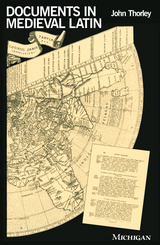 Documents in Medieval Latin
John Thorley
University of Michigan Press, 1998 This handbook of medieval Latin texts is designed for historians of the Middle Ages with some knowledge of Latin who wish to be able to read a wide range of original source material. It broadens the traditional scope of medieval Latin readers by including historical documents such as deeds and charters along with traditional literary samples. Within the context of a running narrative, Thorley starts with texts from the Anglo-Saxon period and then moves through subsequent centuries genre by genre. Each text is accompanied by a grammatical and historical commentary, both of which allow for independent study. In addition, all selections are translated at the back of the book.
Documents in Medieval Latin will be useful to students of medieval history, literature, and philosophy and those interested in reading more about the Middle Ages. Thorley's cheerful approach, the lively and representative selections of tests, and the documentary and epigraphic focus will prove valuable for those wishing to explore these vital original sources.
John Thorley teaches medieval Latin at Lancaster University.
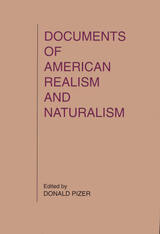 Documents of American Realism and Naturalism
Donald Pizer
Southern Illinois University Press, 1998
Donald Pizer presents the major critical discussions of American realism and naturalism from the beginnings of the movement in the 1870s to the present. He includes the most often cited discussions ranging from William Dean Howells, Henry James, and Frank Norris in the late nineteenth century to those by V. L. Parrington, Malcolm Cowley, and Lionel Trilling in the early twentieth century. To provide the full context for the effort to interpret the nature and significance of realism and naturalism during the periods when the movements were live issues on the critical scene, however, he also includes many uncollected essays. His selections since World War II reflect the major recent tendencies in academic criticism of the movements.
Through introductions to each of the three sections, Pizer provides background, delineating the underlying issues motivating attempts to attack, defend, or describe American realism and naturalism. In particular, Pizer attempts to reveal the close ties between criticism of the two movements and significant cultural concerns of the period in which the criticism appeared. Before each selection, Pizer provides a brief biographical note and establishes the cultural milieu in which the essay was originally published. He closes his anthology with a bibliography of twentieth-century academic criticism of American realism and naturalism.
The Documents of Angelo de Cartura and Donato Fontanella: Venetian Notaries in Fourteenth-Century Crete
Alan M. Stahl
Harvard University Press, 2000 This volume, which includes the texts in Latin with an English preface and extensive indices, contains the text of two notarial protocols in the Notai di Candia series of the Archivio di Stato di Venezia. Both notaries were active in the town of Candia, modern Herakleion, in the Venetian colony of Crete in the early fourteenth century.Though the two protocols published here are fragmentary in terms of their survival, and selective in the aspects of life that they record, they are both valuable sources for understanding the lives of Venetian, Greek, and Jewish men and women in fourteenth-century Crete.
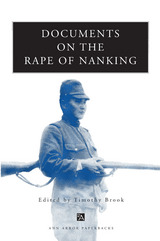 Documents on the Rape of Nanking
Timothy Brook, Editor
University of Michigan Press, 1999 The Japanese Army's invasion of China in 1937 was the first step toward a hemispheric war that would last until the atomic bombing of Hiroshima and Nagasaki in 1945. What ended in one atrocity began with another: the savage military takeover of China's capital city, which quickly became known as the Rape of Nanking. The Japanese Army's conduct from December 1937 to February 1938 constitutes one of the most barbarous events not just of the war but of the century. The violence was documented at the time and then redocumented during the war crimes trial in Tokyo after the war. This book brings together materials from both moments to provide the first comprehensive dossier of primary sources on the Rape.
Part 1, "The Records," includes two sources written as the Rape was underway. The first is a long set of documents produced by the International Committee for the Nanking Safety Zone, a group of foreigners who strove to protect the Chinese residents. The second is a series of letters that American surgeon Dr. Robert Wilson wrote for his family during the same period. These letters are published here for the first time.
The evidence compiled by the International Committee and its members would be decisive for the indictments against Japanese leaders at the International Military Tribunal for the Far East in Tokyo. Part 2, "The Judgments," reprints portions of the tribunal's 1948 judgment dealing with the Rape of Nanking, its judicial consequences, and sections of the dissenting judgment of Justice Radhabinod Pal.
These contemporary records and judgments create an intimate firsthand account of the Rape of Nanking. Together they are intended to stimulate deeper reflection than previously possible on how and why we assess and assign the burden of war guilt.
Timothy Brook is Professor of Chinese History and Associate Director of the Joint Centre for Asia Pacific Studies, University of Toronto, and is coeditor of Nation Work: Asian Elites and National Identities and Cultureand Economy: The Shaping of Capitalism in Eastern Asia, both published by the University of Michigan Press.
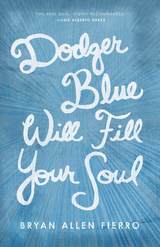 Dodger Blue Will Fill Your Soul
Bryan Allen Fierro
University of Arizona Press, 2016 Two brothers bury a statue of Saint Jude for their grieving nana. A Griffith Park astronomer makes his own discovery at an East L.A. wedding. A young man springs his Cherokee-obsessed grandfather from the confines of senility. The common thread? Each is weaving their way through the challenging field of play that is living and loving in Los Angeles.
In Dodger Blue Will Fill Your Soul, Bryan Allen Fierro brings to life the people and places that form the fragile heart of the East Los Angeles community. In the title story, a father’s love of Dodger baseball is matched only by the disconnect he must bridge with his young son. In another story, a young widower remembers his wedding day with his father-in-law. The boys and men in this collection challenge masculine stereotypes, while the girls and women defy gender roles. Hope and faith in their own community defines the characters, and propels them toward an awareness of their own personal responsibility to themselves and to their families, even as they eschew those closest to them in pursuit of a different future.
Dodger Blue Will Fill Your Soul is a tour de force—the first collection of an authentic new voice examining community with humor, hope, and brutal honesty.
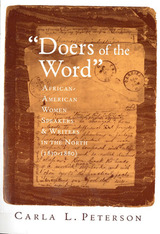 "Doers of the Word": African-American Women Speakers and Writers in the North (1830-1880)
Peterson, Carla L
Rutgers University Press, 1998 Adapting a verse from the Epistle of James —"doers of the word"— nineteenth-century black women activists Sojourner Truth, Jarena Lee, and Frances Ellen Watkins Harper, among others, travelled throughout the Northeastern, Mid-Atlantic, and Midwestern regions of the United States. They preached, lectured, and wrote on issues of religious evangelicism, abolition, racial uplift, moral reform, temperance, and women's rights, thereby defining themselves as public intellectuals.
In situating these women within the emerging African-American urban communities of the free North, Doers of the Word provides an important counterweight to the vast scholarship on Southern slavery and argues that black "Civil Rights movements" cannot be seen as a purely modern phenomenon. In particular, the book examines the ways in which this Northern black population, despite its heterogeneity, came together and established social organizations that would facilitate community empowerment; yet Peterson's analysis also acknowledges, and seeks to explain, the highly complex relationship of black women to these institutions, a relationship that rendered their stance as public intellectuals all the more bold and defiant.
Peterson begins her study in the 1830s, when a substantial body of oratory and writing by black women first emerged, and traces the development of this writing through the shifting political climate up to the end of Reconstruction. She builds her analyses upon Foucault's interdisciplinary model of discourse with an explicitly feminist approach, drawing upon sermons, spiritual autobiographies, travel and slave narratives, journalism, essays, poetry, speeches, and fiction. From these, Peterson is able to answer several key questions. First, what empowered these women to act, to speak out, and to write? Why, and in what ways, were they marginalized within both the African-American and larger American communities? Where did they act, speak, and write from?
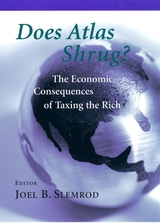 Does Atlas Shrug?: The Economic Consequences of Taxing the Rich
Joel B. Slemrod
Harvard University Press, 2000 Since the introduction of the income tax in 1913, controversy has raged about how heavily to tax the rich. Opponents of high tax rates claim that heavy assessments have negative incentives on the productivity of some of our most talented citizens; supporters stress the importance of the rich shouldering their "fair share," and decry the loopholes that permit many to escape their obligations. Notably absent from this debate is hard evidence about the actual impact of taxes on the behavior of the affluent.
This book presents evidence by leading economists of the effects of taxes on the formation of businesses, the supply of labor, the form of executive compensation, the accumulation of wealth, the allocation of portfolios, and the realization of capital gains. Among its findings are that the labor supply of the rich remained unchanged in the face of large tax cuts in 1986, and that in late 1992 executives exercised billions of dollars' worth of stock options in order to beat the tax increases expected in 1993. The book also presents a history of efforts to tax the rich, a demographic snapshot of the financially affluent, and a road map to widely used tax-avoidance strategies.
Does Atlas Shrug? will be of great interest to policymakers and interested citizens who want to know how much tax revenue could really be gained by increasing tax rates on the rich, or whether low capital gains tax rates really spur economic growth.
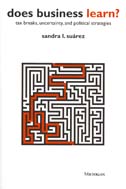 Does Business Learn?: Tax Breaks, Uncertainty, and Political Strategies
Sandra L. Suarez
University of Michigan Press, 2000 Firms in the United States have many political advantages when compared to other groups in society. They are the best-represented group in our nation's capital; they operate more Political Action Committees; and their lobbyists are among the most experienced political operatives. Yet firms are uncertain about their political power and hence about the effectiveness of their political strategies. This book deals with how firms decide which strategy to pursue among the existing alternatives when it comes to defending policies that play to their interests.
Sandra Suárez looks at the efforts of business to influence government policy in a detailed study of the efforts of major American corporations to protect the tax credit applicable to profits from investments in Puerto Rico. This rare longitudinal case-study explores the abilities of U.S. pharmaceutical and electronics companies to adapt their political strategies to a fluid and uncertain political environment. Drawing on interviews with tax lawyers, corporate lobbyists and government officials, the author follows the behavior of the same group of companies over the past twenty years.
This book advances a learning-based explanation of business political behavior, which argues that past political experience accounts for patterns of political behavior that government structures and salient issues alone cannot explain. Centered on attempts to protect an important tax break for business, the possessions tax battles provide an appropriate case for examining the value of the business learning approach.
Although written with a political science audience in mind, this book addresses issues that will resonate widely with sociologists, management researchers and students alike.
Sandra L. Suárez is Assistant Professor in the Department of Political Science, Temple University.
 Does Ethics Have a Chance in a World of Consumers?
Zygmunt Bauman
Harvard University Press, 2009 Zygmunt Bauman is one of the most admired social thinkers of our time. Once a Marxist sociologist, he has surrendered the narrowness of both Marxism and sociology, and dares to write in language that ordinary people can understand—about problems they feel ill equipped to solve. This book is no dry treatise but is instead what Bauman calls “a report from a battlefield,” part of the struggle to find new and adequate ways of thinking about the world in which we live. Rather than searching for solutions to what are perhaps the insoluble problems of the modern world, Bauman proposes that we reframe the way we think about these problems. In an era of routine travel, where most people circulate widely, the inherited beliefs that aid our thinking about the world have become an obstacle.
Bauman seeks to liberate us from the thinking that renders us hopeless in the face of our own domineering governments and threats from unknown forces abroad. He shows us we can give up belief in a hierarchical arrangement of states and powers. He challenges members of the “knowledge class” to overcome their estrangement from the rest of society. Gracefully, provocatively, Bauman urges us to think in new ways about a newly flexible, newly challenging modern world. As Bauman notes, quoting Vaclav Havel, “hope is not a prognostication.” It is, rather, alongside courage and will, a mundane, common weapon that is too seldom used.
Does Family Preservation Serve a Child's Best Interests?
Howard Altstein and Ruth G. McRoy
Georgetown University Press, 2000 In this new volume, two distinguished professors of social work debate the question of whether family preservation or adoption serves the best interests of abused and neglected children. Arguing the merits of keeping families together whenever possible, Ruth G. McRoy examines the background, theory, and effectiveness of family preservation programs. She provides practical recommendations and pays particular attention to the concerns of African American children. Claiming that there is insufficient evidence that family preservation actually works, Howard Altstein counters that children from truly dysfunctional families should be given the chance for stable lives through adoption rather than left in limbo.
Does God Suffer?
Thomas Weinandy, O.F.M.
University of Notre Dame Press, 2000 The immense suffering in the modern world, especially in the light of the Holocaust, has had a profound impact on the contemporary understanding of God and his relationship to human suffering. There has been a growing acceptance that God himself suffers in solidarity and love with those who suffer. Weinandy’s comprehensive presentation resolutely challenges this view of God and suffering, arguing from scripture and from the philosophical and theological tradition of the Fathers and Aquinas. He maintains that a God who is impassible is more loving and compassionate than a suffering God. He also argues that it is the Son of God’s experience of suffering as a man that is truly redemptive and life-giving.
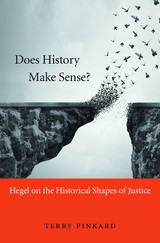 Does History Make Sense?: Hegel on the Historical Shapes of Justice
Terry Pinkard
Harvard University Press, 2017 Hegel’s philosophy of history—which most critics view as a theory of inevitable progress toward modern European civilization—is widely regarded as a failure today. In Does History Make Sense? Terry Pinkard argues that Hegel’s understanding of historical progress is not the kind of teleological or progressivist account that its detractors claim, but is based on a subtle understanding of human subjectivity.
Pinkard shows that for Hegel a break occurred between modernity and all that came before, when human beings found a new way to make sense of themselves as rational, self-aware creatures. In Hegel’s view of history, different types of sense-making become viable as social conditions change and new forms of subjectivity emerge. At the core of these changes are evolving conceptions of justice—of who has authority to rule over others. In modern Europe, Hegel believes, an unprecedented understanding of justice as freedom arose, based on the notion that every man should rule himself. Freedom is a more robust form of justice than previous conceptions, so progress has indeed been made. But justice, like health, requires constant effort to sustain and cannot ever be fully achieved.
For Hegel, philosophy and history are inseparable. Pinkard’s spirited defense of the Hegelian view of history will play a central role in contemporary reevaluations of the philosopher’s work.
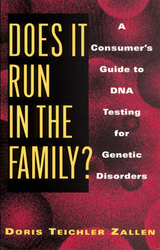 Does It Run in the Family?: A Consumer's Guide to DNA Testing for Genetic Disorders
Zallen, Dorris Teichler
Rutgers University Press, 1997 1999 Al Sturm Award for Excellence in Faculty Research of the Phi Beta Kappa chapter at Virginia Tech
What if your father had Alzheimer's disease? And what if there was a test to tell you if, as you grew older, you might develop it, too? Would you have the test? And if you did, how would the results affect the way you live your life? How would they affect your family? Your job? Your medical insurance? Breast cancer, sickle-cell anemia, Huntington disease, muscular dystrophy--every day, people have to face the fact that a hereditary disorder runs in their family. The painful knowledge that they or their children might be at risk for a genetic disorder influences all their decisions about the future. They ask, "Is there a genetic test to let us know if we are really at risk? If there is such a test, do we really want to have it done?" For an ever-growing number of disorders, testing is possible--but the existence of a test can raise new and troubling questions. In this book, geneticist and science policy expert Doris Teichler Zallen explains clearly and sympathetically how genetic disorders are passed along in families; which hereditary disorders can be tested for using genetic technology; how the new DNA tests for genetic disorders work; what genetic tests can and can't reveal, and why the tests often do not give clear-cut answers; what questions one should ask doctors and genetic counselors; how the health care system, government policies, and insurance companies influence our options; and what the resources are for obtaining more information and counseling. Through the stories of real families and the choices they made about genetic testing, Zallen helps readers think through their own alternatives and discuss them with relatives. Does it Run in the Family? is essential reading for every family coping with inherited medical conditions and for the medical and genetics professionals involved in their decisions. It will also interest all readers who seek a clear explanation of the new DNA tests and the issues surrounding them.
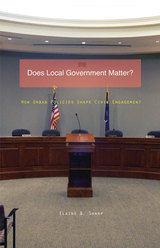 Does Local Government Matter?: How Urban Policies Shape Civic Engagement
Elaine B. Sharp
University of Minnesota Press, 2012 Until recently, policy evaluation has mostly meant assessing whether government programs raise reading levels, decrease teen pregnancy rates, improve air quality levels, lower drunk-driving rates, or achieve any of the other goals that government programs are ostensibly created to do. Whether or not such programs also have consequences with respect to future demands for government action and whether government programs can heighten—or dampen—citizen involvement in civic activities are questions that are typically overlooked. This book applies such questions to local government. Employing policy feedback theory to a series of local government programs, Elaine B. Sharp shows that these programs do have consequences with respect to citizens’ political participation. Unlike other feedback theory investigations, which tend to focus on federal government programs, Sharp’s looks at a broad range of policy at the local level, including community policing programs, economic development for businesses, and neighborhood empowerment programs. With this clear-eyed analysis, Sharp finds that local governments’ social program activities actually dampen participation of the have-nots, while cities’ development programs reinforce the political involvement of already-privileged business interests. Meanwhile, iconic urban programs such as community policing and broader programs of neighborhood empowerment fail to enhance civic engagement or build social capital at the neighborhood level; at worst, they have the potential to deepen divisions—especially racial divisions—that undercut urban neighborhoods.
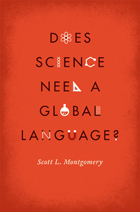 Does Science Need a Global Language?: English and the Future of Research
Scott L. Montgomery
University of Chicago Press, 2013 In early 2012, the global scientific community erupted with news that the elusive Higgs boson had likely been found, providing potent validation for the Standard Model of how the universe works. Scientists from more than one hundred countries contributed to this discovery—proving, beyond any doubt, that a new era in science had arrived, an era of multinationalism and cooperative reach. Globalization, the Internet, and digital technology all play a role in making this new era possible, but something more fundamental is also at work. In all scientific endeavors lies the ancient drive for sharing ideas and knowledge, and now this can be accomplished in a single tongue— English. But is this a good thing?
In Does Science Need a Global Language?, Scott L. Montgomery seeks to answer this question by investigating the phenomenon of global English in science, how and why it came about, the forms in which it appears, what advantages and disadvantages it brings, and what its future might be. He also examines the consequences of a global tongue, considering especially emerging and developing nations, where research is still at a relatively early stage and English is not yet firmly established.
Throughout the book, he includes important insights from a broad range of perspectives in linguistics, history, education, geopolitics, and more. Each chapter includes striking and revealing anecdotes from the front-line experiences of today’s scientists, some of whom have struggled with the reality of global scientific English. He explores topics such as student mobility, publication trends, world Englishes, language endangerment, and second language learning, among many others. What he uncovers will challenge readers to rethink their assumptions about the direction of contemporary science, as well as its future.
Does That Make Sense?: The Best of Joe Blundo
Joe Blundo
Ohio State University Press, 2019 Joe Blundo began his writing career at the Columbus Dispatch in 1978 and has been writing about Columbus ever since. In 1997, Joe was given his own column titled “So to Speak,” which quickly became one of the most popular sections of the paper. Raccoon dinners, Abe Lincoln impersonators, and things in nature that aren’t fair are just a few of the topics Blundo explores in this collection of the best of his newspaper columns. The columns range from hilarious to poignant to indignant—but all contain his unique voice and somewhat tilted way of looking at life. He’s especially drawn to the quirks that make Columbus what it is, people with a passion they can’t stop talking about, and recording the milestones in his family’s life. Sometimes he spouts off on the big issues of the day but more often he looks for the little things that others might not notice.
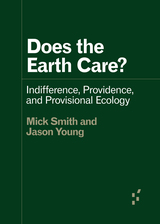 Does the Earth Care?: Indifference, Providence, and Provisional Ecology
Mick Smith
University of Minnesota Press, 2022 Rethinking our relationship with Earth in a time of environmental emergency
The world is changing. Progress no longer has a future but any earlier sense of Earth as “providential” seems of merely historical interest. The apparent absence of Earthly solicitude is a symptom and consequence of these successive Western modes of engagement with the Earth, now exemplified in global capitalism. Within these constructs, Earth can only appear as constitutively indifferent to the fate of all its inhabitants. The “provisional ecology” outlined in Does the Earth Care?—drawing on a variety of literary and philosophical sources from Richard Jefferies and Robert Macfarlane to Martin Heidegger and Gaia theory—fundamentally challenges that assumption, while offering an Earthly alternative to either cold realism or alienated despair in the face of impending ecological disaster.
Forerunners is a thought-in-process series of breakthrough digital works. Written between fresh ideas and finished books, Forerunners draws on scholarly work initiated in notable blogs, social media, conference plenaries, journal articles, and the synergy of academic exchange. This is gray literature publishing: where intense thinking, change, and speculation take place in scholarship.
Does the U.S. No-Concessions Policy Deter Kidnappings of Americans?
Brian Michael Jenkins
RAND Corporation, 2018 This paper looks at the history of kidnapping over the past 45 years to examine whether the U.S. policy of not paying ransom to terrorists holding Americans hostage is an effective deterrent. Earlier research found little empirical evidence to support the assertion. More-recent research also casts doubt on the deterrence value, although one study says that U.S. ransom payments would have prompted more kidnappings.
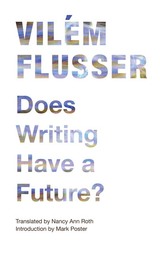 Does Writing Have a Future?
Vilém Flusser
University of Minnesota Press, 2010 In Does Writing Have a Future?, a remarkably perceptive work first published in German in 1987, Vilém Flusser asks what will happen to thought and communication as written communication gives way, inevitably, to digital expression. In his introduction, Flusser proposes that writing does not, in fact, have a future because everything that is now conveyed in writing—and much that cannot be—can be recorded and transmitted by other means.
Confirming Flusser’s status as a theorist of new media in the same rank as Marshall McLuhan, Jean Baudrillard, Paul Virilio, and Friedrich Kittler, the balance of this book teases out the nuances of these developments. To find a common denominator among texts and practices that span millennia, Flusser looks back to the earliest forms of writing and forward to the digitization of texts now under way. For Flusser, writing—despite its limitations when compared to digital media—underpins historical consciousness, the concept of progress, and the nature of critical inquiry. While the text as a cultural form may ultimately become superfluous, he argues, the art of writing will not so much disappear but rather evolve into new kinds of thought and expression.
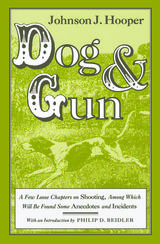 Dog and Gun: A Few Loose Chapters on Shooting, Among Which Will Be Found Some Anecdotes and Incidents
Johnson J. Hooper, with an Introduction by Philip D. Beidler
University of Alabama Press, 1992 The least well known of Johnson Jones Hooper’s works, Dog and Gun was first published as a newspaper series, then appeared in six book editions between 1856 and 1871. Hooper is Alabama’s most celebrated antebellum author, and here he gives insight into the meaning of a culture where every male hunts – and a man who shoots as a gentleman will be assumed a gentleman. Beidler’s introduction to this reprint edition explores the social, literary, and technical dimensions of Dog and Gun, which he sees as an important commentary on class distinctions in the antebellum South, as well as a straightforward treatise on hunting. Although the book is a manual for the hunter, with characteristic humor and a certain disdain, Hooper gives a full picture of the gentlemanly sport of hunting – clearly distinct from hunting for food – in all aspects including hunter, weaponry, and sporting dogs. He takes us back to an autumnal ritual of the hunt, where one is always a boy with his first gun – to the natural mystery of quest, competition, predation, pursuit, survival, bravery, endurance, and eventual defeat, called the mystery of the hunt.
Dog Angel: Poems
Jesse Lee Kercheval
University of Pittsburgh Press, 2024 Full of wit, vivid language, and devastating honesty, these poems trace the timelines of Kercheval’s life forward and backward, offering a moving examination of the connections that bind us together into families and communities.
Dog Eat Dog: A Novel
Niq Mhlongo
Ohio University Press, 2012 Dog Eat Dog is a remarkable record of being young in a nation undergoing tremendous turmoil, and provides a glimpse into South Africa’s pivotal kwaito (South African hip-hop) generation and life in Soweto. Set in 1994, just as South Africa is making its postapartheid transition, Dog Eat Dog captures the hopes—and crushing disappointments—that characterize such moments in a nation’s history. Raucous and darkly humorous, Dog Eat Dog is narrated by Dingamanzi Makhedama Njomane, a college student in South Africa who spends his days partying, skipping class, and picking up girls. But Dingz, as he is known to his friends, is living in charged times, and his discouraging college life plays out against the backdrop of South Africa’s first democratic elections, the spread of AIDS, and financial difficulties that threaten to force him out of school.
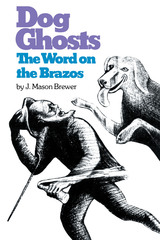 Dog Ghosts and The Word on the Brazos: Negro Preacher Tales from the Brazos Bottoms of Texas
By J. Mason Brewer
University of Texas Press, 1976 This book contains two volumes of African American folk tales collected by J. Mason Brewer. The stories included in Dog Ghosts are as varied as the Texas landscape, as full of contrasts as Texas weather. Among them are tales that have their roots deeply imbedded in African, Irish, and Welsh mythology; others have parallels in pre-Columbian Mexican tradition, and a few have versions that can be traced back to Chaucer's England. All make delightful reading. The title Dog Ghosts is drawn from the unique stories of dog spirits which Dr. Brewer collected in the Red River bottoms and elsewhere in Texas. The Word on the Brazos is a delightful collection of "preacher tales" from the Brazos River bottom in Texas. J. Mason Brewer worked side by side with field hands in the Brazos bottoms; he lived in their homes, worshipped in their churches, and shared the moments of relaxation in which laughter held full sway. Many of the tales these people told were related to religion—both "good religion" and "bad religion." Some of them concerned preachers and their families, while others were stories told in pulpits. Mr. Brewer has set all of these stories down in authentic yet easily readable dialect. They will delight all who are interested in the historic culture of rural African-American Texans, as well as those who simply enjoy fine humorous stories skillfully told.
|
|
